






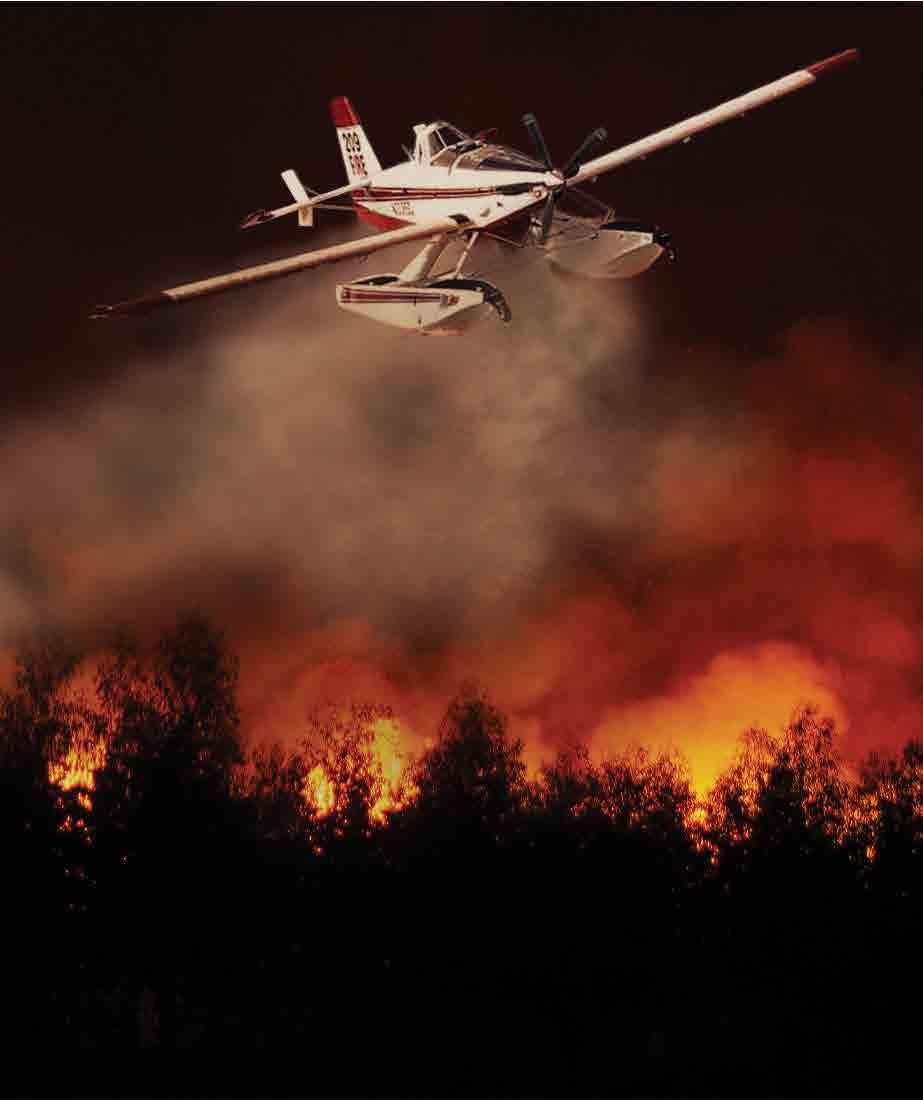

























For sixty years, PHOS-CHEK® fire retardants and firefighting foam concentrates have helped the firefighting community operate effectively when they risk their lives saving our forests, our communities and our lives.



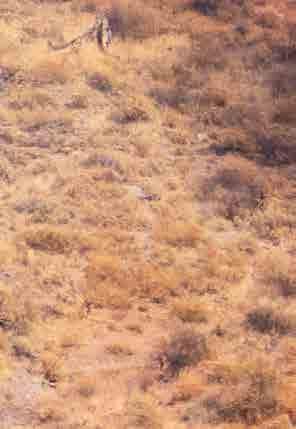










At Perimeter Solutions, we’re celebrating the 60th anniversary of PHOS-CHEK. We’re grateful for our partnership with the firefighting community, and appreciate the work they do to keep our communities safe. Through new product innovation and on-theground support, our team will always have their back.
It’s been a great journey. And we look forward to the next sixty years!

P.O. Box 850 • Perry, GA 31069 USA 475 Myrtle Field Rd. • Perry, GA 31069 USA
PHONE: 478-987-2250
FAX: 478-352-0025
info@marsaylmedia.com • aerialfiremag.com
AERIALFIRE IS PUBLISHED BY
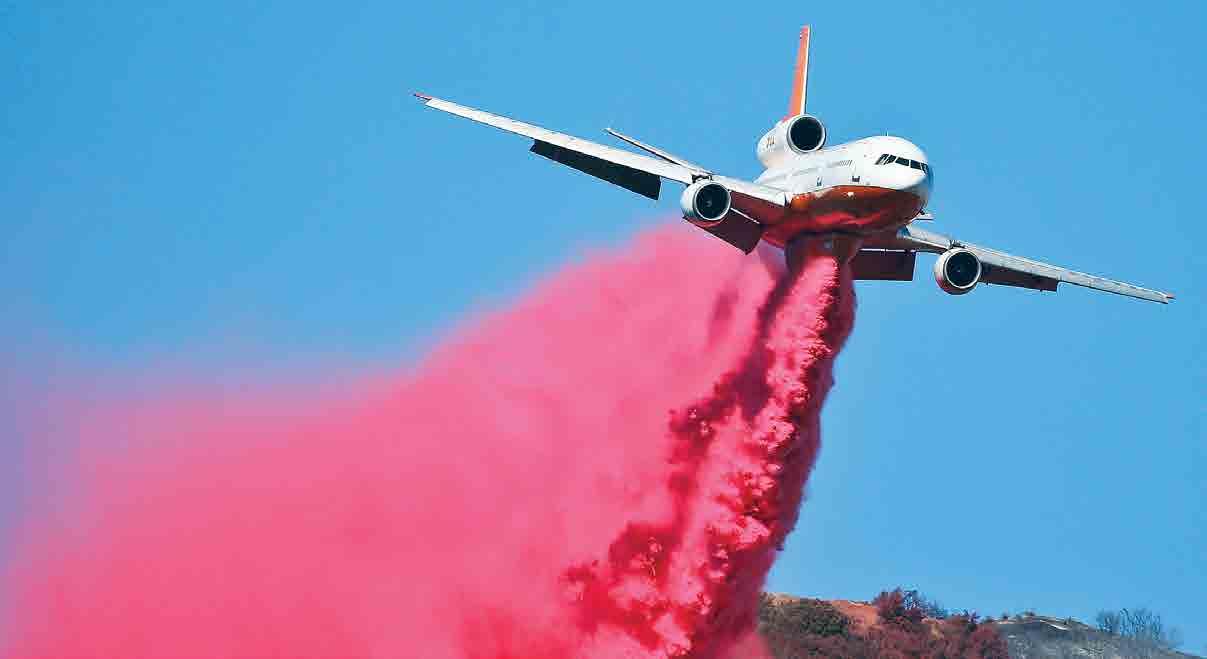
PUBLISHER:
Graham Lavender - graham@marsaylmedia.com
EDITOR IN CHIEF:
Ryan Mason - ryan@marsaylmedia.com

ACCOUNTING/ADMINISTRATION:
Casey Armstrong - casey@marsaylmedia.com
DISPLAY ADVERTISING:
Melanie Woodley - melanie@marsaylmedia.com
PRODUCTION:
Daniela Constantino - daniela@marsaylmedia.com
CIRCULATION:
Mary Jane Virden - maryjane@marsaylmedia.com
© Copyright 2023 AerialFire retains all rights for reproduction of any material submitted, to include but not limited to articles, photographs, emails and bulletin board posts. All material remain the copyright of AerialFire. No part of this publication may be reproduced, in part or whole, without the written consent of the publisher. Editorial published do not necessary reflect the views of the publisher. Content within AerialFire is believed to be true and accurate and the publisher does not assume responsibility for any errors or omissions. Unsolicited editorial manuscripts and photos are welcomed and encouraged. We cannot be responsible for return unless submissions are accompanied by a stamped, self-addressed envelope. Advertising deadline is 12 noon, on the 1st of the month preceding the month of publication.
AerialFire (ISSN 1081-6496) Published
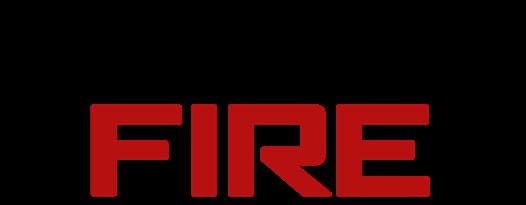
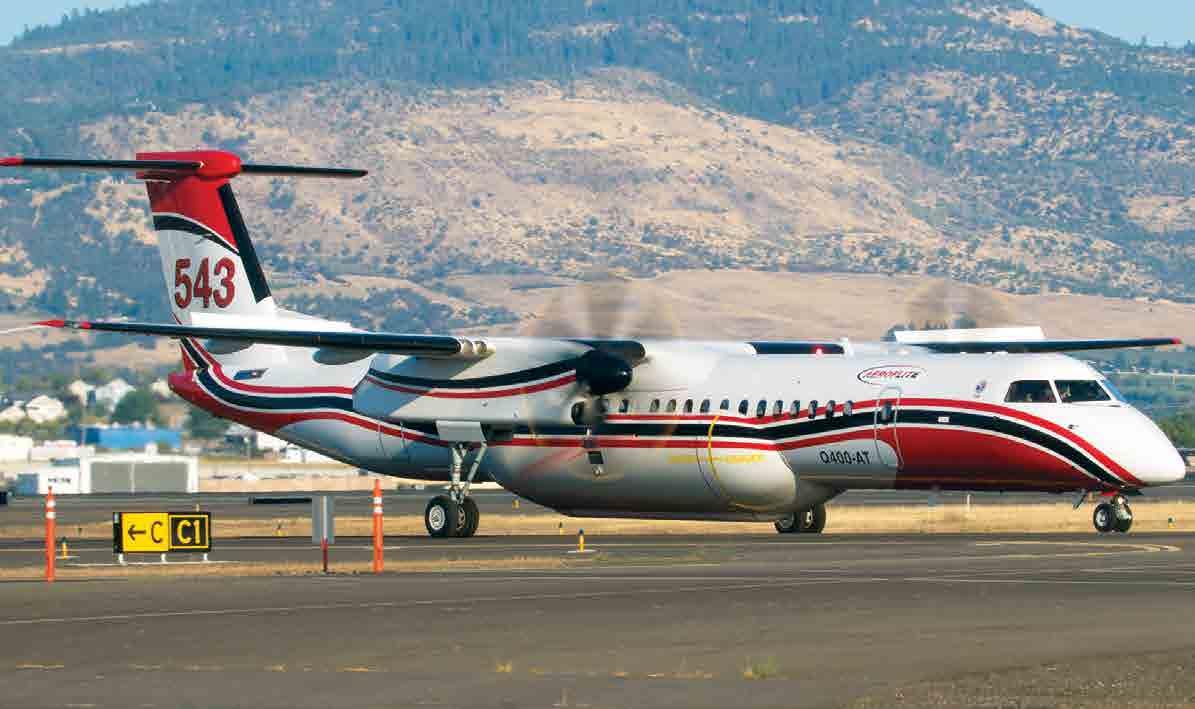
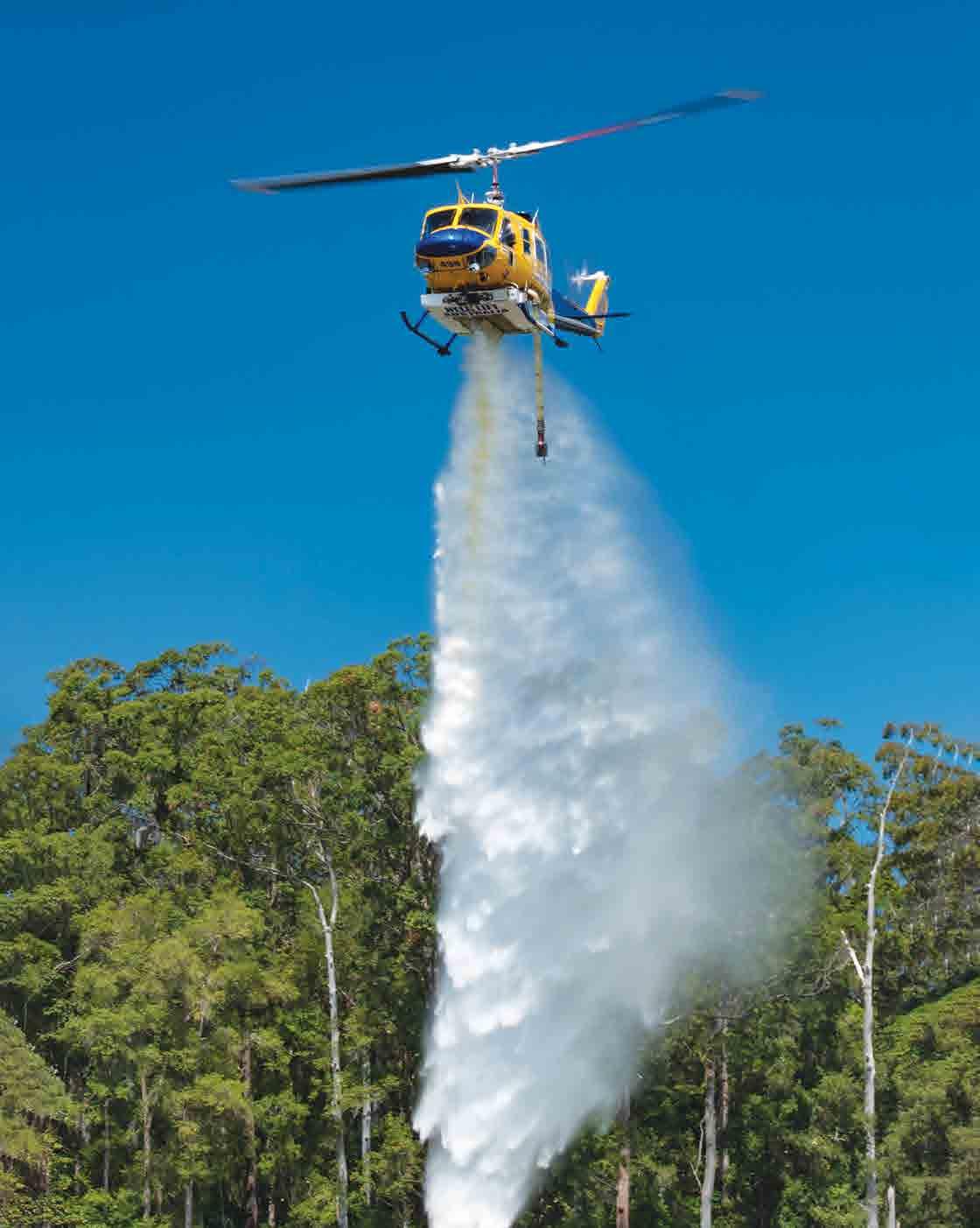
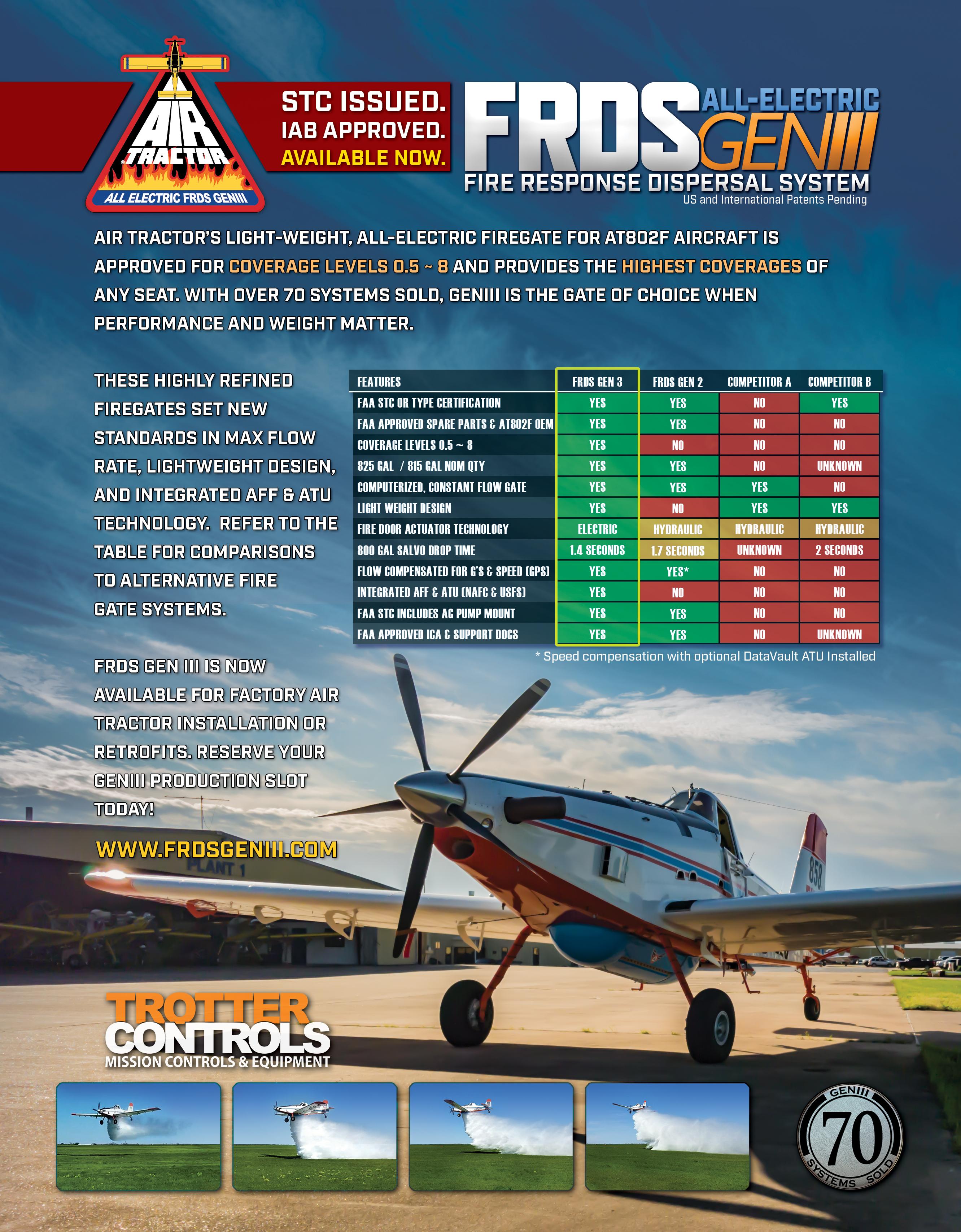 Ryan Mason ryan@aerialfiremag.com
Ryan Mason ryan@aerialfiremag.com
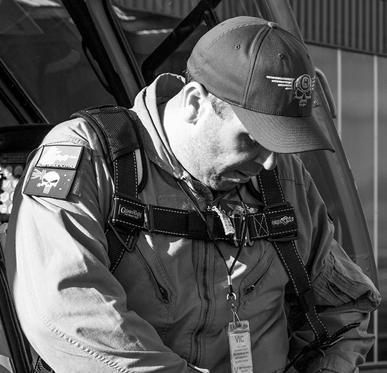
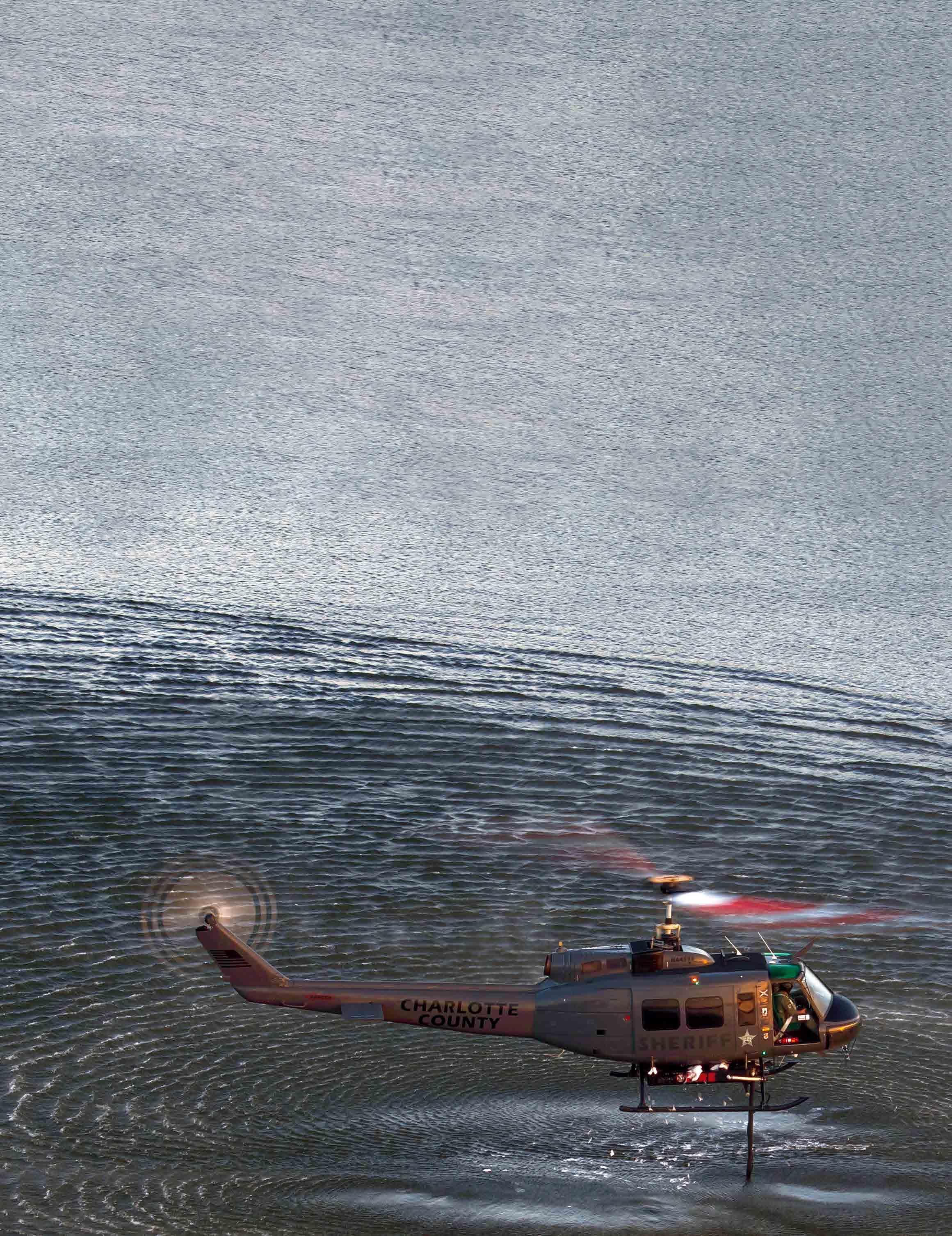
Life is short. It’s a simple yet powerful reminder that often gets lost in the hustle and bustle of daily life. We all have goals and aspirations, and it’s easy to get caught up in pursuing success and forget the things that truly matter. That recently hit home for me with the passing
of Bill Gabbert. I spoke to him on the phone about two weeks before his passing. Knowing that his time was short, he told me to make sure that I made the most of my kids and family and not to work so hard at succeeding that I forgot to have fun.
One of the most important aspects of living a fulfilling life is balancing all aspects that take time, work, family, friends and personal well-being. Unfortunately, many of us fall into the trap of working too much and neglecting these other important areas; I know I am guilty of that on occasion, especially leading up to a magazine release week when there doesn’t seem to be enough hours in the day to get everything done.
The phrase “work to live, not live to work” reminds us that our jobs are not the end-all-be-all of our existence. Work is important, and we must provide for ourselves and our families. Still, it should not consume our lives. We should strive to find a balance that allows us to enjoy our work while also making time for the people and activities that bring us joy and fulfillment.
It’s easy to get caught up in the rat race of life, especially during peak fire season when it’s a big season. Between pre-flight, incident briefings, flying, fueling and all of the other daily tasks on a fireground, you can quickly burn more hours than planned, sometimes it is avoidable, and sometimes it isn’t. We accept that as reality, however, we all have a finite amount of time on this earth, and it’s important to use our time wisely. We should strive to find a balance between work and the other essential aspects of our lives to make the most of our time.

It’s also important to remember that a work-life balance doesn’t mean sacrificing career goals, aspirations, or safety. Instead, it’s about finding a balance that allows us to pursue our goals and aspirations while also making time for the things that matter most to us, most importantly, returning safely home at the end of each night. This might mean re-evaluating our goals and priorities from time to time and finding ways to keep that work/life balance achieved.
In summary, every life has an expiry date, so it’s important to remember that our jobs are not the most important thing in our lives. We should strive to find a balance between work and the other aspects of our lives to make the most of our time. While we all enjoy our time in this industry, if we are lucky enough to make it to retirement age, work becomes a thing of the past to look back on fondly, but your family will be there forever. Remember to work to live, don’t live to work.

Fly safe,





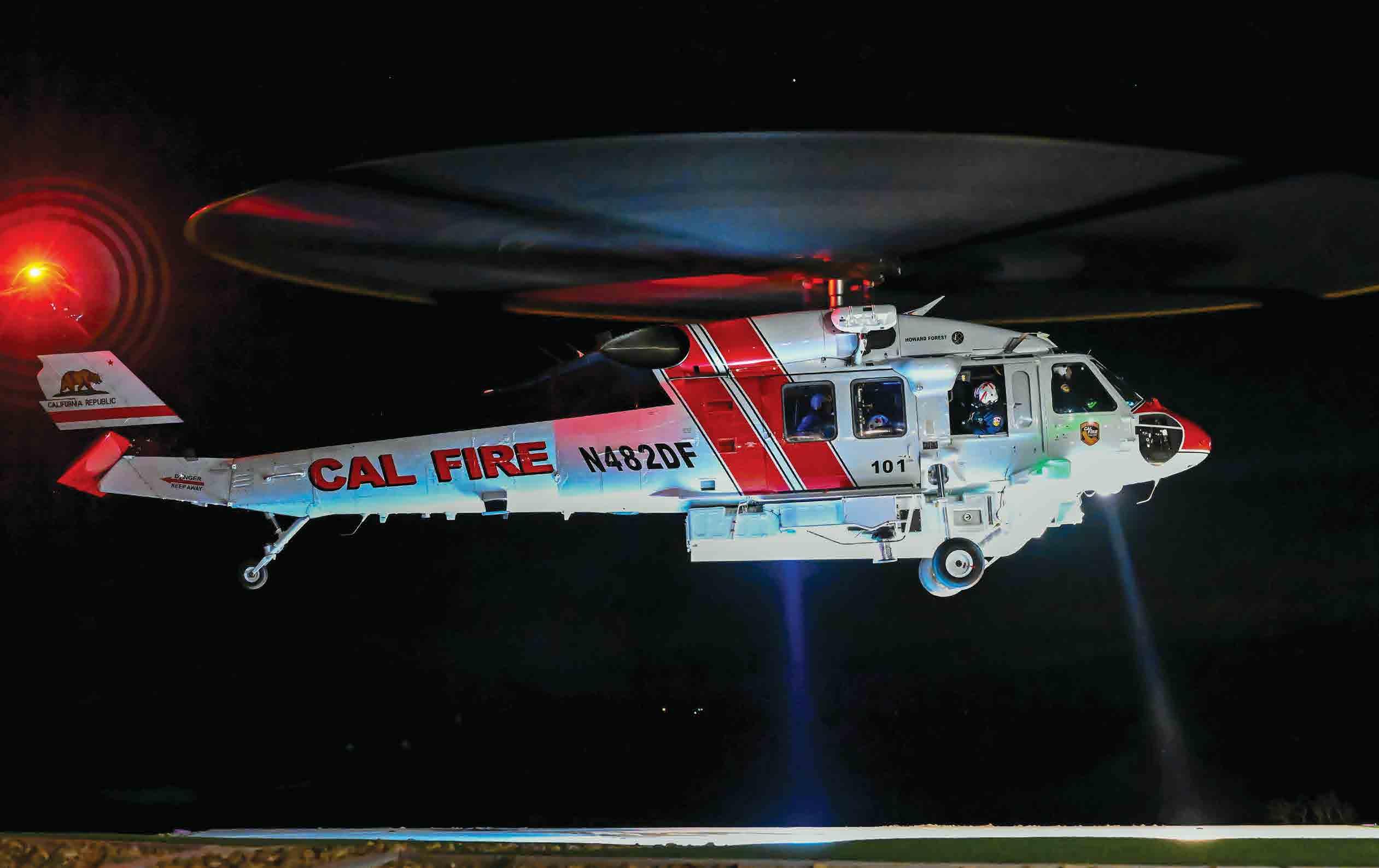 Microflite’s AS350 and Kestrel’s Blackhawk await a mission at Ballarat, Victoria.
Photo by Dave Soderstrom.
CAL FIRE’s Vina Helitack crew conduct NVG training on 1/17/23. Photo by Maureen Bonessa.
Microflite’s AS350 and Kestrel’s Blackhawk await a mission at Ballarat, Victoria.
Photo by Dave Soderstrom.
CAL FIRE’s Vina Helitack crew conduct NVG training on 1/17/23. Photo by Maureen Bonessa.

 Neptune’s Tanker 40 begins laying a line of retardant. Photo by John Hall.
A Spanish Super Scooper comes in for a load. Photo by Fernando Rodriguez Cubero.
Neptune’s Tanker 40 begins laying a line of retardant. Photo by John Hall.
A Spanish Super Scooper comes in for a load. Photo by Fernando Rodriguez Cubero.

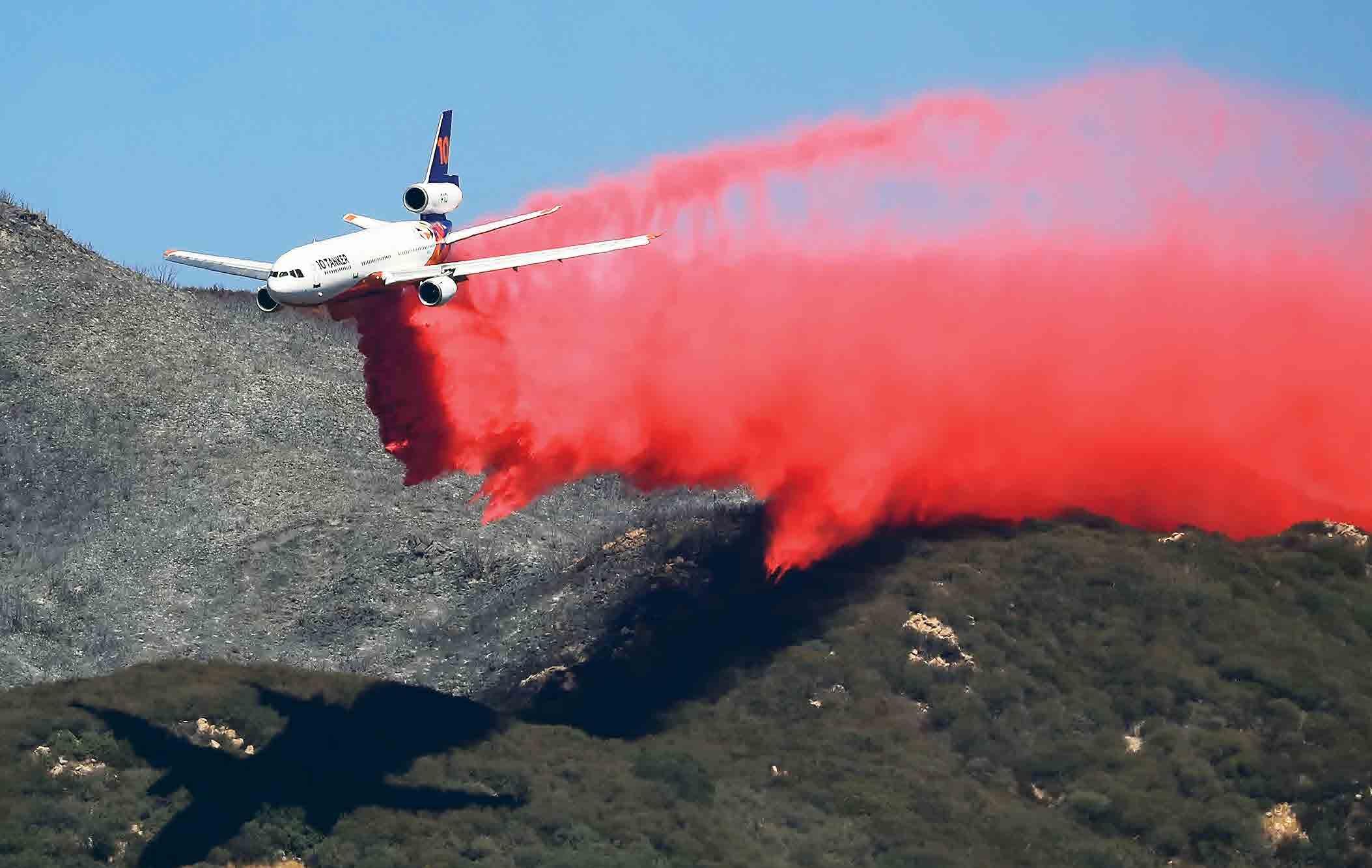 An Erickson Aero Tanker drops a line of retardant outside of San Diego. Photo by Ryan Grothe.
10 Tanker 910 lays a line of retardant in California.
Photo by Jeff Serpa.
An Erickson Aero Tanker drops a line of retardant outside of San Diego. Photo by Ryan Grothe.
10 Tanker 910 lays a line of retardant in California.
Photo by Jeff Serpa.
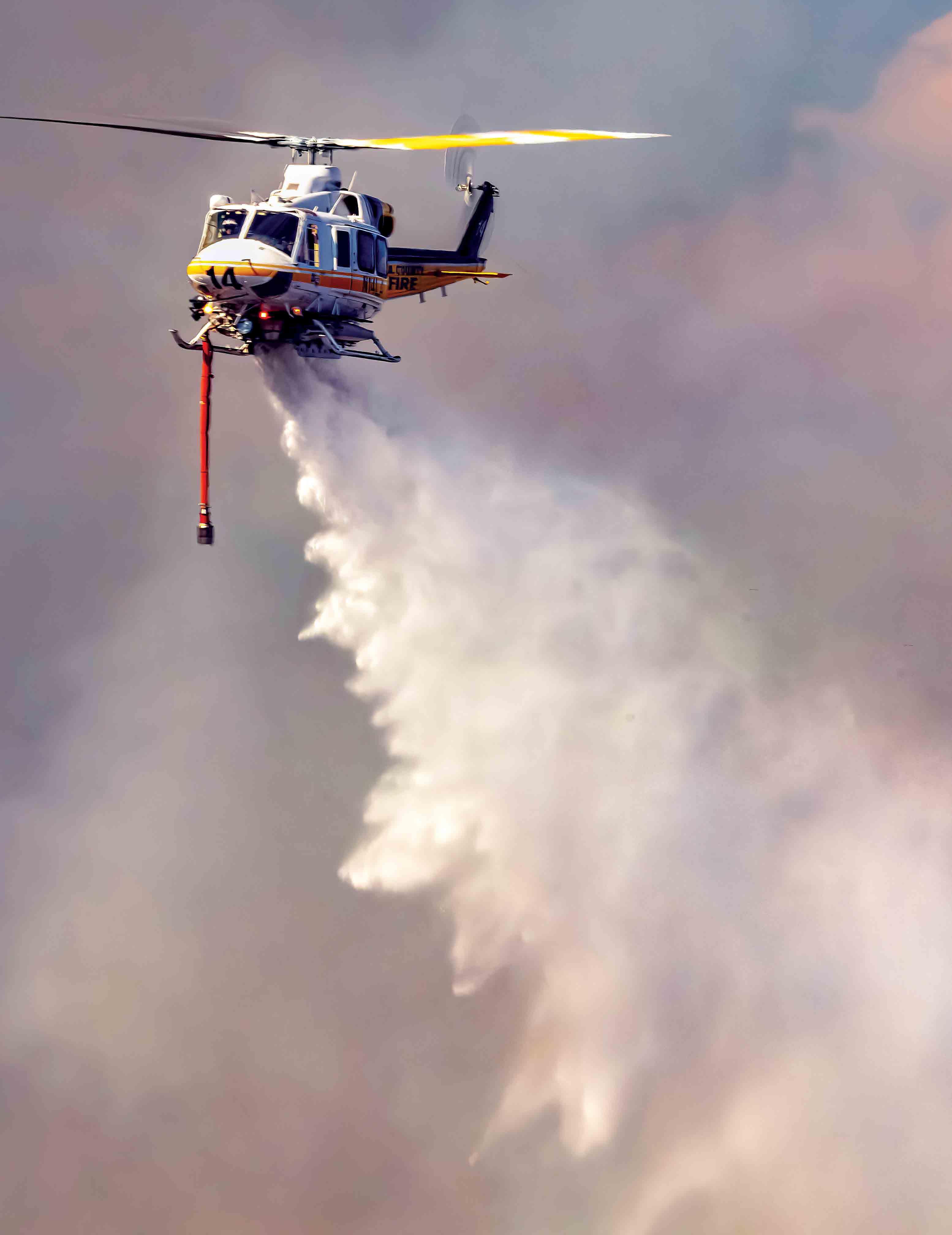 An L.A. County Bell 412 drops water on the Flats fire in California. Photo by Kaileen Hannigan.
An L.A. County Bell 412 drops water on the Flats fire in California. Photo by Kaileen Hannigan.

Perimeter Solutions announced this month that PHOS-CHEK® long-term fire retardant is celebrating its 60th anniversary. The iconic brand manufactured by Perimeter Solutions was first approved for use in aerial wildfire attack by the United States Forest Service in 1963, and it quickly became the go-to fire retardant for wildland firefighters around the world. Over the past six decades, PHOS-CHEK has helped firefighters to protect property and save countless lives.
When it was introduced, PHOS-CHEK dramatically improved wildland firefighting. PHOS-CHEK was the first commercialized gum-thickened fire retardant that came with a range of viscosities. Before that, the only options available to fire managers were retardants with no-viscosity (un-thickened) or high-viscosity retardants. This innovation allowed federal agencies to optimize retardant characteristics based on delivery system, topographical situation, fuel type, and specific fire characteristics.
Since 1963, the PHOS-CHEK brand has expanded beyond fire retardant to include industry-standard firefighting foams and foam dispensing systems, equipment to deploy PHOS-CHEK chemistry in remote wooded locations, as well as ground-based fire retardants that provide extended periods of protection from wildfire in at-risk areas and around people’s homes. PHOSCHEK technology is backed by a global team of people who support firefighting operations with bases, logistics, consulting, applications and technology development and more.
Today, PHOS-CHEK is synonymous with the development of the modern firefighting industry. It has continued to evolve
alongside wildland firefighting to help firefighters meet the challenges of longer, more intense wildfire seasons.
To celebrate this important milestone, Perimeter Solutions is launching the PHOS-CHEK 60th Anniversary Virtual Museum. An interactive gallery, visitors to the Museum can:
• Read about industry pioneers, like Larry Vandersall, who are responsible for the development and evolution of PHOS-CHEK technology
• Learn about famous wildfires that changed fire safety and the lives of those who were affected by them
• See the impact wildfires have on human health and the world around us, and more
New features will be added to the PHOS-CHEK 60th Anniversary Museum every month to provide fresh content for visitors throughout all of 2023.
“The story of PHOS-CHEK is more than a story about products and a company. It’s a story about vision, innovation, about courage, and commitment. It’s a story about the history of firefighting successes in the USA and beyond. We hope people will share this Museum with family, friends and business associates to let them know how committed we all are to providing solutions that save lives.” said Edward Goldberg, CEO of Perimeter Solutions. “We are thrilled to introduce the PHOS-CHEK 60th Anniversary Museum.”
• USDA Forest Service certified
Working with global fire safety agencies and alongside frontline firefighters we’re always looking to make our aerial fire retardants better. More effective. Safer. Easier deployment. Higher visibility. Hassle-free mixing and storage.
In the critical area of environmental performance, our PHOS-CHEK LCE20-Fx fire retardant represents a next generation technology –featuring lower aquatic toxicity, low impact on vegetation and high efficiency in use. Beyond taking care of our natural environment, that makes PHOS-CHEK LCE20-Fx safer to use, easier to handle and reduces disposal costs.


Let us know how we can help you with better products and services. We’re listening.
• 100% premium-grade phosphate product
• Superior aerial visibility
• Low environmental footprint


• Improved aquatic toxicity
• Improved product stability
• Easier handling
• Reduced maintenance costs
• Enhanced product safety
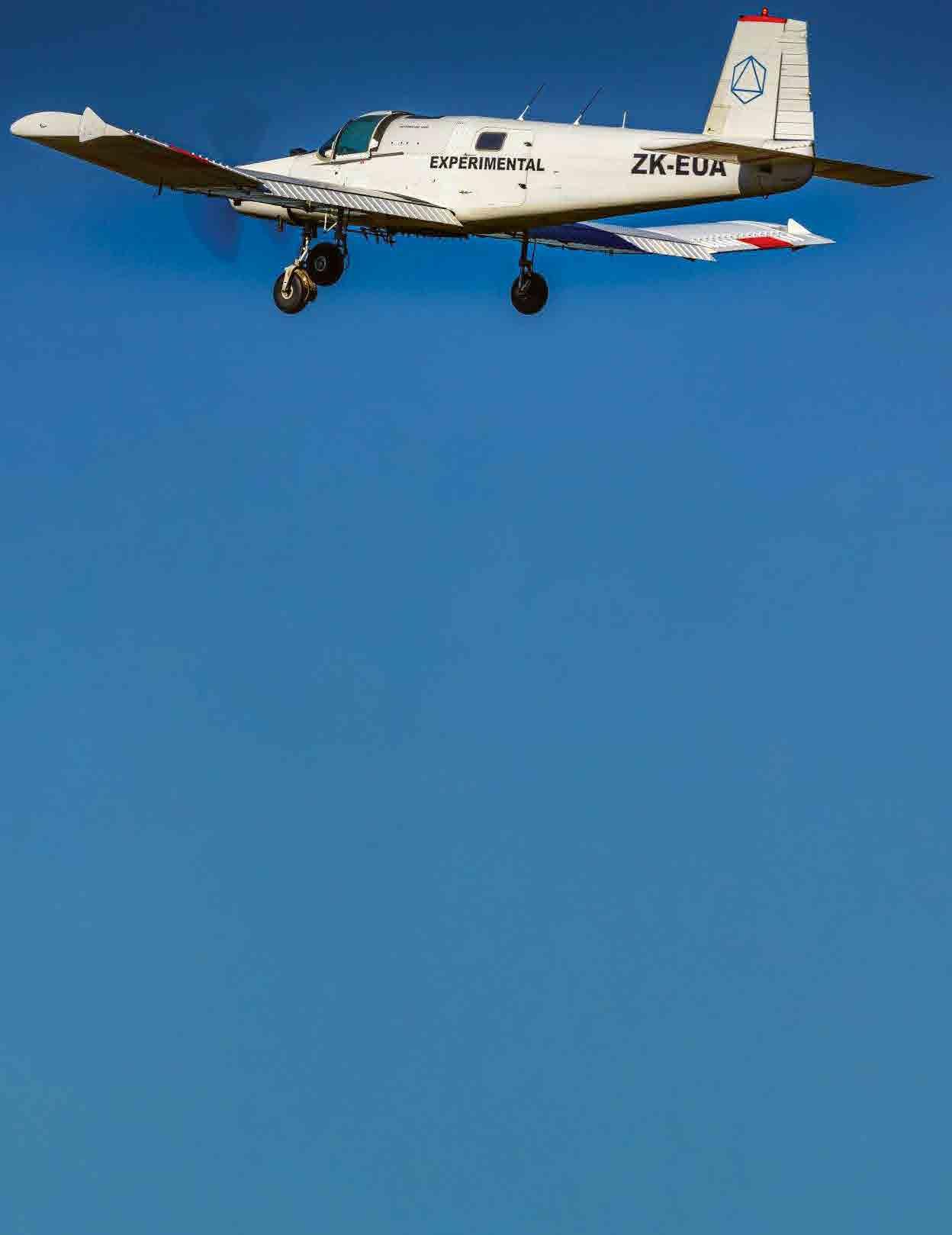
Skybase, an aviation technology company founded in 2017 and based in Canterbury, New Zealand, has developed technology allowing pilotless planes to fight bushfires. In its first iteration of development, the company is using New Zealand-manufactured Fletcher aircraft that was originally designed for agricultural aviation. The company aims to convert traditional aircraft into drones by integrating advanced artificial intelligence systems into aircraft, allowing pilots to operate the planes remotely from the safety of a computer screen on the ground.
The unmanned aircraft is aimed at being able to be deployed even in adverse conditions, such as poor weather, low light (e.g. night), allowing them to drop large quantities of water or fire retardant on flames and hotspots, when it would otherwise not be possible if a pilot was onboard.
In May 2022, the Civil Aviation Authority of New Zealand granted Skybase initial testing certification
to conduct remotely operated test flights with a pilot on board. While the ultimate goal is for the planes to be fully autonomous, they currently rely on the supervision of pilots.
During the testing phase, the remote pilot must be qualified to operate a Fletcher aircraft but can be located anywhere in the world. However, initial operations are operated remotely from the company’s base at Rangiora Airport outside Christchurch.
Skybase’s technology, called SOFI, has the potential to be used in various industries, including agriculture, mapping, surveillance, cargo operations, first responders, medical evacuations, and natural disaster responses. The company plans to roll out SOFI commercially in 2024, with individual countries’ testing and certification of the technology to follow with unknown certification dates.
The aircraft being used in this test is a New Zealand manufactured Fletcher aircraft, used primarly in agricultural application.
BLR Aerospace announced in early January that it has received FAA STC approval for its FastFin® System for the UH-60 helicopter. The kit is offered with an FAA-certified flight manual supplement, which includes significant increases in useful load along with increased maneuverability and controllability margins commensurate with other BLR Certified FastFin® Systems.
BLR’s patented FastFin System technology has dramatically increased the operating capabilities of the UH-60 Black Hawk and provides an unparalleled performance increase along with improved handling qualities and operating safety
margins. Mike Carpenter, president of BLR Aerospace states, “BLR’s UH-60 FastFin System is just another example of how BLR’s patented FastFin system can dramatically improve the performance of an existing helicopter, and we are excited to bring this innovative product to market for the benefit of the UH-60 operators worldwide”.
BLR Aerospace, headquartered in Everett, Washington, provides performance-enhancing products on more than 10,000 helicopters and airplanes worldwide and is endorsed by industry-leading OEMs such as Airbus Helicopters, Textron Aviation, Sikorsky Aircraft, and Bell Helicopters.


Coulson Aviation announced in January that the company has been awarded the contract for Australia’s National Large Air Tanker (LAT). The converted Boeing 737, Tanker 139, is the newest addition to Coulson’s FireLiner™ fleet and will be based in Sydney, New South Wales but will support additional locations in-country as needed. As the National LAT, Tanker 139 will wear the name “Phoenix” as a result of a naming competition last year via local Australian schools and joint winners Bishop Druitt College Coffs Harbour, St Patrick’s College Campbelltown, and Christian College Geelong.
“Coulson is proud to provide our state-of-the-art aircraft to the Federal Australian Government. This aircraft is an incredibly efficient bomber and the crews that operate each of our aircraft are second to none,” said Coulson Aviation Australia CEO Britt Coulson. “Working alongside dedicated Australian firefighters, Phoenix will be one of the key assets supporting this upcoming bushfire season,” said Britt.
The 737 is in Australia and funded by the Commonwealth Government through a partnership with the National Aerial Firefighting Centre (NAFC). The contract is for two years

with the option to extend. Phoenix is equipped with Coulson Aviation’s Retardant Aerial Delivery System (RADS), the Company’s patented tanking and release system. With RADS onboard, the aircraft is capable of dropping up to 4,000 gallons of retardant or water at flow rates of up to 3,000 gallons per second.
The State and Territory agencies involved in firefighting and land management recognize that improved performance and other synergies may be obtained through cooperation and sharing of aircraft resources. The NAFC arrangements allow for the procurement and sharing of these resources nationally.
Coulson Aviation is the only company in the world to convert a Boeing 737 commercial airliner into a multi-mission FireLiner™ aircraft. The Company has operated in Australia for almost 20 years, providing aerial support across multiple Australian States. Coulson’s roots in aviation, combined with the company’s proprietary technology, a wide array of aircraft types, and well-trained attack crews, allow simultaneous aerial firefighting support across multiple regions.

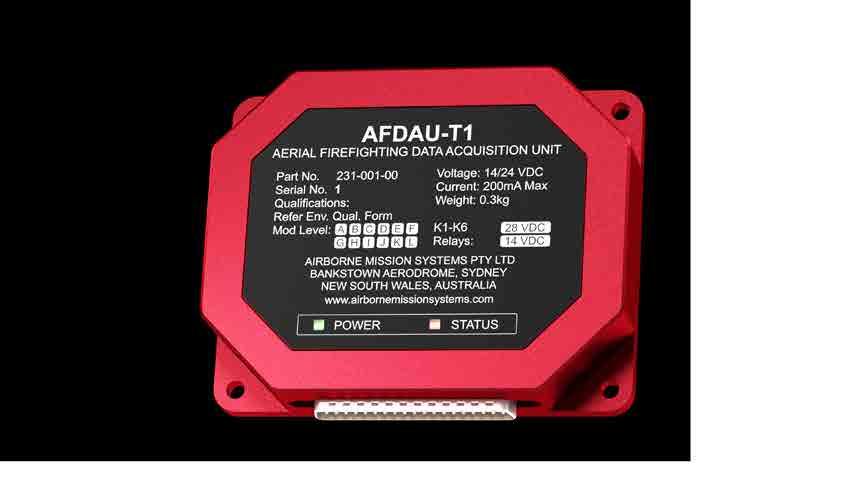




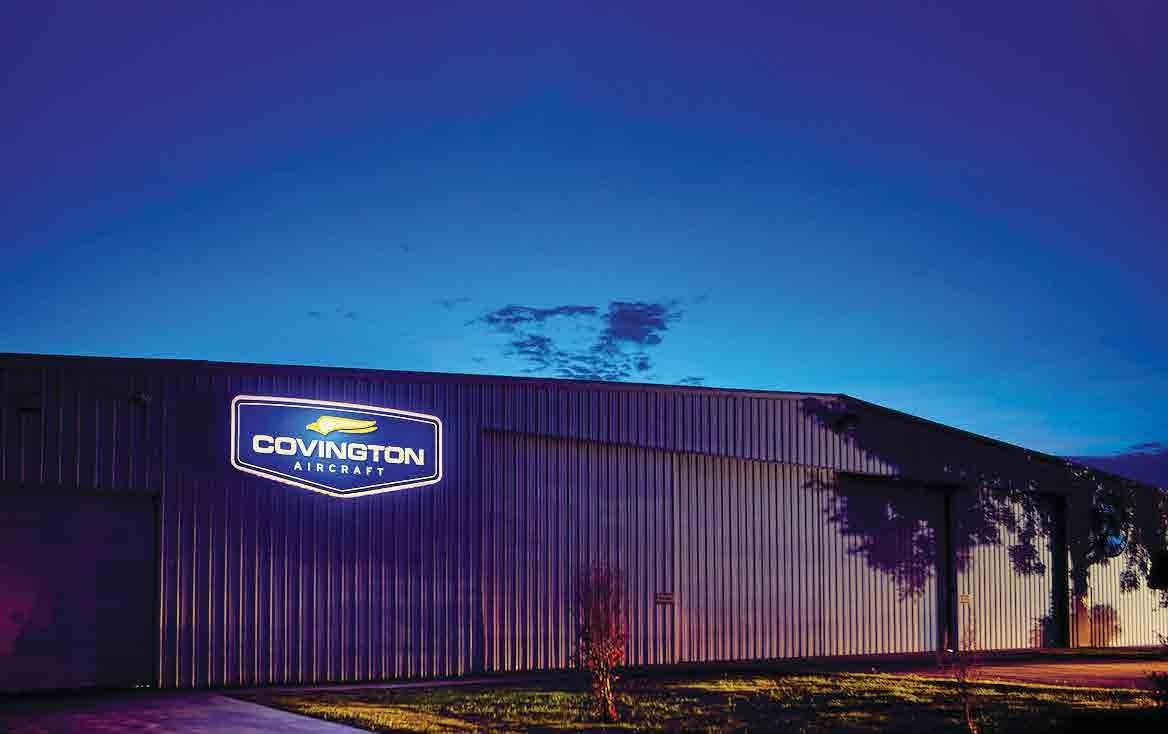
In addition to heralding its 50th year in business, Covington Aircraft Engines is celebrating the renewal of their certification as a Pratt & Whitney Canada (P&WC) Designated Overhaul Facility (DOF). As a DOF, Covington has the ability to carry out factory-authorized maintenance, warranty, and parts support work on 59 models of the P&WC PT6A turbine engine. Covington is a P&WC DOF fully owned and headquartered in the United States.
“We’re certainly very proud of our DOF designation,” said Aaron Abbott, president of Covington Aircraft Engines. “Today marks the third renewal of our agreement with Pratt & Whitney Canada, and we simply could not ask for a better collaborator,” he continued. Covington has a significant history with engines from the Canadian manufacturer, as the company began as a repair and overhaul facility for its legendary R-985 and R-1340 radial engines – a capability Covington continues to maintain today with a full team of radial engine technicians and a complete parts inventory.
Unique in the industry is Covington’s singular focus on Pratt & Whitney Canada and the PT6A, which has given the
company depth of knowledge and technical expertise on the proven engine. With facilities in both the United States and Brazil, an additional facility planned for the United Kingdom, multi-million in parts inventory, a fleet of PT6A rental engines, state-of-the-art test cells, and 24-hour rapid response mobile repair teams, Covington is well-positioned and capable to reach and assist virtually any PT6A customer worldwide. Most important, as a family-owned and oriented company, Covington prides itself on its relationship-based approach to service, which ensures customers are welcomed as family and treated with the utmost respect and care.
“Covington’s depth of knowledge, capabilities, and strong family values are unique in our industry – and we have had a very harmonious relationship ever since our first agreement with the company was signed close to thirty years ago,” said Irene Makris, Vice President, Customer Service at Pratt & Whitney Canada. Renewing our agreement together not only continues a great relationship and success together – but gives all of us a sense of pride and accomplishment – especially on the occasion of Covington’s 50th Anniversary year.”
Let’s face it. This job’s not for everyone. Aerial firefighting demands nerves of steel and the power to fly at peak performance. The PT6 turboprop continues to be the engine of choice – built for full-load takeoffs in extreme hot and high environments, all day, every day.
LEARN MORE AT PWC.CA/PT6
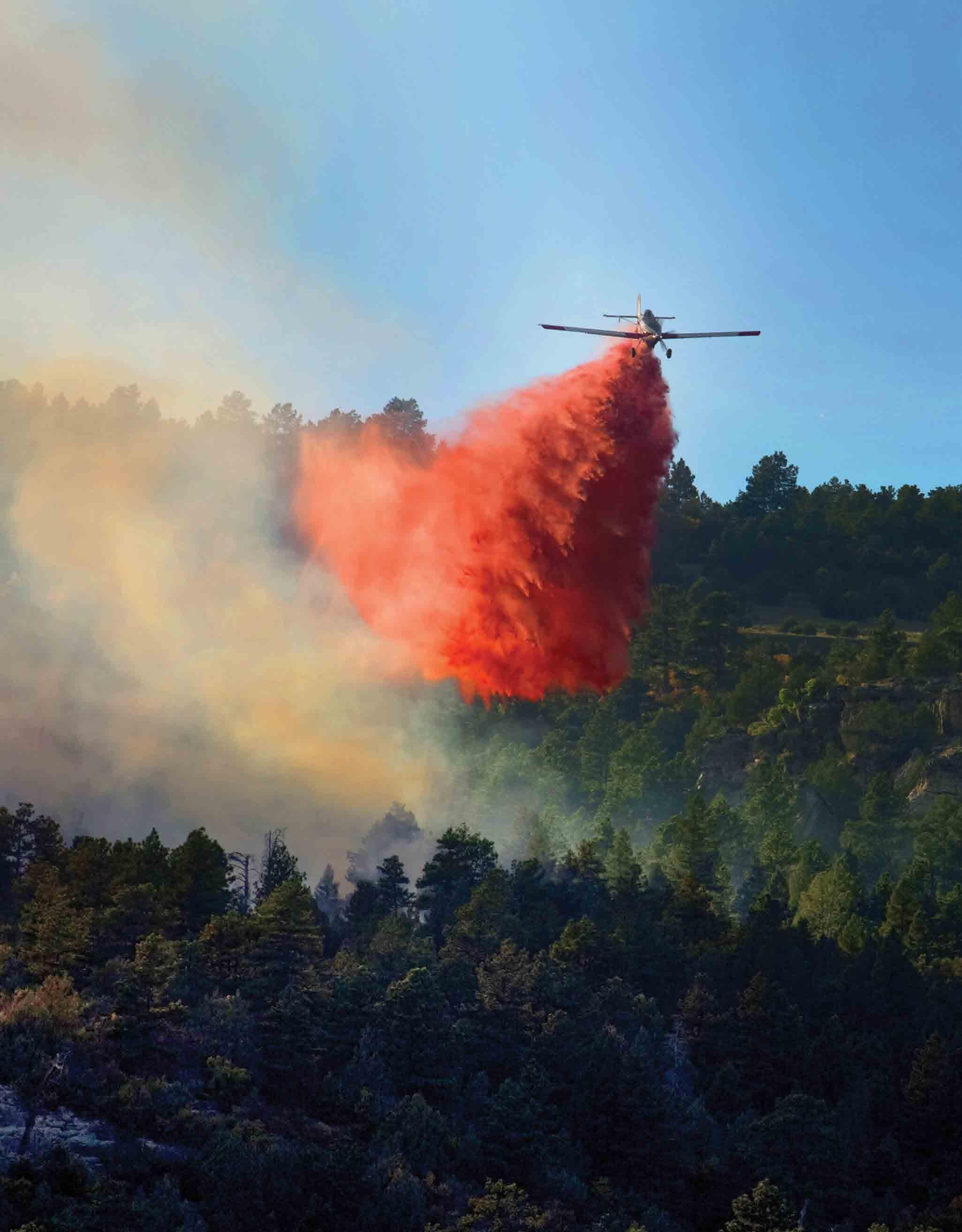
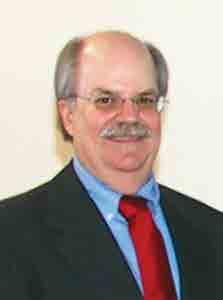
Well-known industry stalwart Bill Gabbert, founder, and editor of Fire Aviation and Wildfire Today passed away peacefully on January 14th after a battle with cancer.
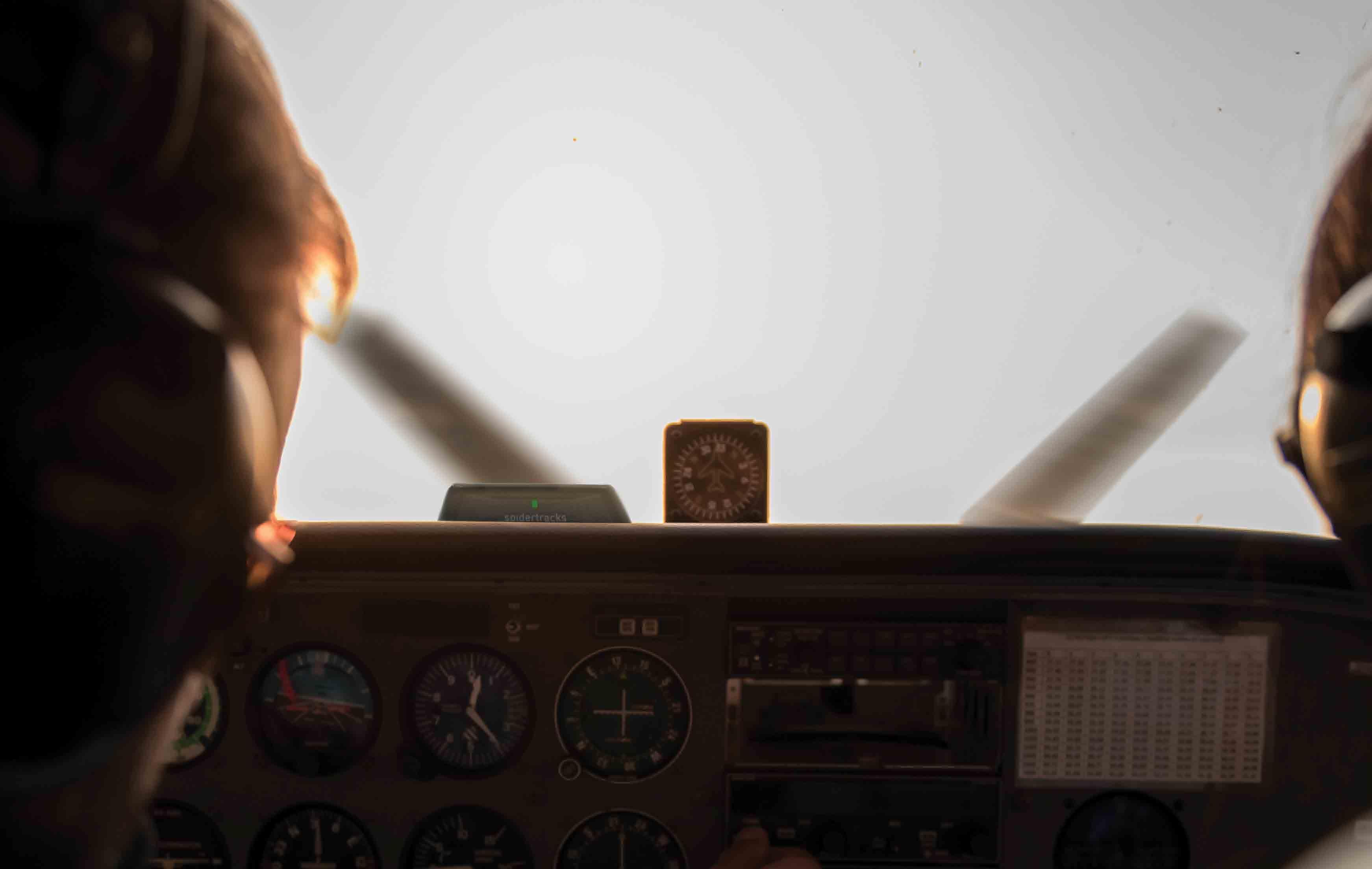
Bill grew up in Senatobia and graduated from Senatobia High School, later earning a B.U.S. degree in forestry from Mississippi State University.
Bill served as a wildland firefighter in the U.S. Forest Service for 20 years and then in the U.S. National Park Service for 13 years. At the time of his retirement, he was a fire management officer for the Black Hills in South Dakota and had fire management responsibilities in seven national park areas in South Dakota, Wyoming, and Nebraska.
Throughout his career, Bill was a respected and knowledgeable voice in the wildland firefighting community, providing information on the latest firefighting technology,
tactics, and policy. He was also a tireless advocate for the men and women who work on the frontlines of firefighting, always seeking to raise awareness of the dangers and challenges they face.
Through Fire Aviation and Wildfire Today, Bill shared his extensive knowledge and passion for wildland firefighting, and his contributions to the field will not be forgotten. He will be greatly missed by his family, friends, and the entire wildland firefighting community. Our condolences to his family and friends.
for a safer tomorrow.
Obtaining detailed flight information and enhancing real-time critical oversight has never been easier. Know exactly where your aircraft are, and how they are being flown.
As the largest Honeywell TPE Channel Partner globally, TAE Aerospace can provide the lowest pricing on OEM parts for our customers.
Why TAE Aerospace is the largest authorized Honeywell MRO in world

• Unmatched pricing on OEM parts
• Largest OEM parts holding to assist with quicker turnaround times
• LRUs, component and fuel nozzle sales and support
• Consignment stock
• In-house repair capability
• Lease and exchange engines
• AOG support
• Global sales, field service and technical team ready to support your next engine or component event.
Other authorized MRO providers and non-authorized facilities are being forced to pass on the significant price increases we see in the economy today. As the only globally-licensed TPE MRO provider, TAE Aerospace can continue to deliver the lowest pricing to our customers. Our global capability also means you will benefit from our large stock holdings, in-house LRU capability and the only Honeywell Authorized Rental engine pool.
For example, the current Honeywell 1st stage wheel (P/N 3108164-4) list price is $174,831.* As a TAE Aerospace customer, you will pay $53,000. That’s a difference of almost $122,000!
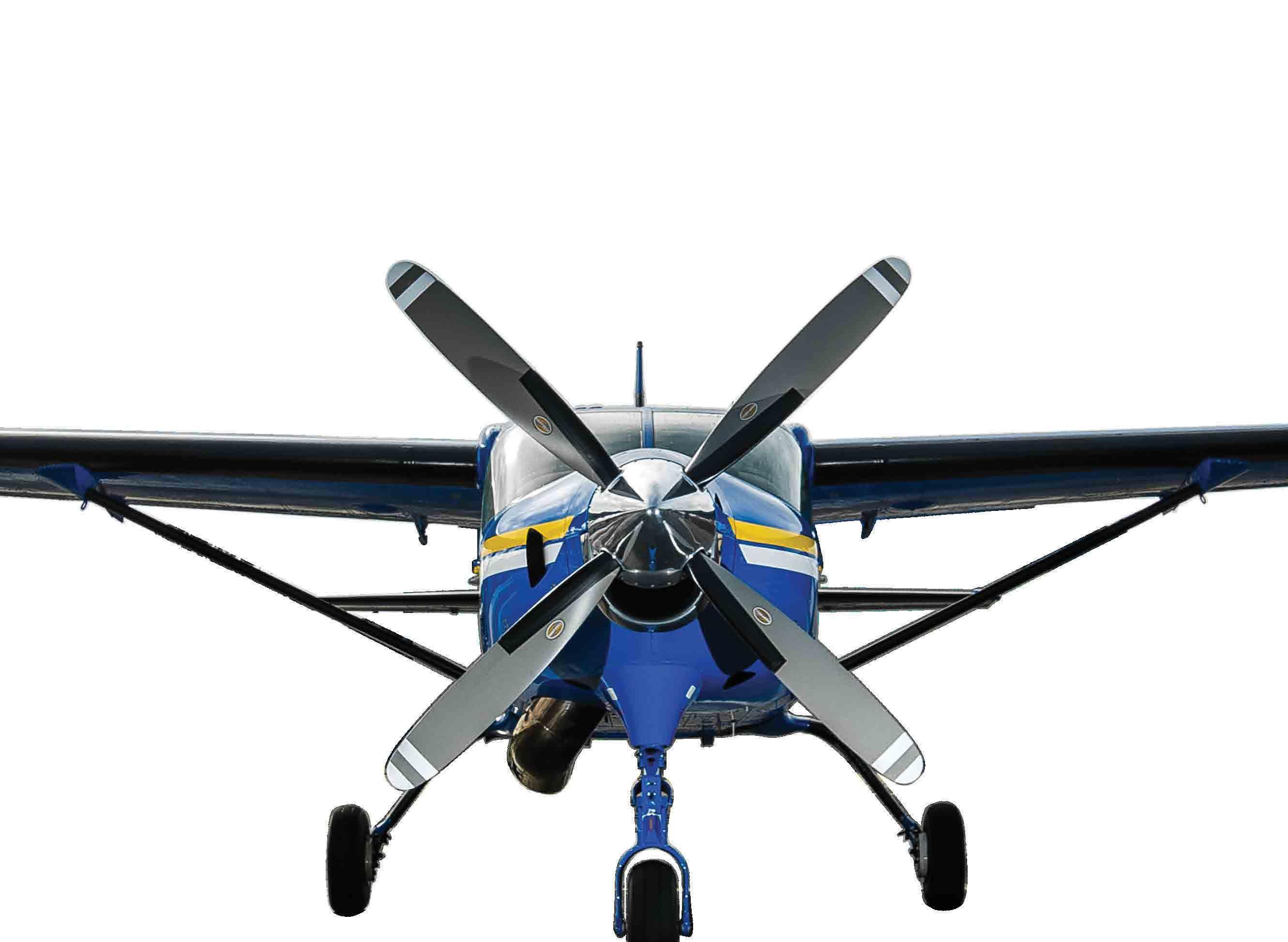
Talk to us today about how we can offer a cost-effective solution for your next engine or component event. Contact Bruce Hubler on +1 (208) 229 8340 or email
bruce.hubler@taeaerospace.com

Employee-owners of airplane manufacturer Air Tractor, Inc. and representatives from Pratt & Whitney Canada celebrated the 1,000th model AT-802. Air Tractor dealer Lane Aviation sold serial number 802A-1000 through its Brazil agent Aero Globo Aeronaves. The airplane is painted in the Brazilian flag colors of yellow, green, and blue. It recently departed Olney, Texas for its new home at Grupo Moacir Smaniotto (GMS) Agronegocios. The family- owned farming business is located in Sorriso, Mato Grosso Brazil. In a typical year, GMS farms 44,700 hectares (110,456 acres) planted in soybeans, corn, and cotton. Their new AT-802A joins another Air Tractor 502XP purchased in 2019.

Following a luncheon and comments from Air Tractor President Jim Hirsch, Natanael Vaz and Anthony Rossi of Pratt & Whitney Canada presented Hirsch a plaque commemorating the milestone. “We’ve come a long way with the 802 series,” remarked Hirsch. “In the early 1990s when the very first 802s were built, our founder Leland Snow looked at the airplane and offhandedly remarked
‘We’ll probably build 10 or 12 of these.’ Well, Leland would be really pleased about its worldwide distribution and success today.”
It was 1989 when Leland Snow began designing a large capacity, single engine airplane specifically for aerial firefighting. He believed it would have a positive impact in that industry. After more than two years of design, modification, certification, and manufacture, the first production single-seat AT-802A air tanker rolled out the doors of Plant 3 in 1993 into the eager hands of Chuck Kemper, owner of Queen Bee Air Specialties in Rigby, Idaho.
Sam Kilpatrick, who worked on the prototype and built those early 802s, recalls, “I don’t know that anybody really knew how popular it would become. If we built one 802 in a month or two, we thought we were really doing something, you know? And gosh, now we do it in just a matter of days.”
The AT-502B was the company’s largest and best-selling airplane until the AT-802 project began. And the
design and production of the first 802s was a whole new order of scale. Craig Cowan, who helped build those first 802s remembers, “The tail was so tall we weren’t sure if the tail would fit beneath the door of Building Three. That was a concern.” WD Middaugh laughs about it now, “We thought we’d have to put a notch in the door to get it out. The 802 was like a monster compared to what we’d been building.” Roy Jones added, “The canopy was so tall with landing gear on, we had to pick up the tail end of the airplane and then set it back down after it got past the door.”
It wasn’t long before Air Tractor produced the single-seat AT-802A for agricultural aerial spraying. As an 800-gallon (3,028L) ag plane, its popularity soared with aerial applicators. By 2011, 400 AT-802A airplanes had left Olney, Texas for work around the world. In 2019 serial number 802A-800 went to its new home in Roe, Arkansas. And in 2020 serial number 802A-900 joined the fleet of Western Australia’s largest ag operator, Dunn Aviation.
The 802 series is the largest production single engine agricultural airplane in the world. Its power, rugged dependability, size made it quite versatile. Beyond its use in agricultural and firefighting applications, AT-802 series aircraft work in a variety of specialized applications, from oil spill cleanup and fuel hauling in remote areas, to timber seeding and reforestation and coca crop eradication in South America. “Its power and rugged design, low operating costs, payload capacity has helped make 802s Air Tractor’s most versatile airplane.” notes Hirsch.
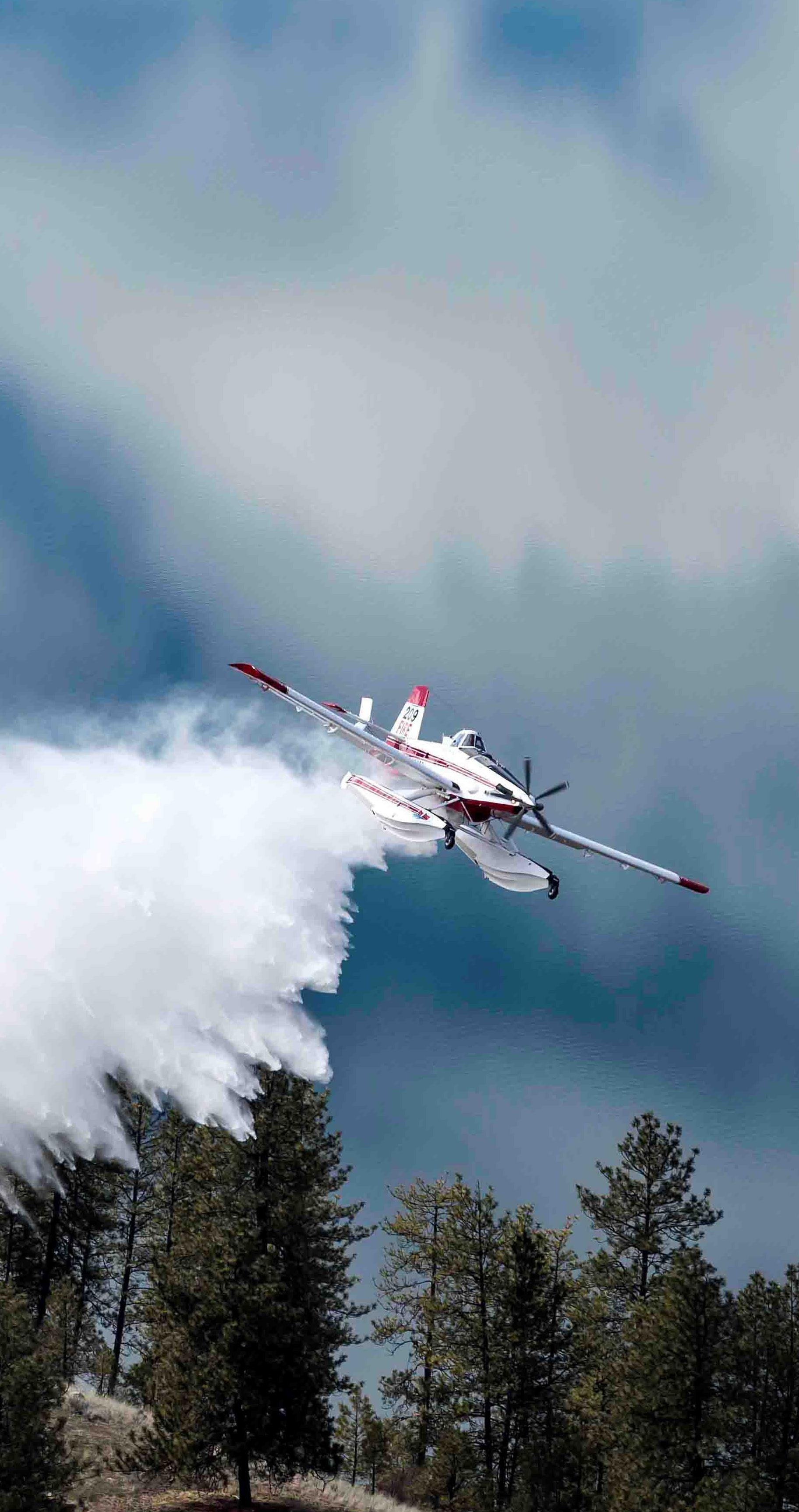
“I remember making the stamping first manufacturer’s placard to go on the airplane, recalls David Cowen, who was the AT-802 conformity inspector. “Keith Boyd, Leland’s head engineer at the time looked at me and asked, ‘Do you think we’ll ever build a thousand of these?’ I said
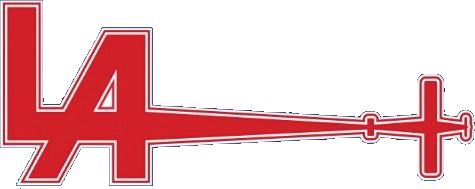
‘Let’s just go ahead and stamp three zeros in front of numeral 1.’ And 30 years later, just look at us now.”
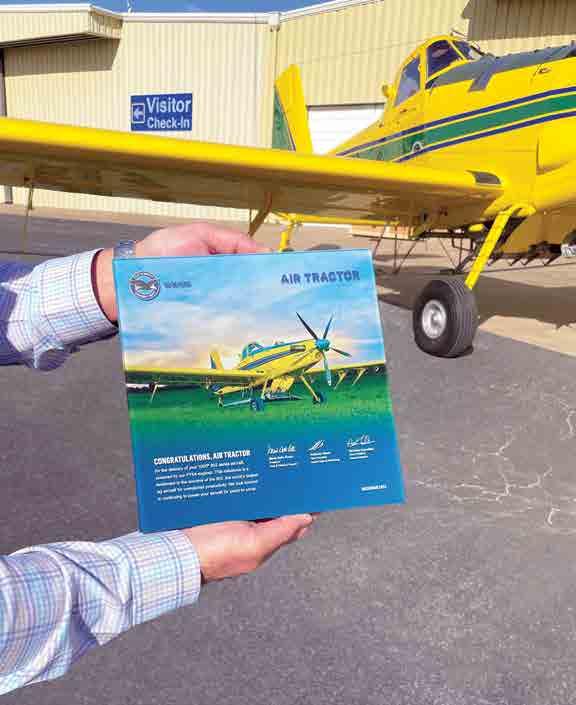 Commemorative plaque from Pratt & Whitney Canada.
Commemorative plaque from Pratt & Whitney Canada.

After a three month deployment in support of the US fire service’s firefighting efforts, the NSW Rural Fire Service’s (RFS) Marie Bashir Large Air Tanker returned to Sydney November 21, 2022.
Minister for Emergency Services and Resilience Steph Cooke said the plane and a crew of aviation personnel have spent hundreds of hours in the air, fighting 37 fires across six US states and dropping more than 1.23 million litres of suppressants.
“What was initially a four week posting for the Marie Bashir and her crew was extended to more than three months, undertaking life-saving work in order to protect American communities,” Ms Cooke said.
“Our thoughts are with impacted communities including in Idaho, Nevada and California, as well as the firefighters and other personnel who battled the recent fires.
“NSW firefighters are all too familiar with the threat of bush fires and have a proud history of helping others, both here in Australia and overseas.
“Our personnel and resources are among the best in the world and the request to have our Large Air Tanker help out is testament to this.”
RFS Commissioner Rob Rogers said NSW has the nation’s largest aerial firefighting fleet and continues to
assist interstate and international firefighting agencies.
“It’s great to be able to provide this support to US fire authorities for the second year in a row,” Commissioner Rogers said.
“We welcome the Marie Bashir back to home soil at RAAF Base Richmond, where she will be ready for dispatch in NSW and interstate this bush fire season as warmer conditions begin to return.”
The 737 Large Air Tanker has a cruising speed of 850 kilometres per hour and can drop more than 15,000 litres of fire suppressants at a time.

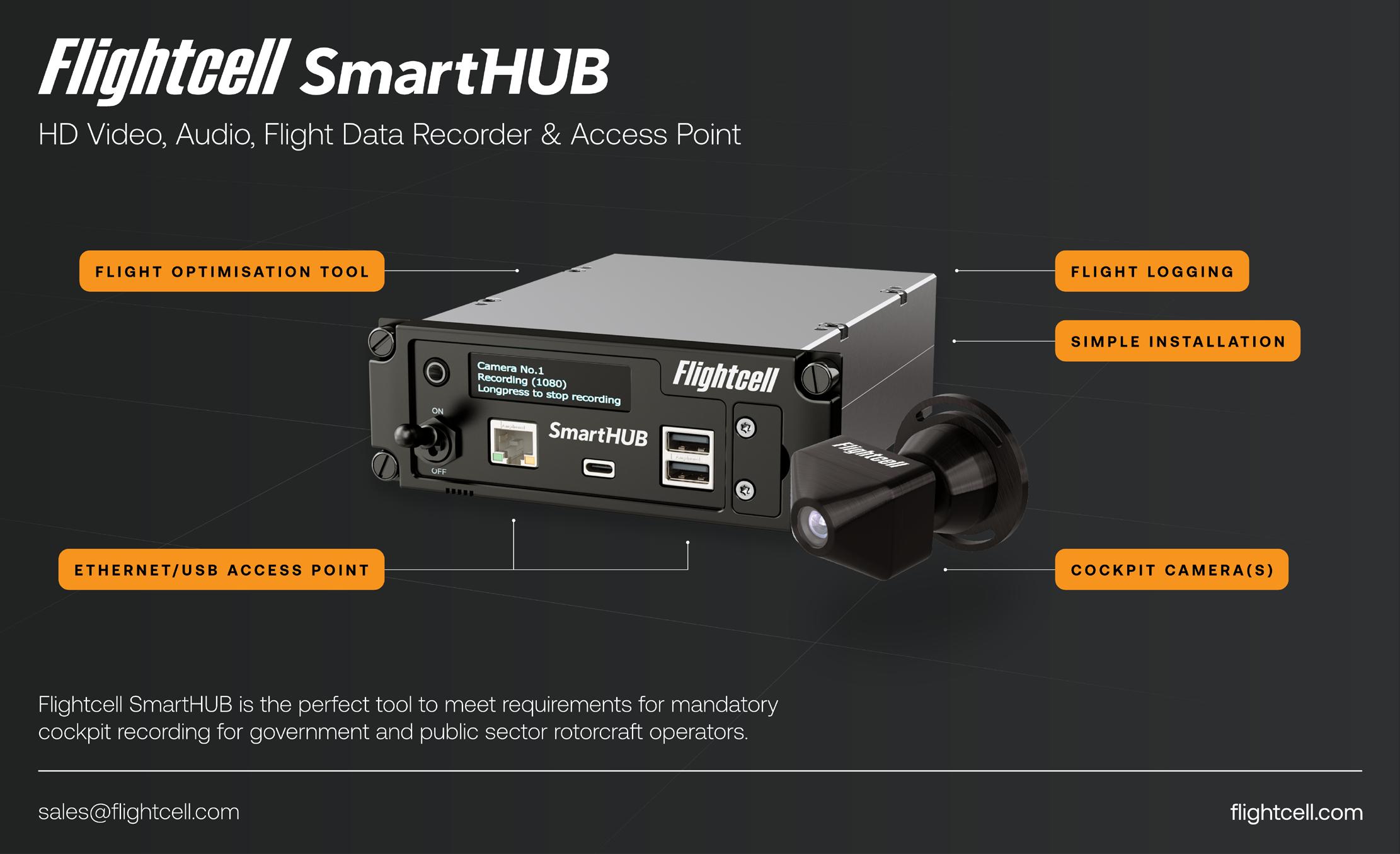
Sikorsky delivered its 5,000th “Hawk” variant helicopter on January 20th 2023, a U.S. Army UH-60M Black Hawk. The iconic aircraft will continue to support medium-lift requirements for the U.S. military and international operators for decades into the future.

“Sikorsky, as a company, has been forged by the Black Hawk,” said Sikorsky President Paul Lemmo. “The Black Hawk and its variants deliver when reliability and performance are non-negotiable. Hawk aircraft continue to demonstrate their versatility and readiness with the latest technological advancements and ongoing U.S. and global investment in the aircraft.”
The Black Hawk platform and its derivatives include the MH-60R/S maritime operations helicopters, MH-60T multi-mission helicopters, HH-60W rescue helicopters, and internationally built S-70 Black Hawks, including the baseline FIREHAWK, which have all proven their versatility and capability across a spectrum of challenging mission sets.
Sikorsky’s highly skilled and experienced workforce manufactures the latest generation of Hawk aircraft built in Stratford. There is high international demand for the Sikorsky S-70 Black Hawk, manufactured by Lockheed Martin’s PZL Mielec facility in Poland. More than 35 international customers operate the Black Hawk thanks to its global support network and continued modernization.
The U.S. Army, the largest Black Hawk operator, noted the key role the aircraft continues to fulfill during military and civil operations worldwide, in addition to its significant contribution towards Joint All Domain Operations.
In February 2022, Lockheed Martin flew its first uninhabited Optionally Piloted Vehicle (OPV) Sikorsky UH-60A/S-70 Black Hawk testbed helicopter powered by Sikorsky’s MATRIX™ autonomy technology in collaboration with the Defense Advanced Research Projects Agency.
“We are committed to all H-60 and S-70 operators and look forward to enduring partnerships on the Hawk program in the years to come,” added Nathalie Previte, vice president of Army and Air Force Systems at Sikorsky. “It remains our priority to fulfill our customers’ requirements and meet the needs of current and future operational units. With unmatched versatility and global interoperability, Hawk aircraft continue to advance 21stcentury security.”
The Sikorsky S-70i Firehawk is a variant of the S-70 Black Hawk helicopter, which was first developed by Sikorsky Aircraft in the 1970s. The S-70i Firehawk is specifically designed for use as a firefighting and emergency response aircraft. It features a number of modifications and upgrades that make it well-suited for these tasks, including the ability to carry up to 2,650 gallons of water or fire retardant and the ability to refill its tanks in as little as 20 seconds.
The first S-70i Firehawk was delivered to the Los Angeles County Fire Department in 2015 and has since been used by many other fire departments and emergency response organizations worldwide. The aircraft is also available for commercial use, with customers including aviation companies and government agencies.
In recent years, the S-70i Firehawk has gained recognition for its ability to provide rapid fire suppression and support to first responders in difficult-to-reach areas, which has proven to be an effective tool in fighting wildland fires and other natural disasters.
In 2020, the S-70i Firehawk was updated with a new digital cockpit, which includes a number of advanced features, such as a glass cockpit display and a digital automatic flight control system. The update aimed to improve the helicopter's capabilities and make it easier for pilots to operate as singlepilot IFR capable aircraft.

• On December 5th, 2022, the fire aviation world changed, for good and for the better when Fortress’ aerial retardants were fully approved and listed on the Forest Service’s Qualified Product List.
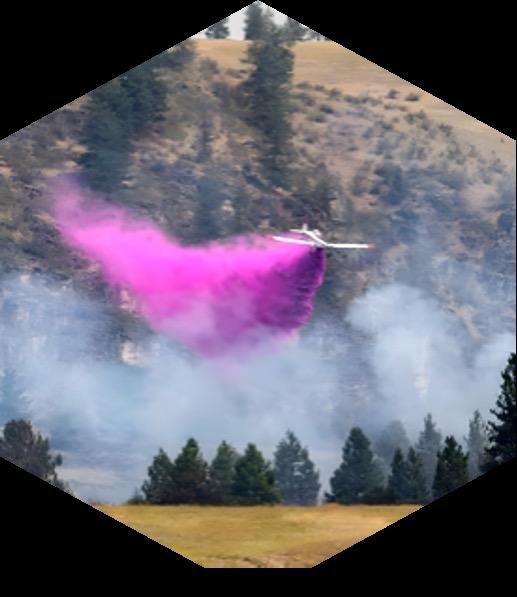
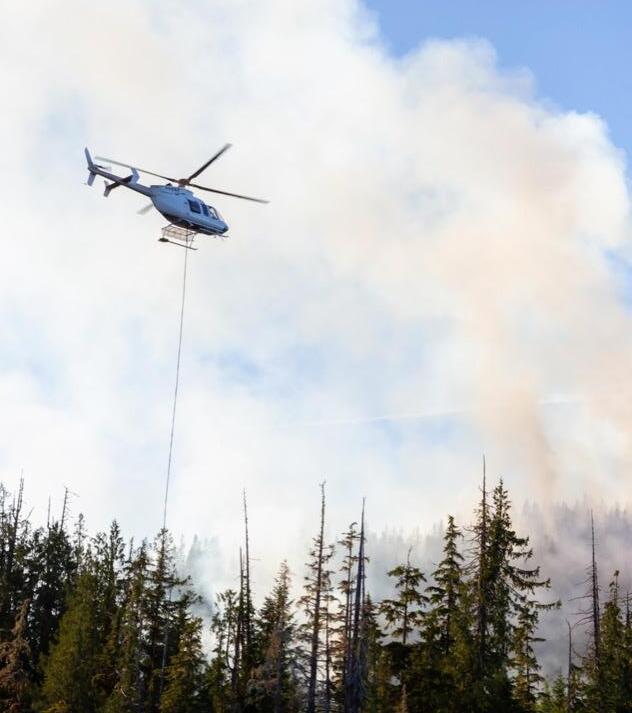


• After nearly a decade of intensive research and development, Fortress became the first new company to achieve fully qualified status on the QPL in 22 years.
• This mountainous achievement ends the sole-source era of aerial firefighting, and definitively establishes Fortress’ innovative magnesium chloride technology as safe, effective, and fit to fly.



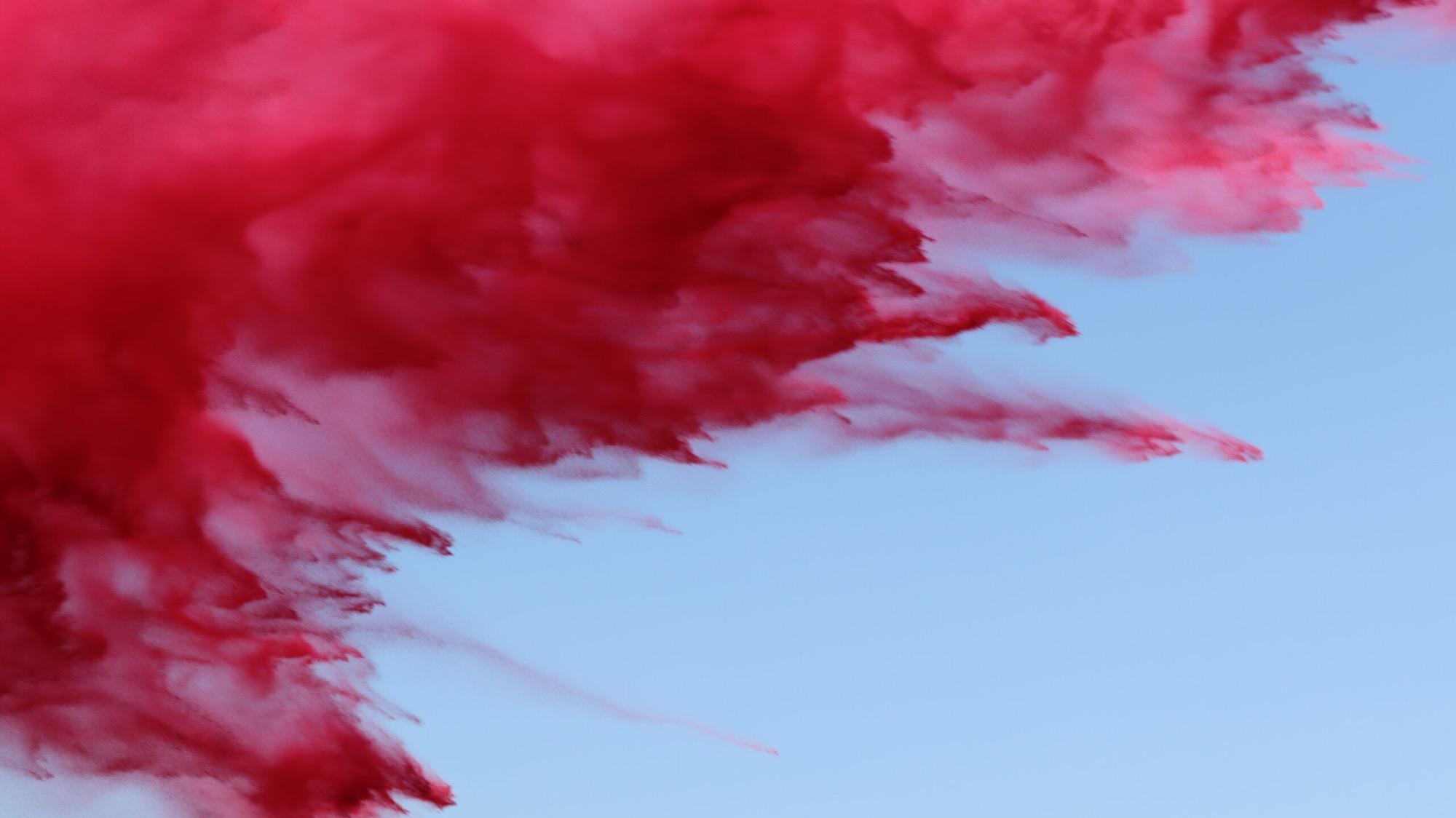
• Competition is back and we are just now getting started.
• Make no mistake, Fortress has arrived and we are here to stay.
Please visit us @ Fortressfrs.com


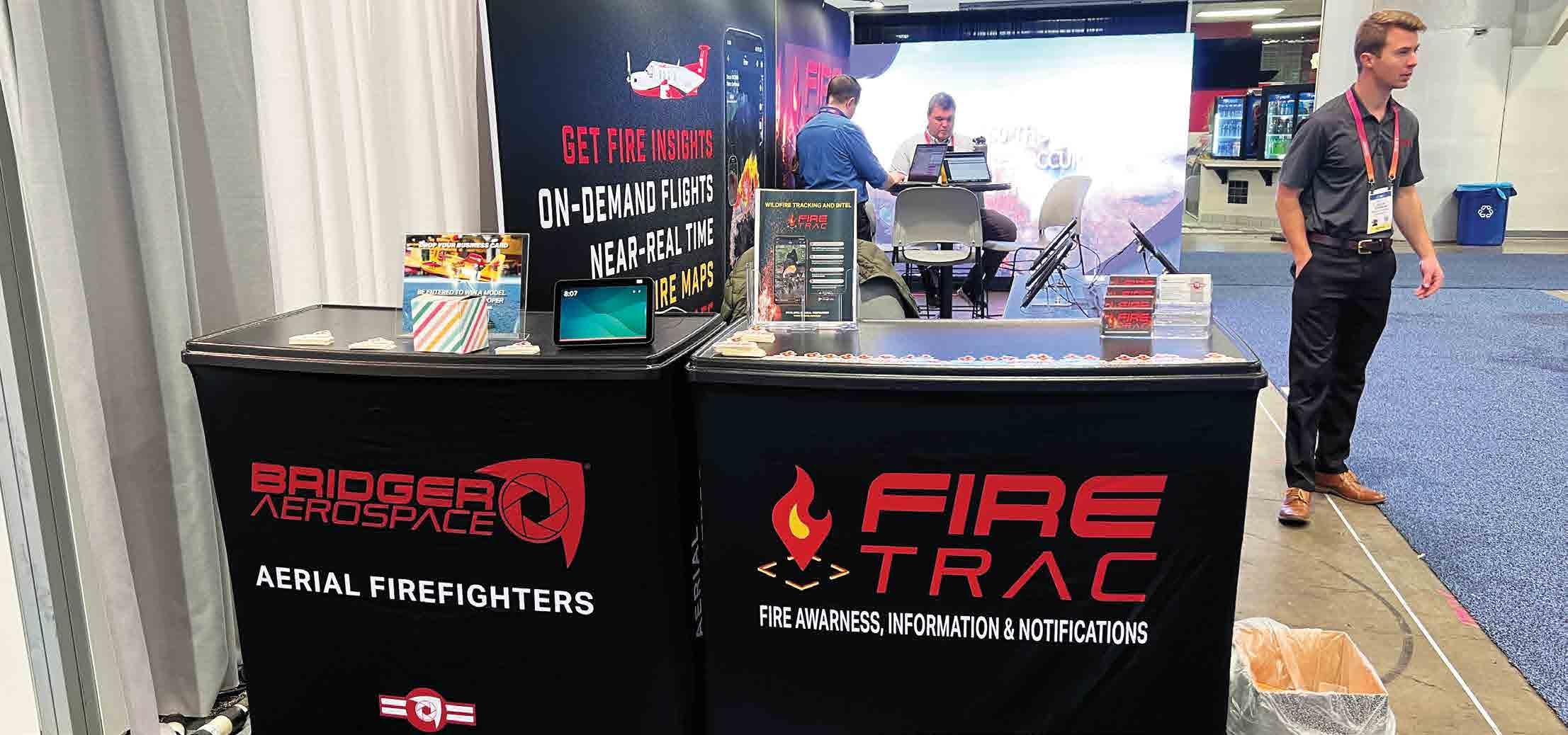
In a busy several months for Bridger Aerospace Group, the company completed a merger with Jack Creek Investments and began trading on the stock exchange. In addition to the two major announcements for the company, Bridger also showcased its new wildfire monitoring app, FireTrac, at the Consumer Electronics Show in Las Vegas on January 5-8.
FireTrac is designed for individuals and communities living in areas prone to wildfires, providing them with up-todate information on fire activity and enabling them to stay safe. The app uses Bridger aircraft to map fires and create an aerial image of the fire’s progression, using both RGB and Infrared imagery. It also aggregates data from verified sources, such as the US Forest Service and IRWIN (Integrated Reporting of Wildland Fire Information), to provide a comprehensive overview of the fire’s growth and containment.
Bridger Aerospace’s CEO, Tim Sheehy, stated that the company hopes FireTrac will help communities living in wildfire-prone areas better protect themselves and their families by providing as much data as possible in a simple smartphone app.

Bridger also began trading on the stock exchange on January 26th, 2023 under the ticker BAER, starting its stock price at $10.19 pre-merger, which then rose to a high of $25.90 per share at its peak after the announcement of the finalization of the company’s merger with Jack Creek Investments that was also finalized in the same week.
Founded in 2014 and led by former Navy SEAL Tim Sheehy, Bridger provides its federal agency and state government client base with a comprehensive range of aerial firefighting solutions. Bridger operates a large and sophisticated fleet of firefighting aircraft, which includes “Super Scoopers” (CL-415EAF), air attack and logistical support aircraft (Next
Generation Daher Kodiaks, Pilatus PC-12s, DeHavilland Twin Otter and legacy Twin Commanders), and UAVs (Unmanned Aerial Vehicles). Bridger also offers FireTRAC, an innovative, proprietary data gathering, aerial surveillance, and reporting platform that complements its fleet of firefighting assets.
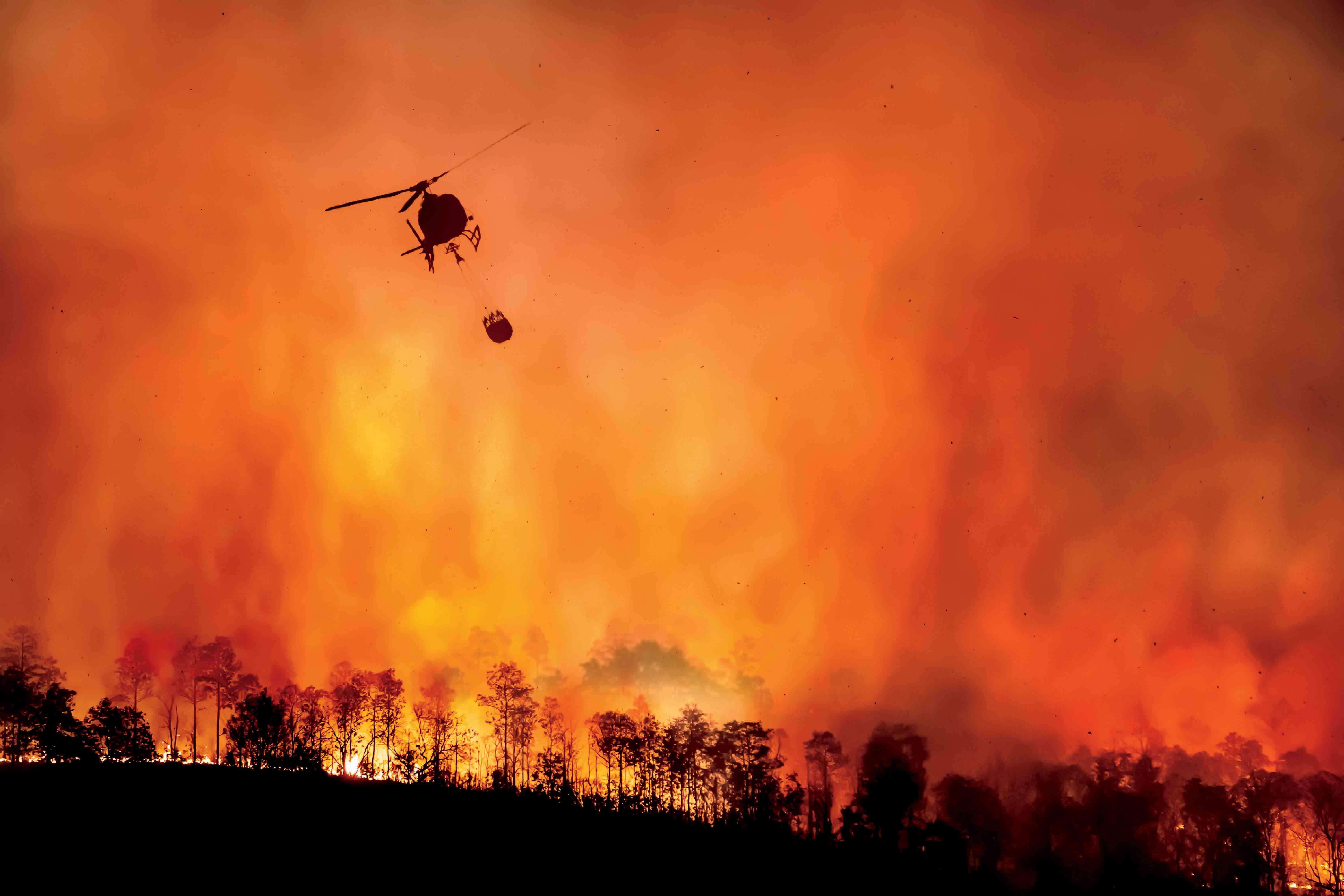
“The closing of the transaction and our listing on Nasdaq is an important milestone and an incredibly proud moment for the entire Bridger team,” commented Tim Sheehy, who will continue to lead the combined company as Chief Executive Officer. “We are excited to enter this new chapter as a publicly traded company, uniquely positioned to expand throughout North America and continue our mission to save lives, preserve our environment, and protect the people and communities that are impacted by the growing wildfire crisis across the globe.”

Jack Creek’s Executive Chairman, Jeffrey Kelter, who is joining Bridger’s Board of Directors as Chairman added, “We are excited to finalize our business combination and continue our partnership with the Bridger management team. As a public company, Bridger is well-positioned financially to further expand its industry-leading fleet and explore proprietary strategic investments to complete its growth plans for 2023 and create significant and sustained value for all stakeholders as it works to meet critical environmental and community needs.”
VISIT US AT HELI-EXPO ON THE METRO AVIATION BOOTH #C4012
Aviation Specialties Unlimited, Inc. (ASU) announced on January 11, 2023, that ASU Founder and CEO Mike Atwood was inducted into the Association of United States Night Vision Manufacturers (ANVM) Hall of Fame.
“I have known Mike Atwood for years, and he is very deserving of this recognition,” said ASU President Dr. Joseph Estrera. “Mike transformed an entire industry to the use of night vision goggles and made civilian aviation use of night vision goggles a reality. Without him, countless lives would not have been saved. He has helped shape not only the safety of the United States but also countless countries around the world because of his pioneering efforts.”
In 1995 the Association of United States Night Vision Manufacturers established a Hall of Fame to honor those individuals who have made a major contribution to night vision technology.
“This award is less about me and should be more about the team at ASU,” said Atwood. “We set out with a mission to help make flying at night safer. More than 27 years later, we are still accomplishing this mission. I want to thank everyone at ASU and the ANVM for this recognition. It means a lot to me to know that others recognize why I started ASU and more importantly, recognize the good work that we have done continues to make an impact.”
Atwood has spent his 43-year career in the night vision industry split between the U.S. Army, the Idaho National Guard, the Idaho National Laboratory, and ASU. His time with the Army included accumulating more than 1,000 hours flying with NVGs, starting with the first goggle ever approved for flight—the AN/PVS-5 Cut-Away. He later advanced to the AN/AVS-6 Aviators Night Vision Imaging System (ANVIS) and its complementary accessory, the AN/ AVS-7 ANVIS Heads-Up Display. He also served as an instructor pilot for the AH-64 Apache Attack Helicopter. Following active Army service, he was a pilot with the Idaho
National Guard. He retired in 2000 with the rank of Chief Warrant Officer 4.
He founded ASU in 1995 with the singular intent to get NVGs cleared for use in civilian EMS operations. Since its founding, ASU has put more than 5,000 NVGs into EMS operations worldwide and has modified aircraft lighting in nearly 1,500 individual aircraft in order to ensure safe flight when using NVGs. Since ASU set out to be a full-service supplier to the EMS community, the company also has provided training to more than 6,000 pilots and crew members. This effort resulted in the U.S. Federal Aviation Administration first authorizing NVGs for use by EMS personnel in 1999. Since then, the equipment and training provided by ASU have delivered enormous benefits for citizens worldwide.
Based on data from the Association of Air Medical Services and international Helicopter Emergency Medical Services organizations, an estimated four million life-saving EMS flights have occurred in the 22 years since night EMS flying first started.
Atwood was a 37-year member of the Helicopter Association International and served on its Government Services and Safety Committee as the night vision subject matter expert. He and ASU have also made contributions to military night vision. In 2014, he approached both manufacturers of image intensifier tubes and recommended the phosphor they contain be changed from green to white. This revolutionary idea has proven extremely beneficial as image clarity and brightness are much improved. Nearly all military pilots are now flying with white-phosphor image tubes. ASU has also delivered 23,000 NVGs (both aviation and ground) to military customers worldwide. Mr. Atwood stepped down from active involvement in ASU’s operations in 2021 but continues in a limited advisory role when requested.
Atwood also was recognized in 2012 with the Salute to Excellence Lifetime Achievement presented by the Helicopter Association International.


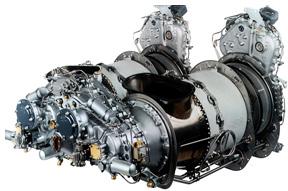


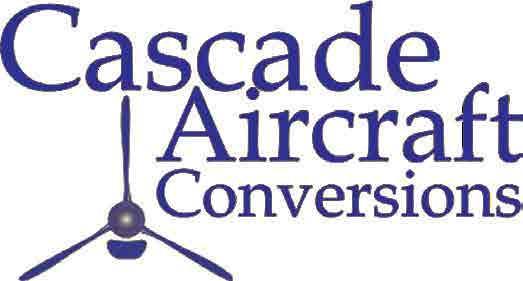


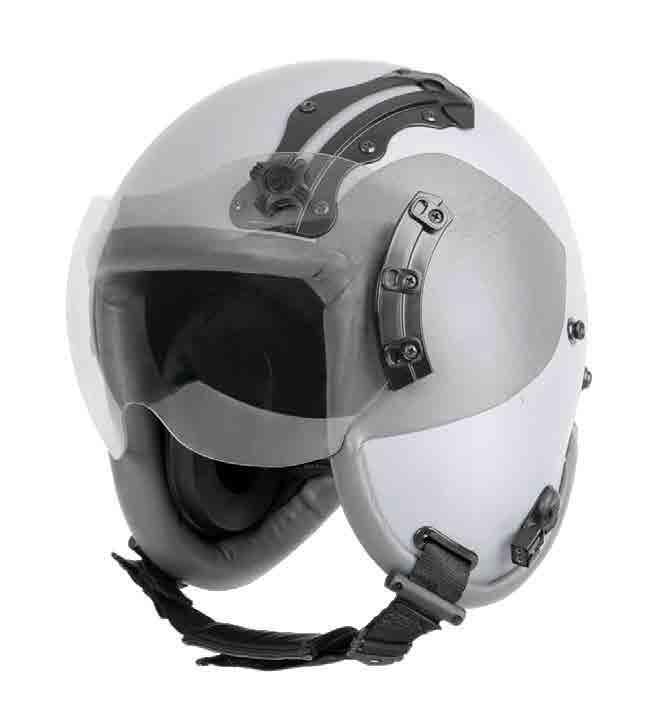



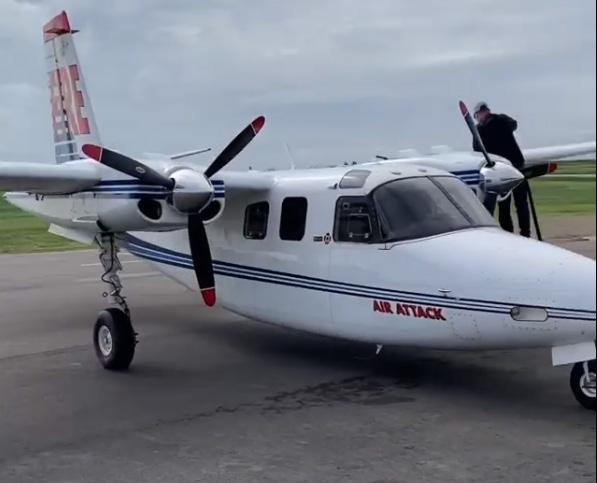
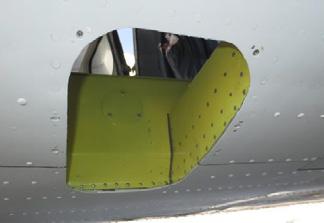

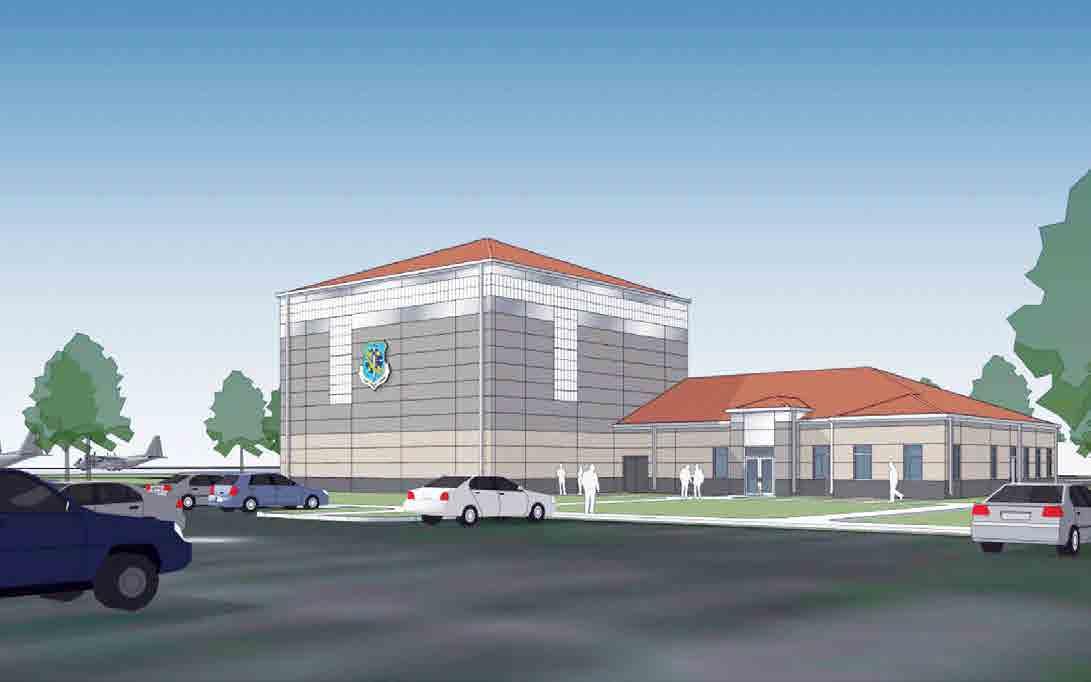 by Master Sgt. Nicholas Carzis, 146 Airlift Wing, Public Affairs, California Air National Guard
by Master Sgt. Nicholas Carzis, 146 Airlift Wing, Public Affairs, California Air National Guard
After a decade of planning and unforeseen impediments, including a worldwide pandemic, the 146th Airlift Wing held a groundbreaking ceremony to commemorate the start of construction for a state-of-the-art C-130J simulator site on Jan. 4.
The new simulator or Weapons System Trainer Reconfigurable C-130J flight simulator (WST 12R) will showcase numerous capabilities that will separate it from other simulators across the United States. One of the most significant benefits for California and the Air National Guard is the strategic placement of WST 12R at the Channel Islands Air National Guard Station.
Col. Lisa A. Nemeth, commander 146th Airlift Wing, said the new simulator’s training opportunities will be shared with the entire C-130J community, benefiting more units and providing more customizable training than any other C-130J simulator.
“This is an exciting day for the 146th Airlift Wing and the state of California,” Nemeth said. “Having this simulator here at Channel Islands will provide more efficient and realistic training for our aircrew, and as the C-130J Western Region simulator, it will also benefit other units from across the nation who will travel to Channel Islands for training.
“WST 12R will enhance and modernize how our aircrew accomplishes its training because it’s the first configurable simulator between the ‘HC’ and ‘Slick J’ C-130J aircraft variations that can also be rapidly configured to facilitate training for C-130J block enhancements for 6.0 and 8.1.”
Block enhancements refer to software and hardware capability expansions installed to enhance aircraft capabilities.
“WST 12R’s block enhancements with modular, rapidly configurable options will immediately benefit C-130J flying wings, including the aircrews from the California Air National Guard’s 129th Rescue Wing at Moffett Field, which operates HC-130J Combat King II aircraft,” said Nemeth.
Col. Christopher Dougherty, vice commander 146th Airlift Wing, said there the simulator saves costs and improves training for the wing’s aerial firefighting mission.
“Based on historical data, we predict that WST 12R will significantly reduce the travel, fuel and training traveling costs by an estimated $6.3 million annually,” Dougherty said. “In addition, we’re excited to gain the first-of-its-kind MAFFS (Modular Airborne Fire Fighting System) training profile. Lastly, this simulator will virtually connect to other simulators and training locations to conduct formation airdrop training over a secure network.”
The MAFFS mission is a partnership and joint effort between the U.S. Forest Service and the Department of Defense that began in 1971 to integrate military air tankers into a national firefighting response.
Dougherty says WST 12R will debut as the first MAFFS virtual training simulator, providing functional training scenarios for aircrew preparing to fly aerial wildfire suppression missions.
“These training profiles will closely simulate flight, weight and atmospheric conditions that MAFFS aircrews encounter during wildland fire suppression efforts. The new simulator will give aircrews the skills to manage emergencies with more proficiency and success, thereby improving safety and mission accomplishment,” said Dougherty.
The fully compliant Digital P25 TDFM-136B series radios offer a critical piece of your fleet’s communication and coordination efforts. Call today to learn why Technisonic has more forest service certified airborne radios than any other manufacturer.
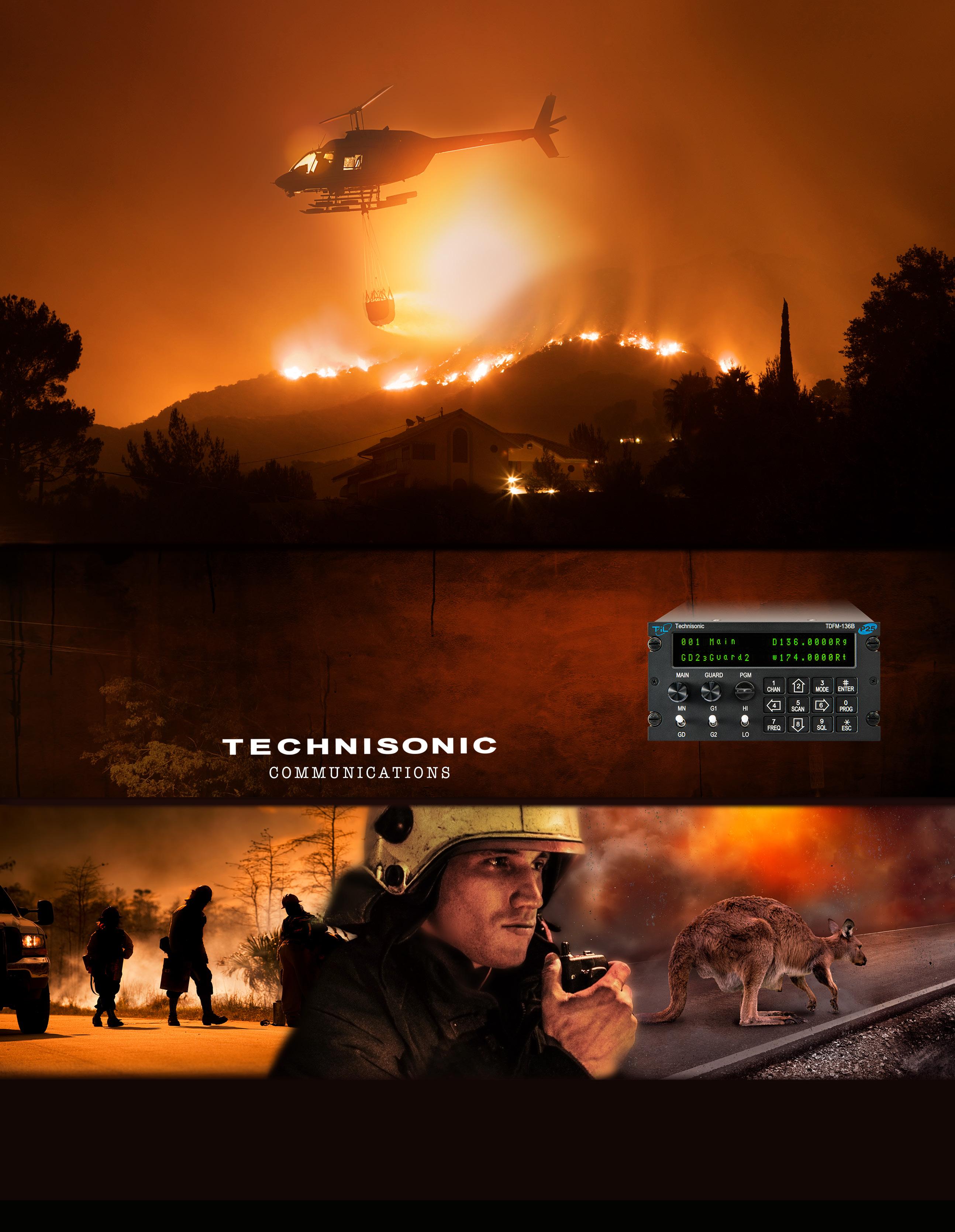

Aerial Firefighting 2023 is finally here. If you are in Seattle for the show, we hope to see you at booth 303. If not, take a look at the agenda and map that details all of the events and vendors that will be exhibiting at this year’s show. We hope to see you at a show soon and look forward to plenty of information about the Seattle show in the next issue of AerialFire!














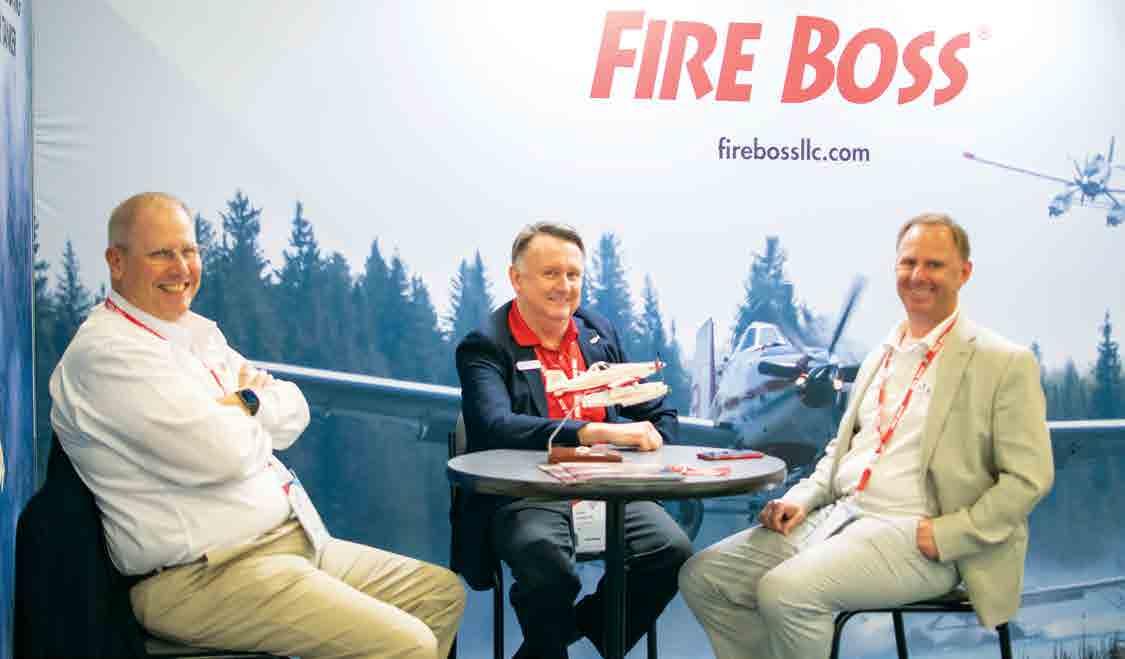
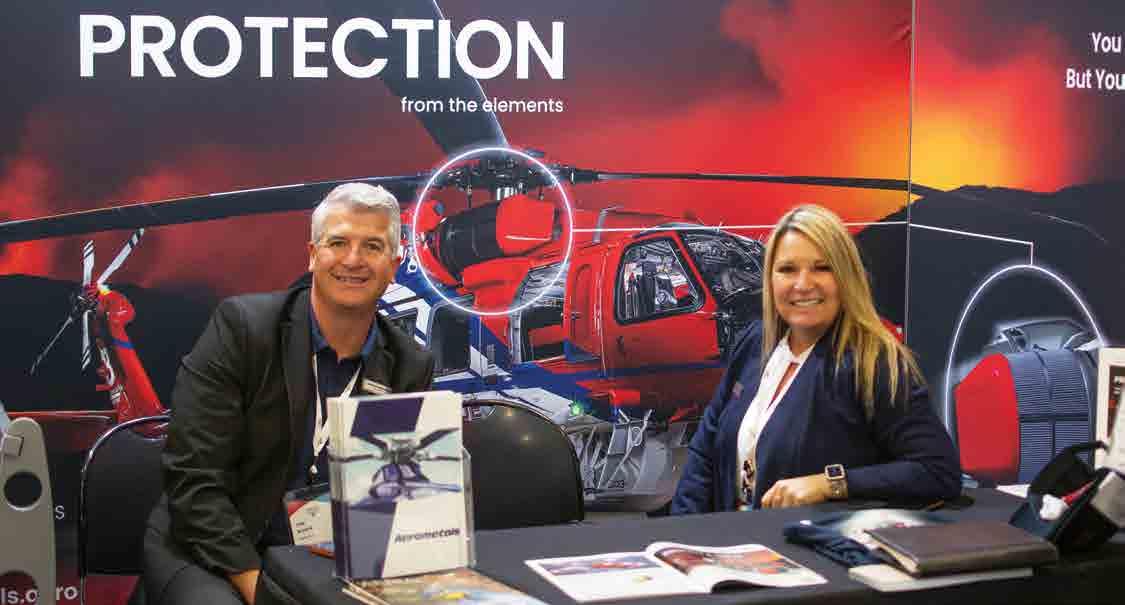
Registration & Exhibition
Moderator’s Opening Remarks – Glenn Farley, USA
Welcome Address – Rich Elliott, National Wildland Policy Coordinator, International Association of Fire Chiefs / Deputy Fire Chief, Kittitas Valley Fire & Rescue, USA
Keynote Address – Hilary Franz, Commissioner of Public Lands, Washington State Department of N atural Resources, USA
Panel - Leadership:
Moderator: Hilary Franz, Washington State Department of Natural Resources, USA
Panellists: Governor Kate Brown , Former Governor of Oregon (2015-2023), USA
Rich Elliott, National Wildland Policy Coordinator, International Association of Fire Chiefs , USA
George Geissler, Wildland Fire Committee Chair, National Association of State Foresters/Stat e Forester, Washington State Department of Natural Resources , USA
Refreshment Break & Networking (sponsored by Aero-Flite)
Panel – Landscape Resilience:
Moderator: Professor Jon Fink, Director, Digital City Testbed Center, Portland State University, USA
Panellists: Dr. John Kitzhaber, Former Oregon Governor, USA
Mindy Crandall, Assistant Professor Forest Policy, Oregon State University, USA
Indroneil Ganguly, Associate Professor, University of Washington, USA
Dr. Harry Nelson, Associate Prof., Faculty of Forestry, University of British Columbia, Canada
5W: The West’s Web of Wildfire, Water & Weather – Kate Dargan, Senior Wildfire Advisor, Gordon and Betty Moore Foundation, USA
Redefining the Role of Aviation & Working Through the Use of Aircraft During Night -Time Operations –Brian Fennessy, Fire Chief, Orange County Fire Authority, USA
Lunch Break & Networking (sponsored by Aero-Flite)
Panel - Applied Recent Learning
Moderator: Glenn Farley, Former Broadcast Journalist, USA
Panellists: Washington State Colorado State Idaho State Montana State Oregon State
Panel – Detection & Suppression
Moderator: TBC
Panellists: Tim Sheehy, Chief Executive Officer, Bridger Aerospace, USA
Russ Lane, Wildfire Division Manager, WA Department of Natural Resources, USA
Greg Davis, Founder & CEO, Overwatch Imaging, USA
Refreshment Break & Networking (sponsored by Aero-Flite)
Panel – Community Health & Resilience
Moderator: Washington American Indian Health Commission, USA
Panellists: William Nikolakis, Gathering Voices Society, Canada
Laura Rivera, Environmental Justice Coordinator, Community for the Advancement of Family Education (CAFE), USA
Derrick Belgarde, Executive Director, Chief Seattle Club, USA
Moderator’s Closing Remarks
1630 - 1730 Drinks Reception (sponsored by Fortress North America)
1830 Coaches Depart for the Museum of Flight
1900 Event Dinner (sponsored by Bridger Aerospace)
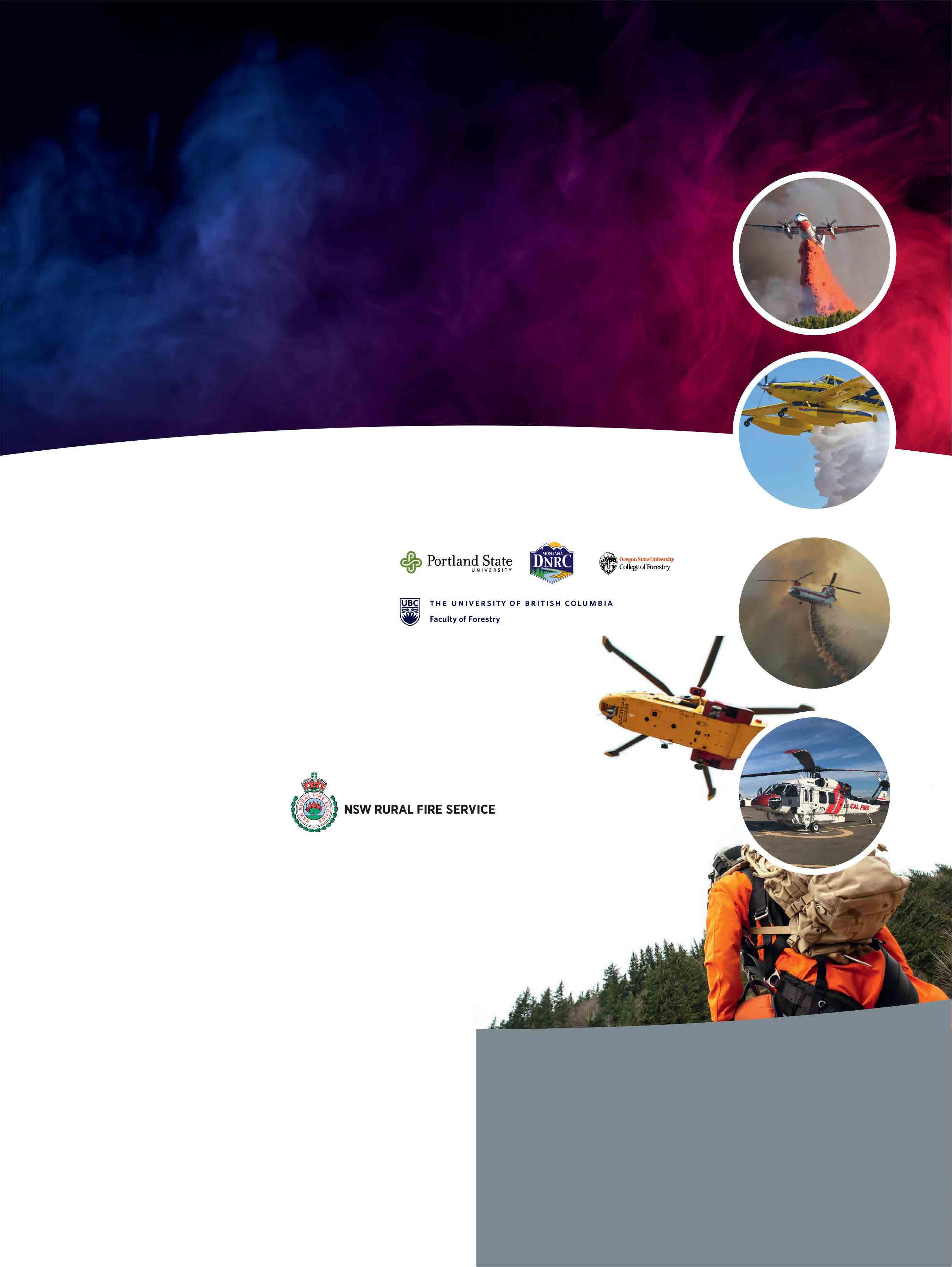

Starting as an aircraft engineer with Australia’s Ansett Airlines in the mid-1970s, John McDermott could not have imagined that a few decades later, the company he founded would be one of the leading aerial firefighting companies in Australia, with the largest Bell 214 fleet in the world.
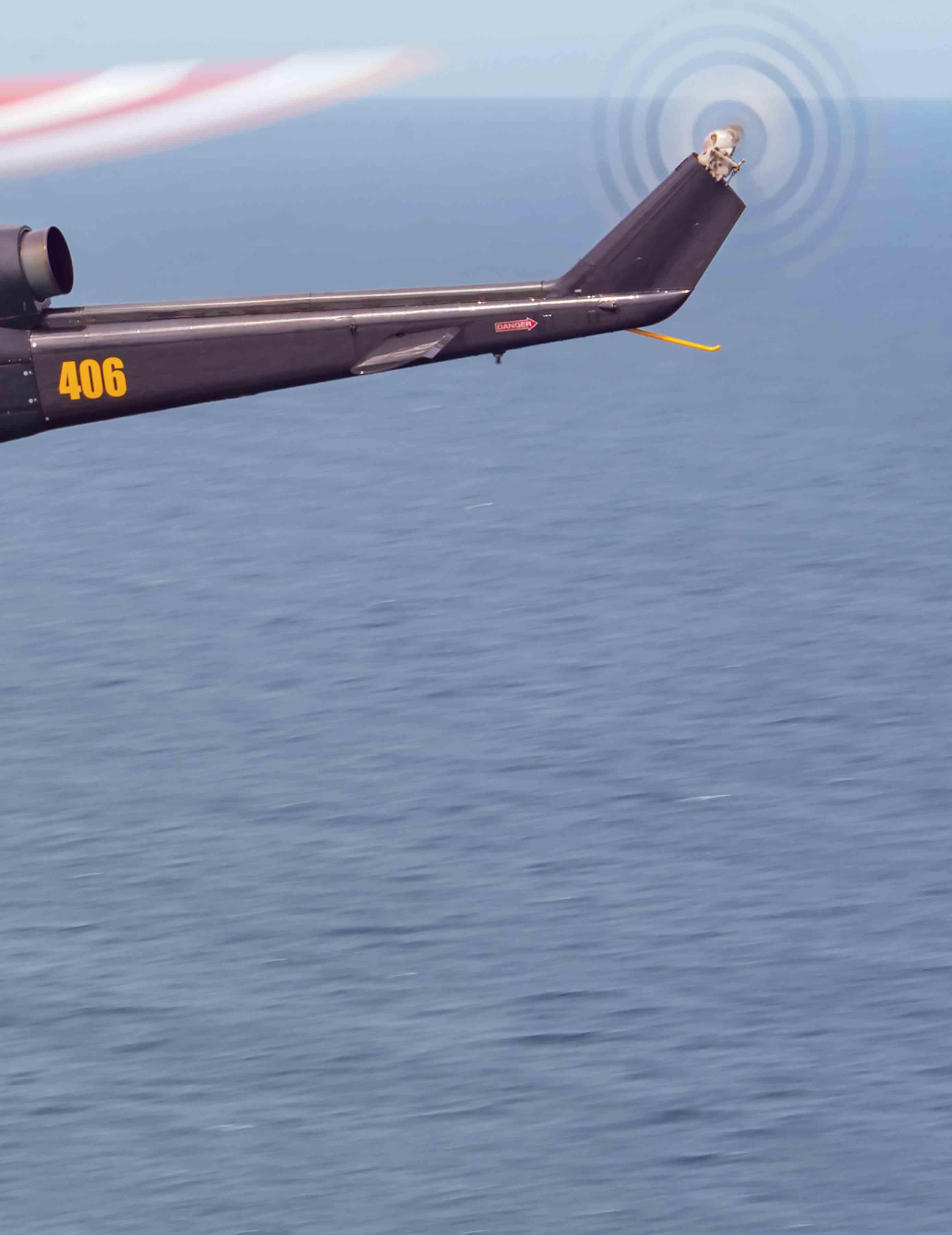
The McDermott Aviation story started as John began flight training as a hobby in airplanes during his apprenticeship. After completing his apprenticeship with Ansett, knowing he loved aviation but didn’t love working for an airline, it was time for a break, so in 1977 he and Linda, his wife, took off for Europe, Backpacking around to see the sights.
During a boat trip down the Moselle River at the age of 21, he saw a Bell 47 spraying grapevines and decided that that was what he wanted to do as a job. Knowing that helicopters were the more expensive option, he continued with his fixed-wing license to obtain experience in fixed-wing agricultural spraying before making the segway into helicopters.
Upon returning home, John found a Cessna 185, which he purchased sight unseen with his flight instructor. When they arrived at the aircraft in Cairns, it was discovered that it needed lots of work, which he completed, bringing it to airworthy status and using it to obtain his commercial pilot rating.
His first role in the Ag business was with Super Spray, a Victorian company owned by Roy Robertson, where he obtained his ag rating. McDermott then moved on to his next role, flying a Piper Pawnee and an Ag Wagon in Western Australia.
He returned to Victoria in 1980 for another spray season in the southern state before converting to helicopters as the first commercial pilot trained by Ron Newman and the now large-scale Moorabbin, Victoria-based helicopter training company Professional Helicopter Services (PHS) learning in the Schweitzer S300, which incidentally was also the same aircraft type that he completed his first spray job for after relocating to Queensland. ➤
Story and Photos by Ryan MasonAfter converting his ag rating from fixed wing to helicopter, John began working for a company called Heli Work before eventually going out on his own in 1984 as McDermott Aviation - working as a contractor for East Coast Helicopters, which would see him work multiple spray seasons in Scotland as well as Australia.
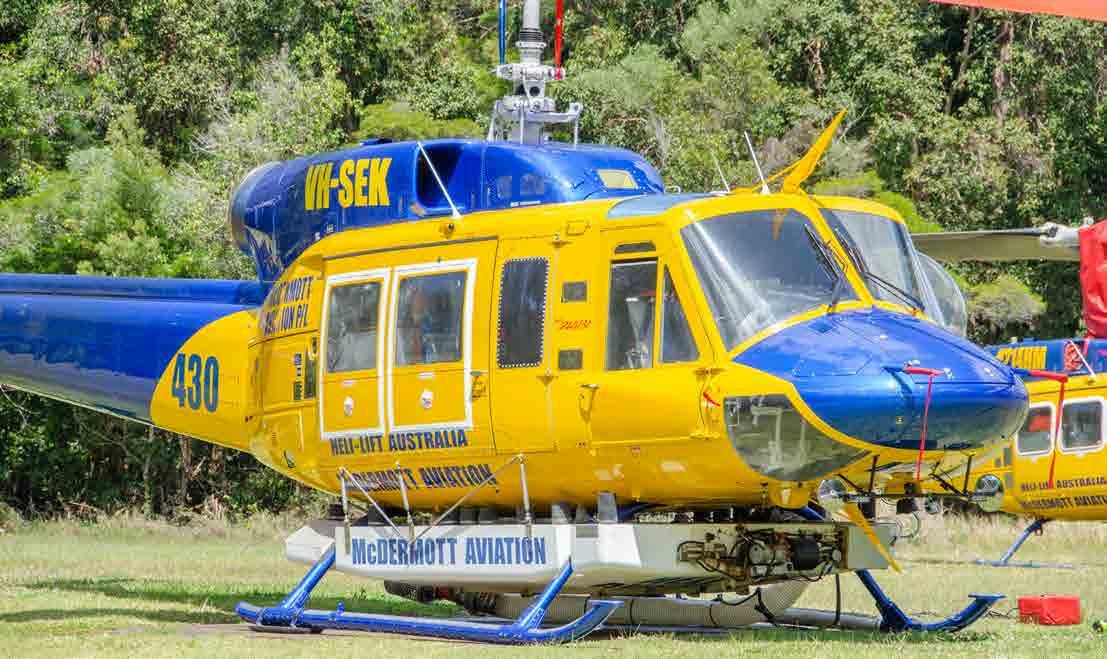
In 1988, John continued contracting with Chopperline during Australia’s World Expo before leasing the Scottish S-300s in 1990 and returning it to Australia to become the company’s first aircraft under the banner of McDermott Aviation.
In 1991 the company commenced its first firefighting operations from its base in Cooroy, Queensland, in a Bell Jetranger using the spray tank with the dump doors, which in his admission, was “pretty ineffective” at the time but was better than nothing.


The company then continued to grow over the next several years, doing a mix of ag aviation, spraying fungicides and herbicides, mosquito spraying, and forestry work in addition to firefighting work, which the company still does today.


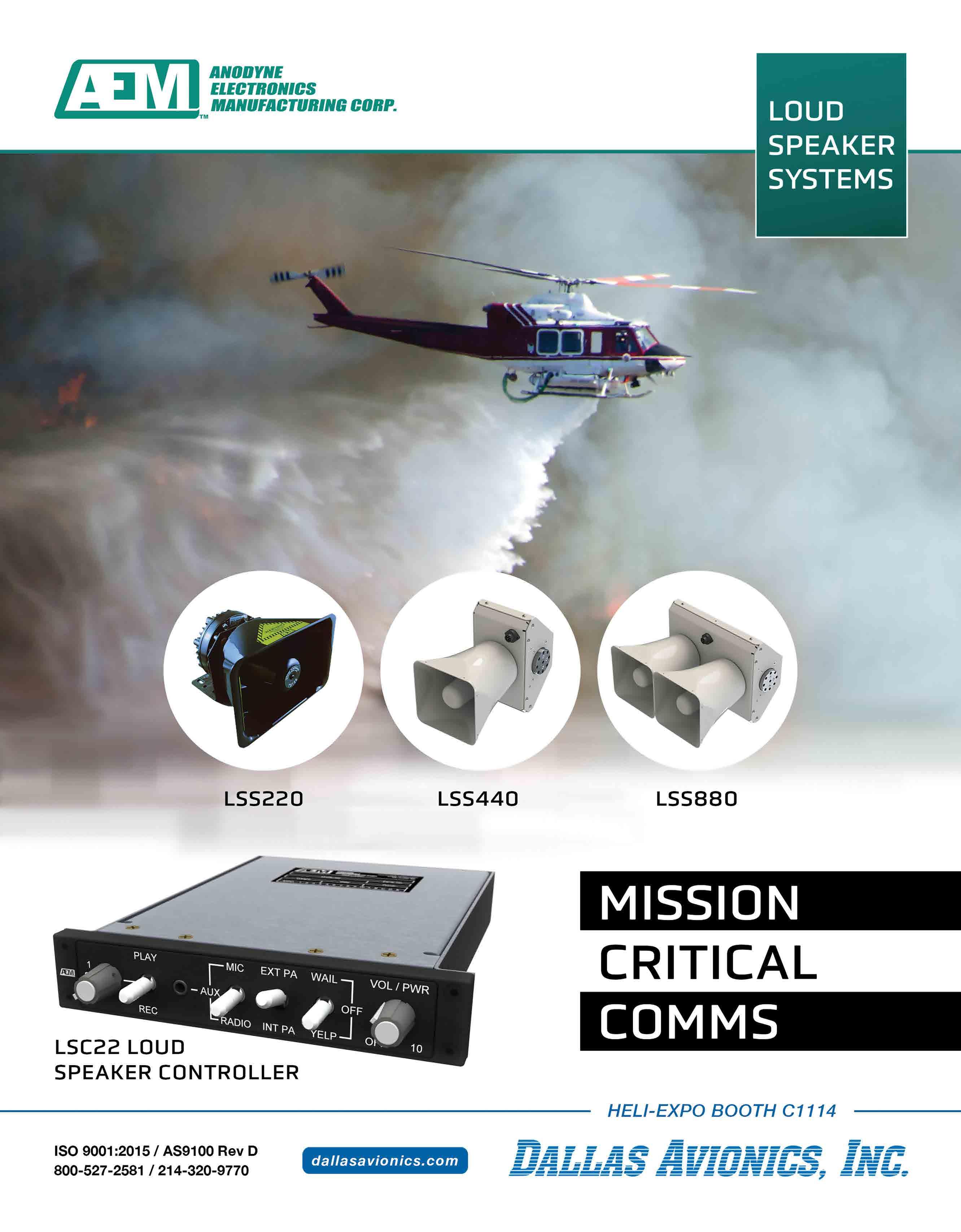
In 1996 the company started to obtain a lot more preplanned forestry work, which led to the need to obtain larger aircraft to handle the workload, the first two of which were the TH-1F, the air force variant of the UH-1B, obtained from Davis Monthan Air Force Base the United States that began arriving in 1998, filled by a further five of the same aircraft, in addition to the four Soloy-Bell 47T aircraft the company used for ag spraying as the company continued its rapid expansion in the 1990s.
The new TH-1F aircraft were quickly fitted with Isolair spray tanks and put to work to keep up with the rapidly increasing demand to deal with noxious weed spraying in the country’s north as the new larger airframes were able to do an area two and a half times bigger than the Bell 47T could cover in the same amount of time.
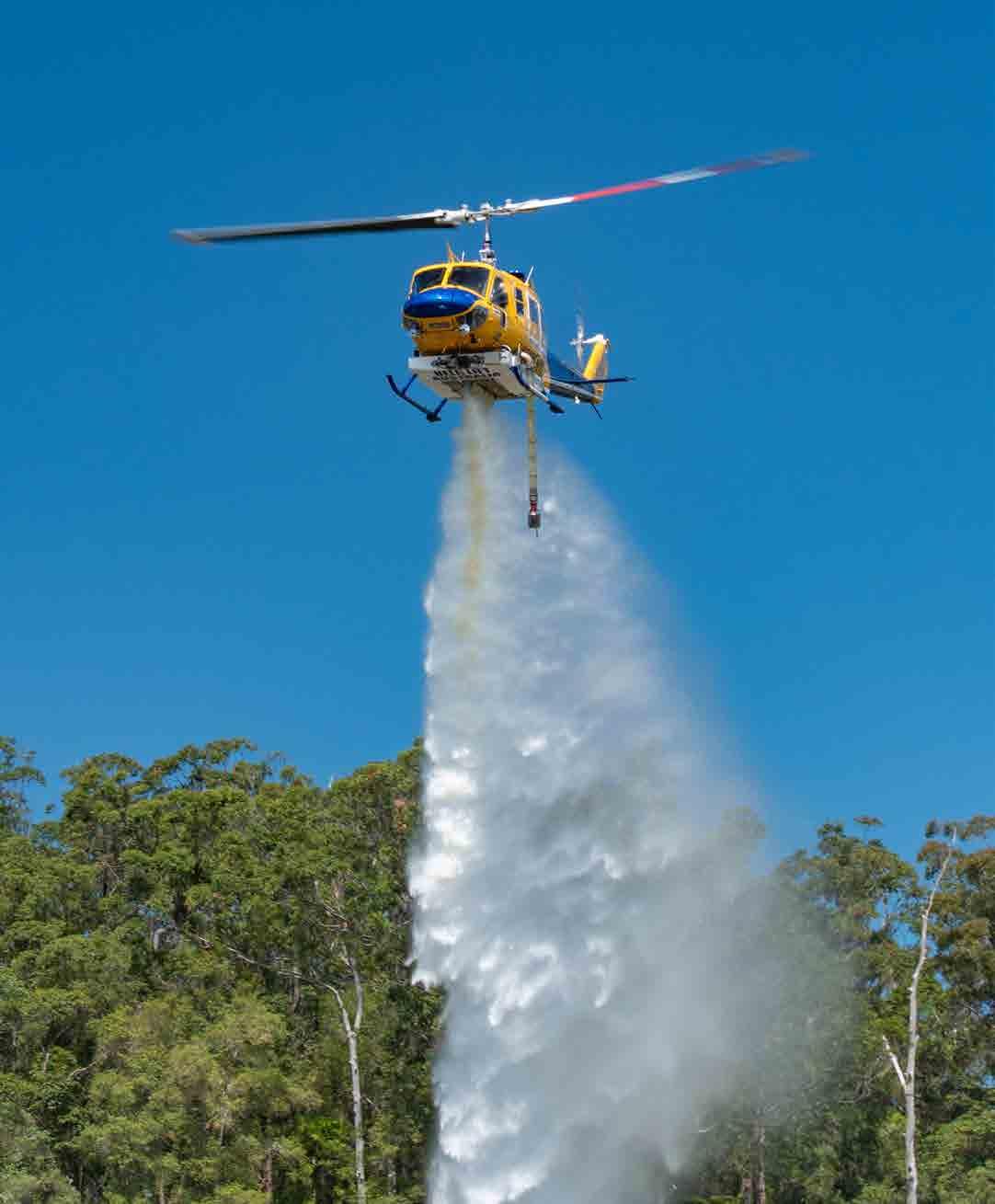
In 2000, fire seasons were escalating in a way not seen since the 1980s in Australia, specifically in New South Wales, which led to the first time that multiple assets from McDermott were requested to fight fires simultaneously. John quickly dispatched three of the company’s Huey fleet, one with a fire tank and two with buckets to fight fires, putting hundreds of hours on each aircraft that year, which was soon repeated in 2001. ➤
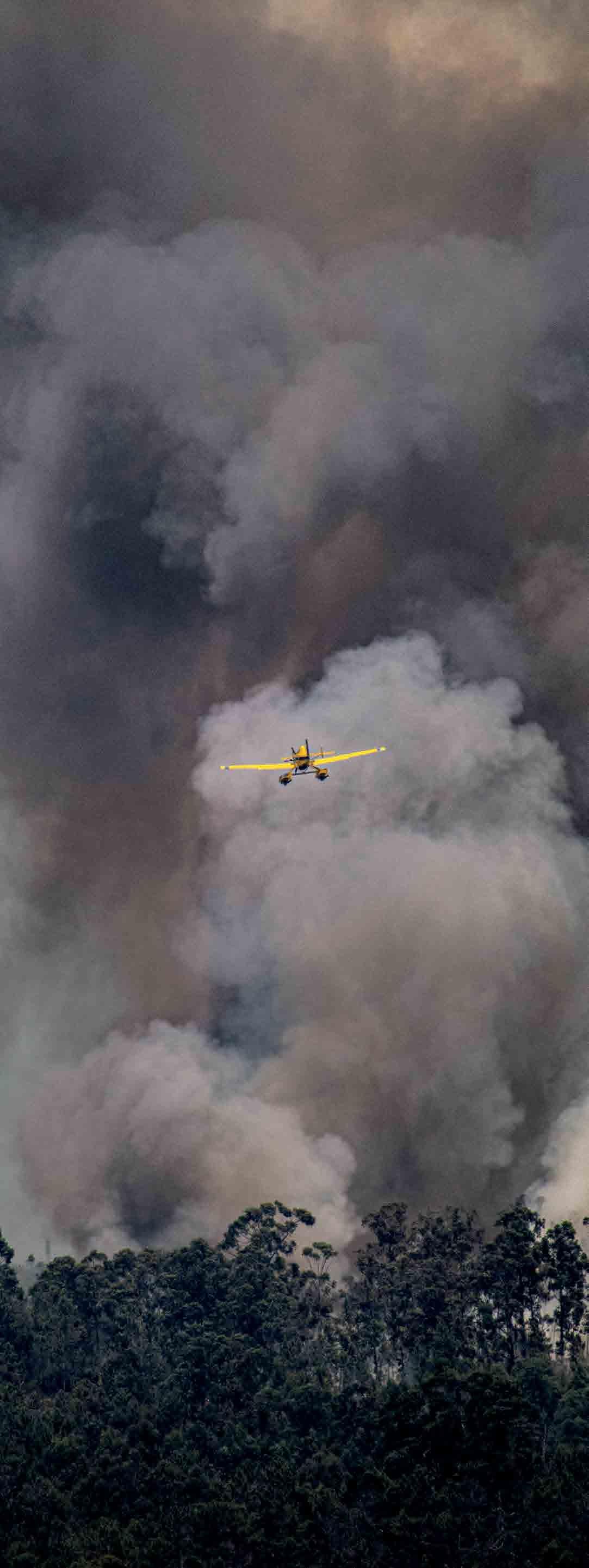


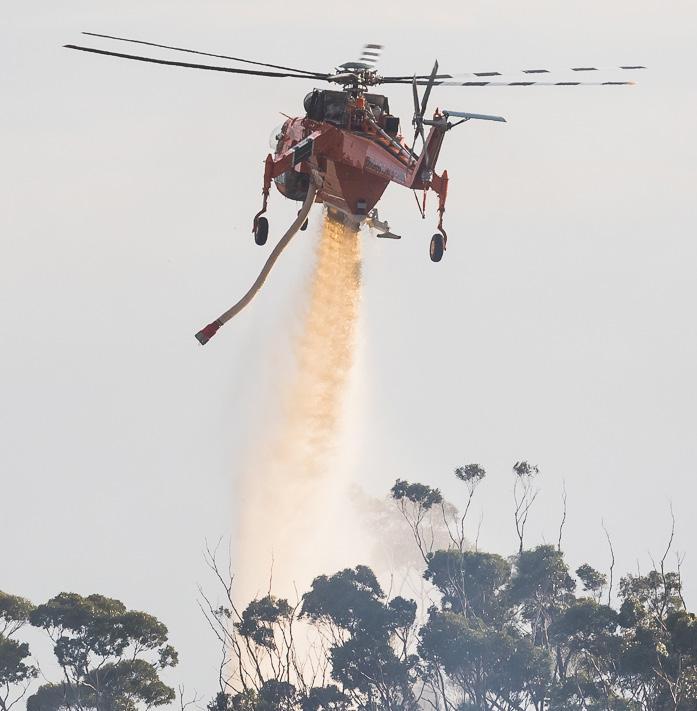



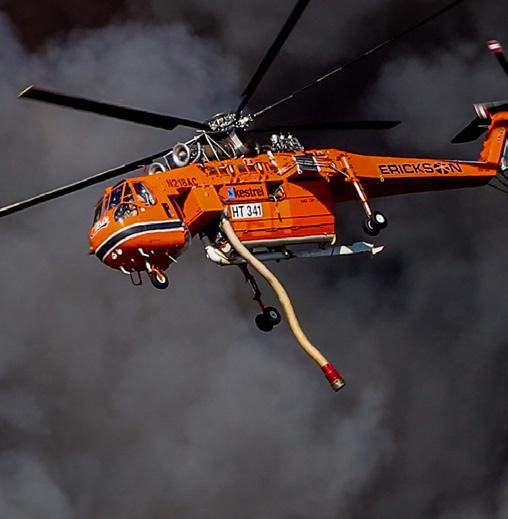
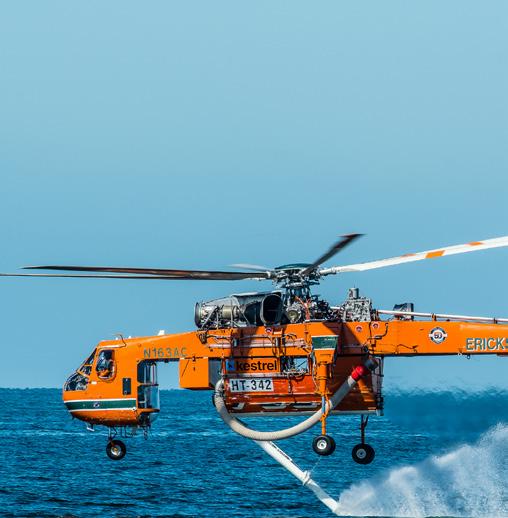



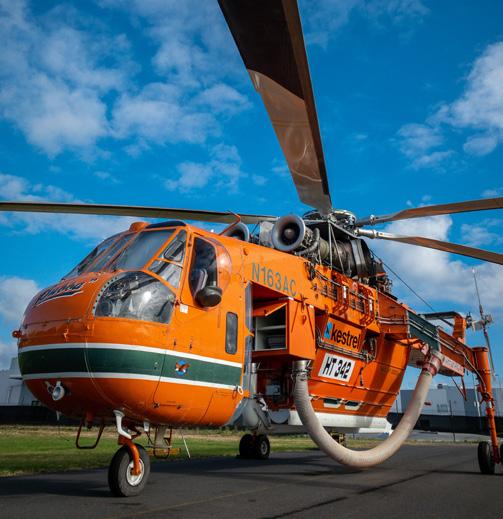
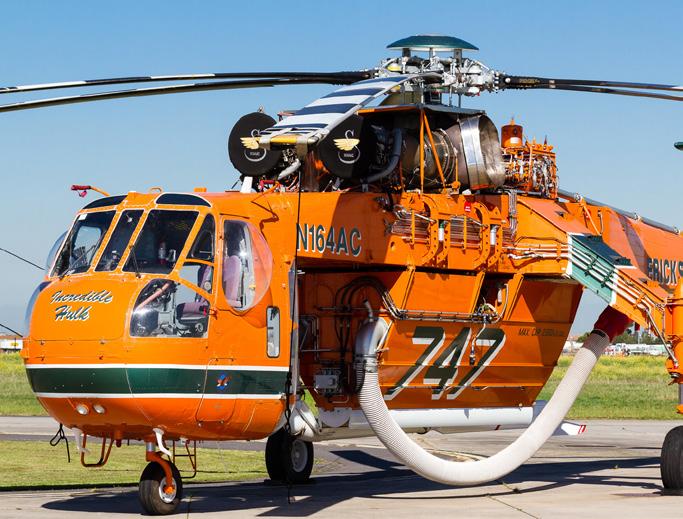
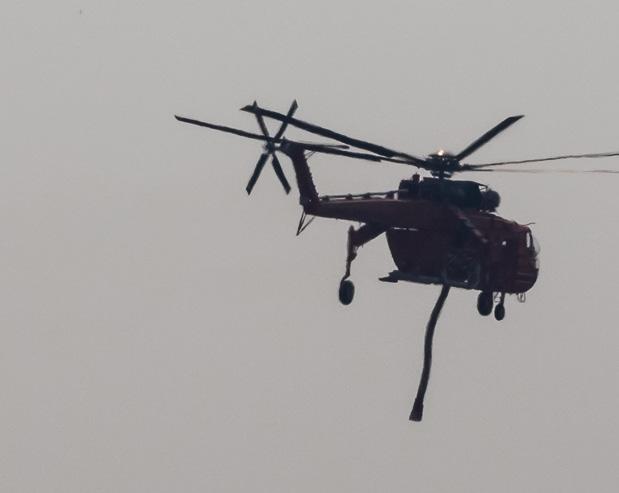

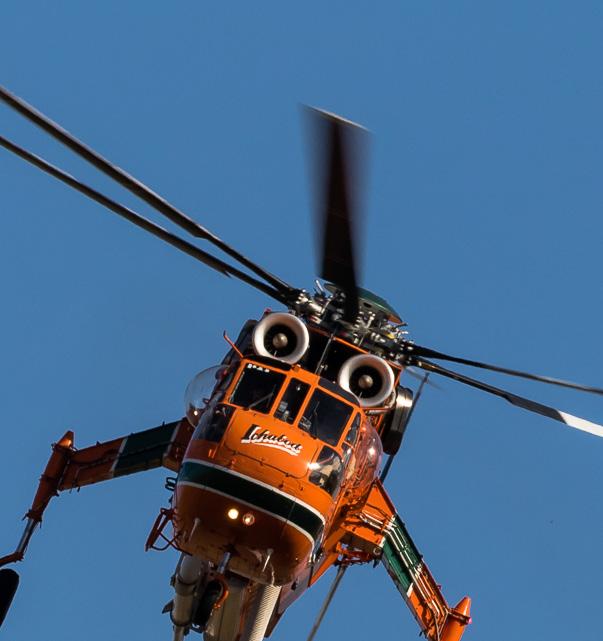
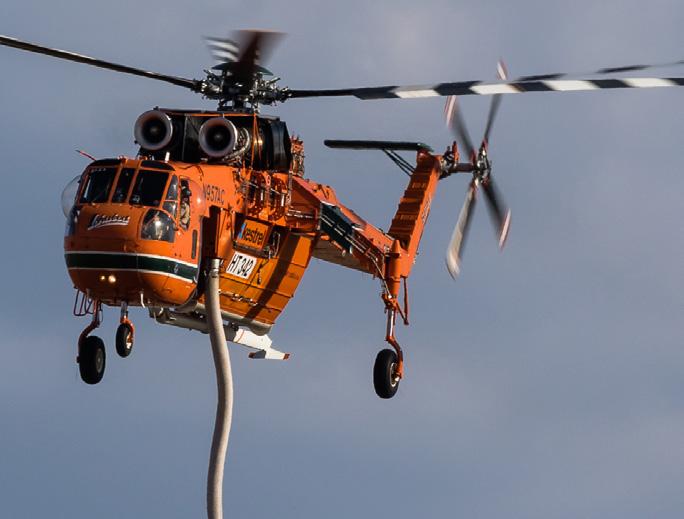
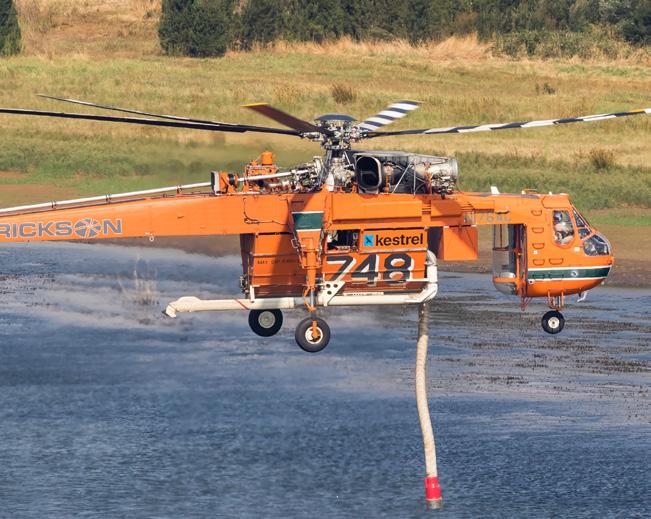
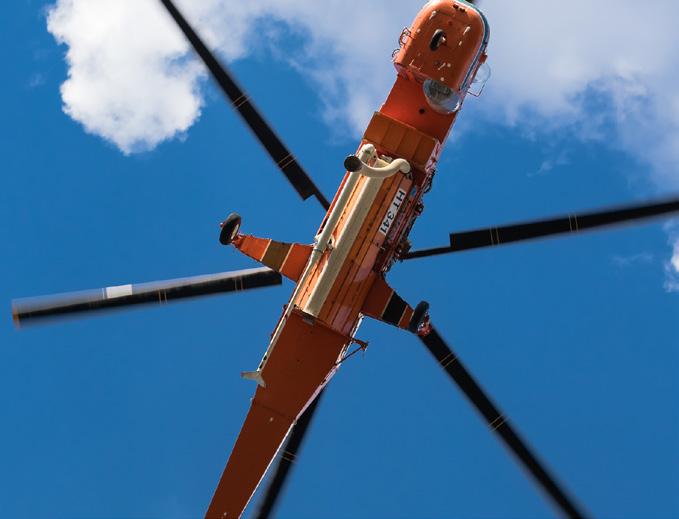
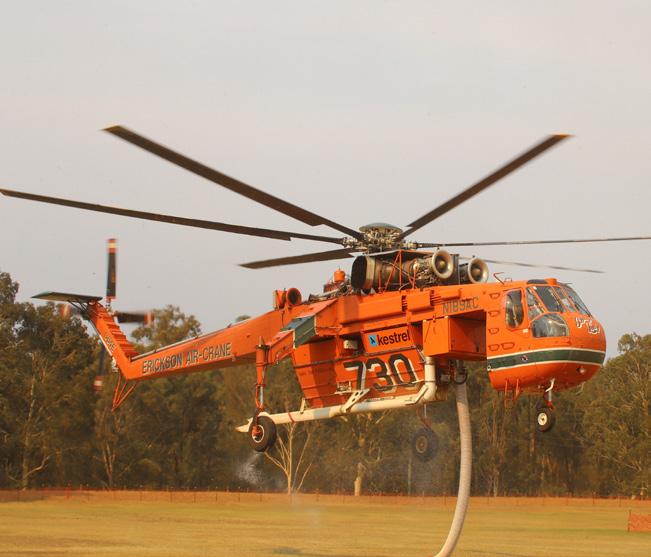
SINCE 1997 AND COUNTING
Dive into 25 years of partnership, collaboration, and dedication to the mission of saving lives and property throughout Australia.
To learn more and download the brochure, visit: pr.ericksoninc.com/aus25-aff

The increase in firefighting work was starting to impact the company’s ability to meet goals in their existing forestry work, which meant further expansion for McDermott. John realized the need for something on the firefighting side that would be bigger than the Huey but smaller than the giant Erickson AirCrane regarding water capacity and the ability to carry crew—settling on purchasing five Bell 214B helicopters from Oman, unintentionally starting the acquisition of a commercial fleet of Bell 214 B’s that is now the largest in the world.
The acquisition of the 214B and the need for them to be effective pushed John and his friend Michael Powell from Isolair to design and build a purpose-built firefighting tank for the helicopter that is still in use today (>370,000 water drops to date) along with the Helitak tank used on some aircraft in addition to the Isolair tank. In addition to the tank, McDermott also developed and certified high skids for the 214B to accommodate sufficient ground clearance of the tank system.
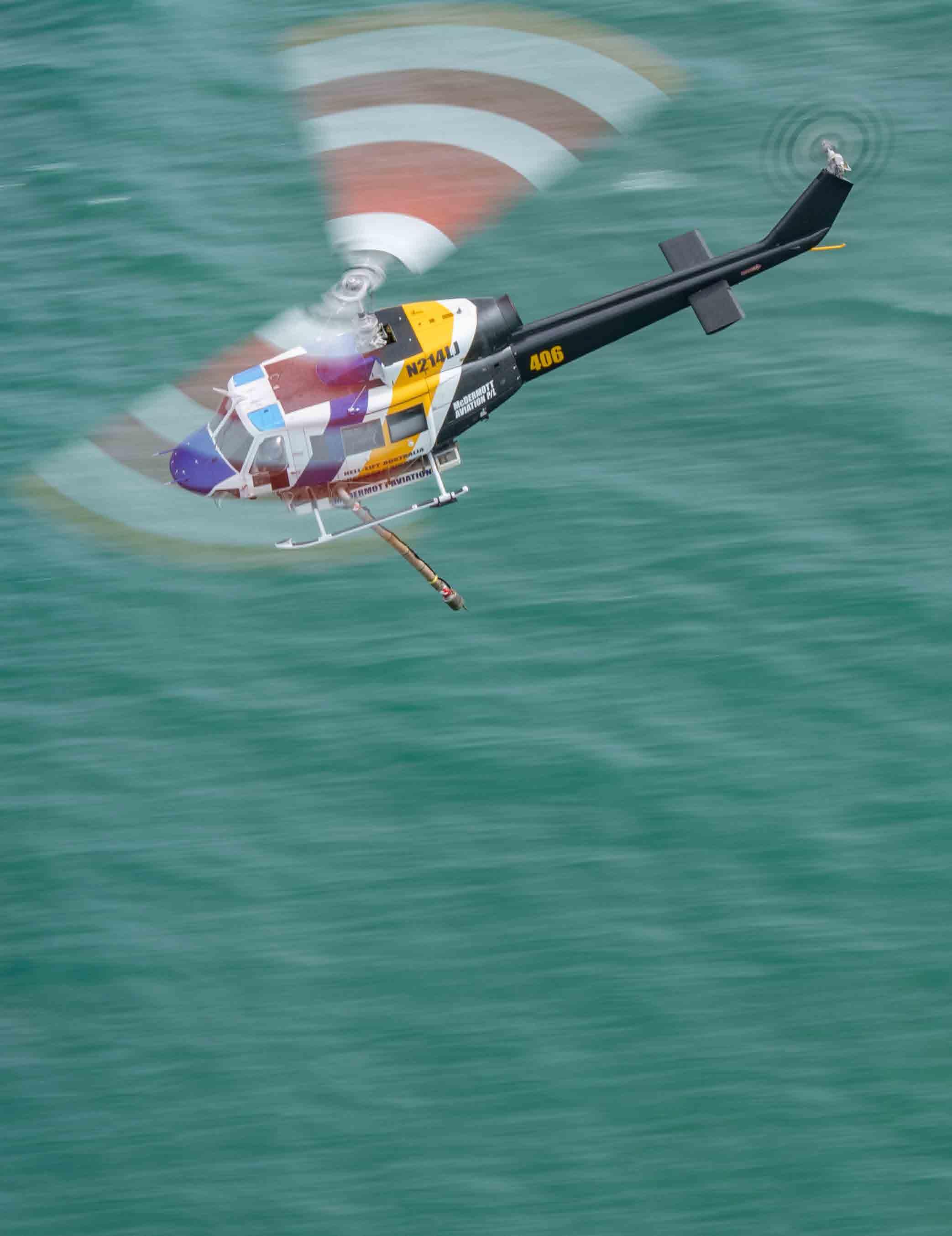
The additional work completed by John and his team was quickly rewarded when in 2003, McDermott Aviation was awarded five contracts for work in Victoria, New South Wales, and South Australia during the first contract awards given out by the newly stood-up National Aerial Firefighting Center (NAFC), which was created to award contracts and later to coordinate the distribution and operations of aerial assets around Australia.
The creation of NAFC and, in turn, firefighting contracts enabled operators to have the stability of solid financial support that could be counted on when spending several million dollars on new aircraft ahead of a fire season. In contrast, previously, the federal government at the time had no contract support, which made operators weary of spending money without guaranteeing a return on their investment.
Never one to keep an aircraft idle, the rapid expansion of the McDermott fleet was noticed, and requests were made for their aircraft to assist the fire season in 2004 in Spain, Canada, and Portugal. ➤
The Bell 214B aircraft is used in Australia and in overseas deployments by McDermott Aviation.




The 2005 season, however, saw NAFC award more contracts to offshore operators, allowing McDermott further overseas expansion, sending an aircraft to New Caledonia, a contract that lasted for fifteen years; the company also added work in Indonesia in 2015 and fire operations in Greece in 2020.
As with any growing company, especially one that moves large pieces of equipment around the world, McDermott Aviation is familiar with difficulties in logistics, the largest of late being the cost of freighting aircraft around the world. “We used to get upset about it costing us $80,000 to air freight a Bell 214B in a 747 halfway around the world, but prices have
skyrocketed recently, where it can cost us $500,000 to sea freight an aircraft now from our base to an overseas location,” said John.
With Australian pilots operating aircraft worldwide, COVID-19 posed a significant problem with staffing, requiring crews to stay overseas for an entire season. Now that issues with COVID have passed, staff now spend four to six weeks at a time on location. Additionally, some chose to stay the entire time, and some took the opportunity to bring their families with them for the entire duration of tours in Greece for the fire season. ➤
 Pilots for the Bell 214B and the rest of the McDermott fleet are selected from a pilot base that already has several thousand hours of flight time.
Pilots for the Bell 214B and the rest of the McDermott fleet are selected from a pilot base that already has several thousand hours of flight time.
Dauntless Air is an aerial firefighting company deeply dedicated to winning the wildfire missions we undertake.
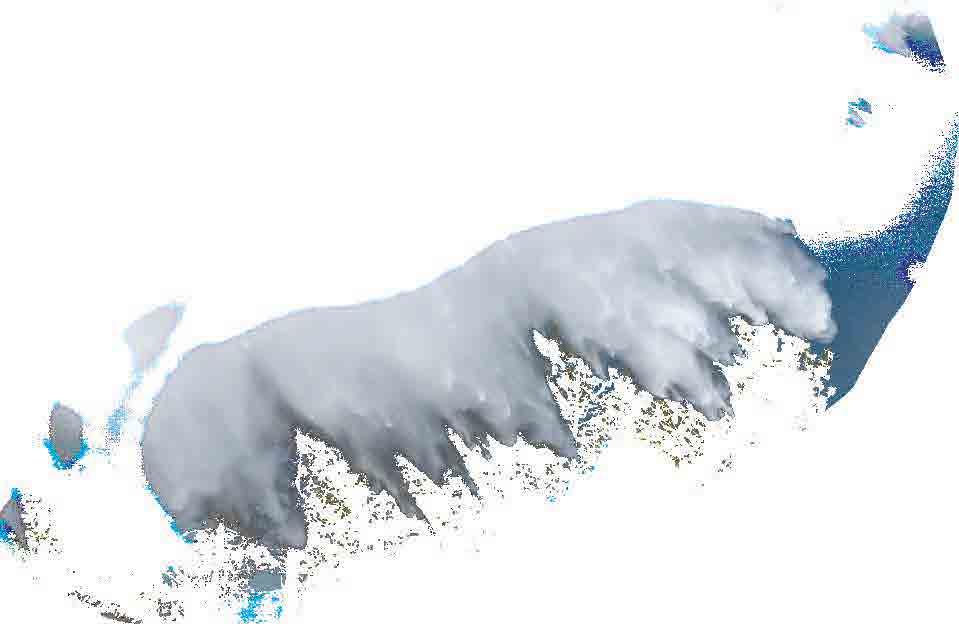
Armed with the largest and most technologically advanced Fire Boss fleet in North America, we work in close coordination with wildland firefighters on the ground and other aerial forces to help contain fires faster, so they can’t grow into large and costly disasters.
Learn more about the Dauntless Fire Boss advantage at dauntlessair.com/our-fleet

In addition to five Bell 47 T’s and five Bell 206L3, eight AS355s that can work ag or provide imagery or air attack duties, and eight AS365s working search and rescue-based missions SIG ops and firefighting at various locations around Australia equipped with 1000 liter tanks. McDermott Aviation now has fifteen Bell 214B aircraft and fourteen Bell 214ST models, comprising the largest fleet of Bell 214s in the world owned by a single operator. The Iranian Military is the only other operator in the world with more aircraft. McDermott Aviation also houses the most extensive spares inventory for both 214 models in the world at their Cooroy-based headquarters, where most of all Heavy maintenance work is completed. Sunshine coast facility is responsible for all Airbus fleet maintenance, with the company having a significant

MRO operation in Jandakot, Western Australia, to maintain the West Australian-based fleet. We have a well established field maintenance capability to provide all in-field support when aircraft are at work overseas.
While pilots in Australia require different hours to qualify for specific roles, John McDermott says that his pilots are very much a mixed bag, with about 90% of his ag pilots being trained in-house to do ag work after working commercially elsewhere in the industry for one to two thousand hours before joining the company. “You have to want to do ag passionately. Flying ag is not for people in this industry that want to build hours,” John stated.
McDermott Aviation aircraft in addition to aerial firefighting operations are also used for disaster relief operations and agricultural operations.Ag work and aerial firefighting are treated very much the same in the eyes of safety by McDermott Aviation in that both sectors of the business put just as much work into checking each area they fly for obstacles and anything that could cause adverse results. It may be ground firefighters at risk and obstacles like powerlines. In contrast, in ag, company pilots must perform reconnaissance flights, not just for obstacles like powerlines, but proximity to other fields, wildlife, or even national parks and protected species.
“The workload for ag is exceptionally high. So again, it’s something you’ve got to want to do. That’s why wanting to do aerial firefighting should be the same. In aerial firefighting, there are fewer flying hours in a day. In firefighting, you get big breaks and can be on different fires, so it’s a different level of stress and risk. We train our aerial firefighting guys the same way we train our ag pilots. We ensure that you treat the fireground like an ag spraying contract. So you do a thorough survey of the area to find as many obstacles as you can. We spend as much time as needed in a training environment to mitigate dangerous risks.” ➤
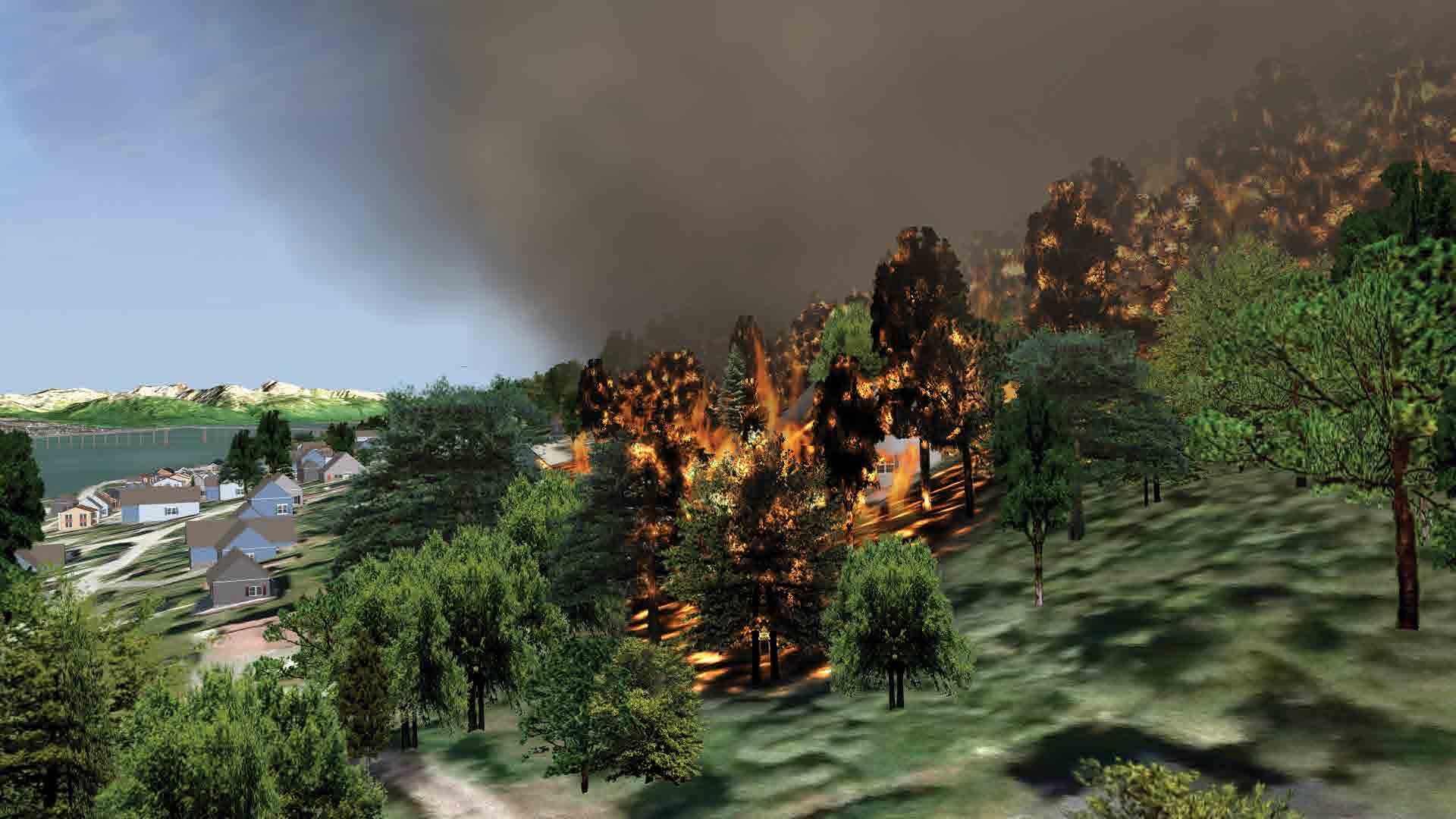

● APPROVED AROUND THE WORLD!
● PILOT IS ALWAYS IN CONTROL


● REDUCED PITCH - UP
● SIMPLE, USER FRIENDLY & RELIABLE


● SHAPE, SIZE AND DENSITY OF THE DROP PRODUCED TO MAXIMIZE FIRE CONTROL
● FULL SALVO DROP IN LESS THAN 2 SECONDS
● 4 LEVEL DUMP CONTROL
● APPROVED ALL MODEL OF AIR TRACTOR & THRUSH 660/710
● 20 YEARS PROVEN TRACK RECORD OF RELIABILITY & SAFETY

Unlike training in the United States, check rides are not completed by a government agency like the USFS or state agencies in Australia, so the operator in Australia gives the bulk of the training, other than an aerial firefighting rating. Companies like McDermott take that responsibility seriously, putting each new aerial firefighting pilot through a complete syllabus of training requirements for each aircraft, utilizing both buckets and tanks for training so that pilots are wellrounded on all aircraft, culminating with a yearly checkride with John McDermott himself for each pilot to evaluate each pilots skills and competency continually. ➤

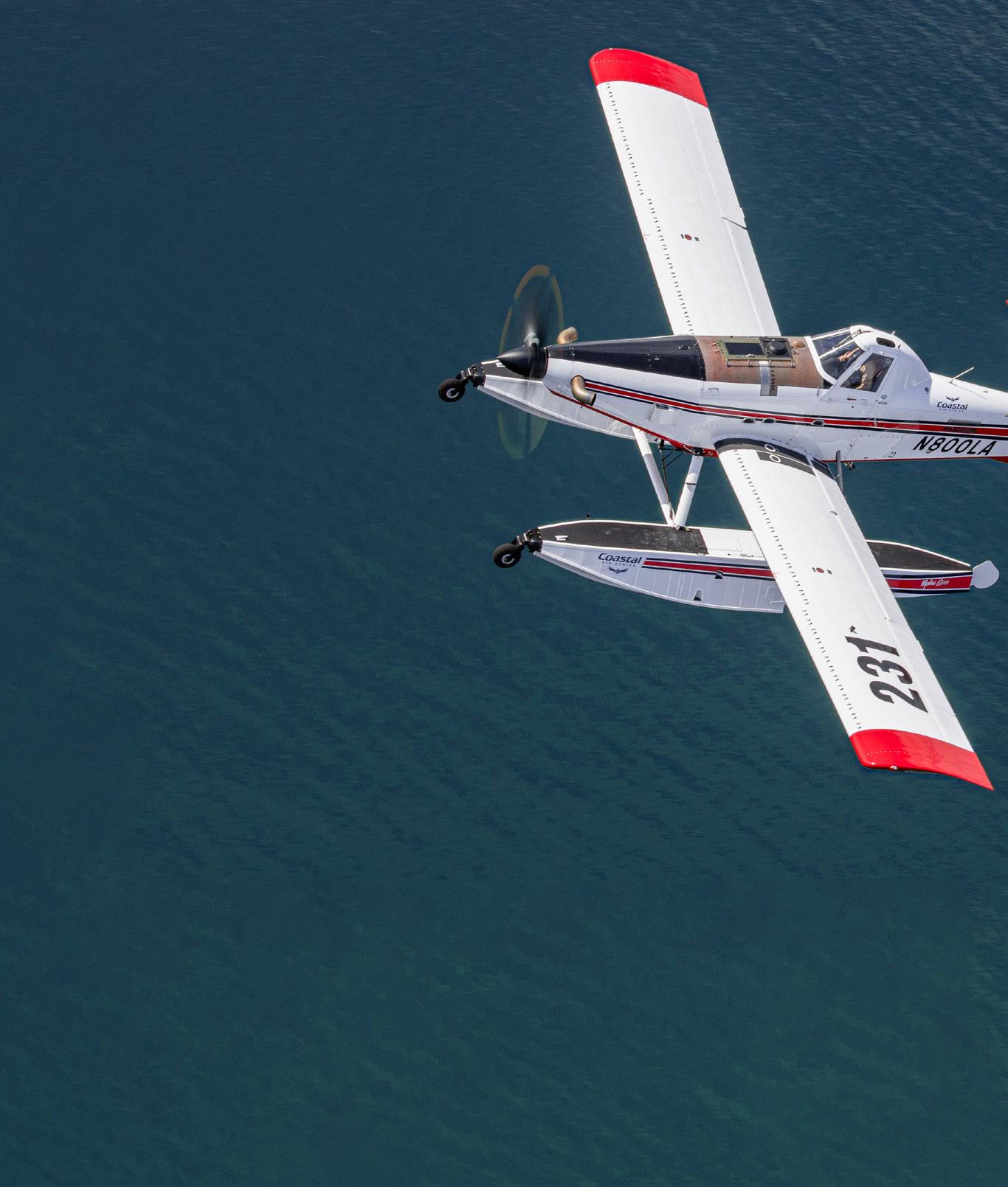
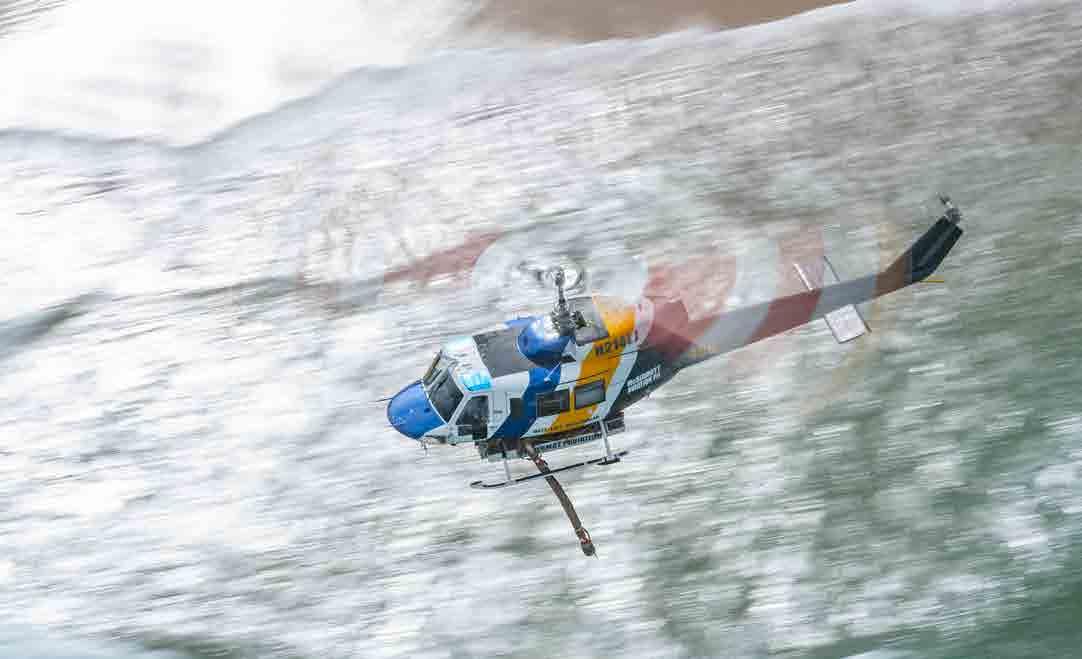
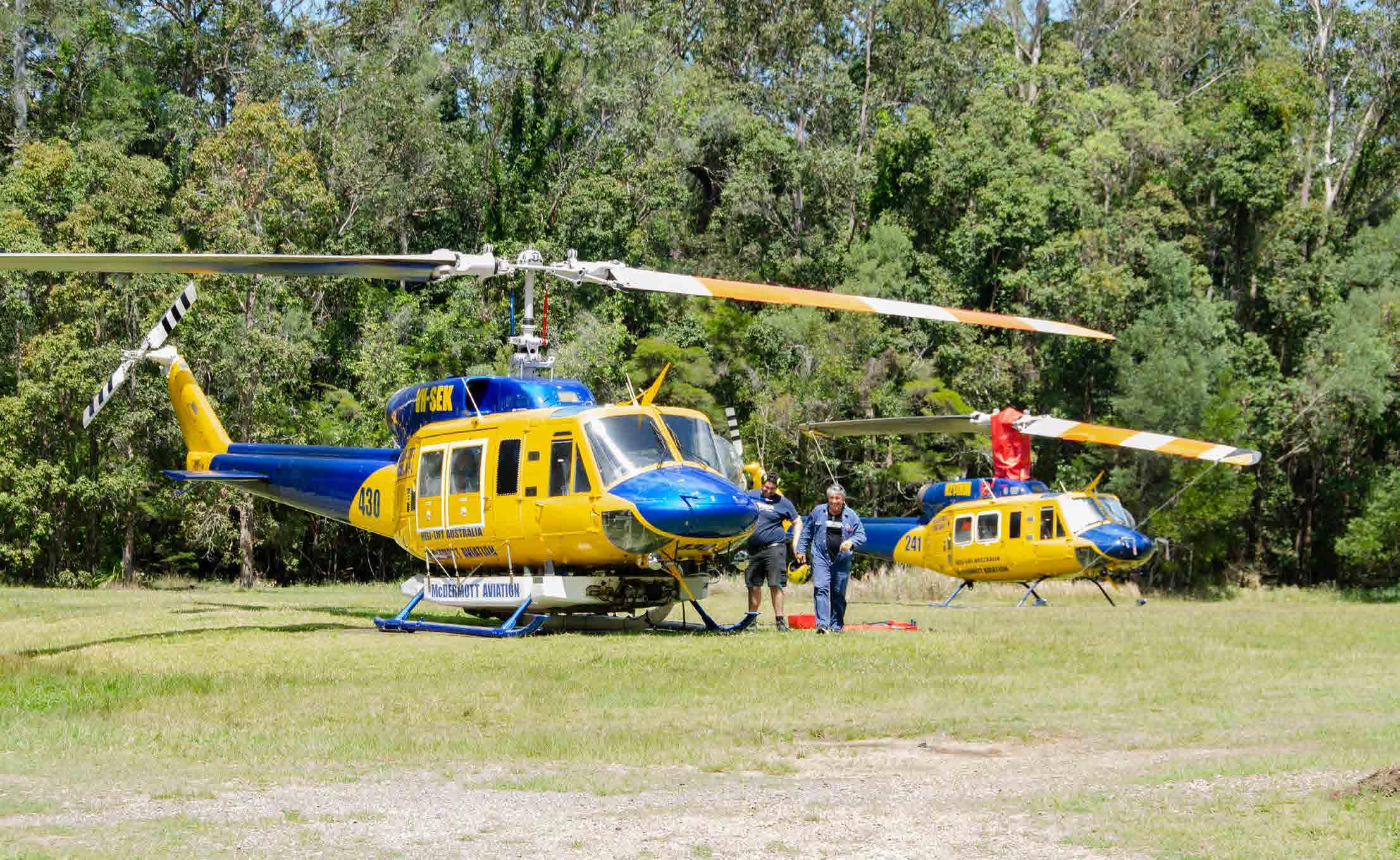 John McDermott (pictured above) still flies with each of the company’s pilots each year to ensure the continued safe operation of company pilots.
John McDermott (pictured above) still flies with each of the company’s pilots each year to ensure the continued safe operation of company pilots.
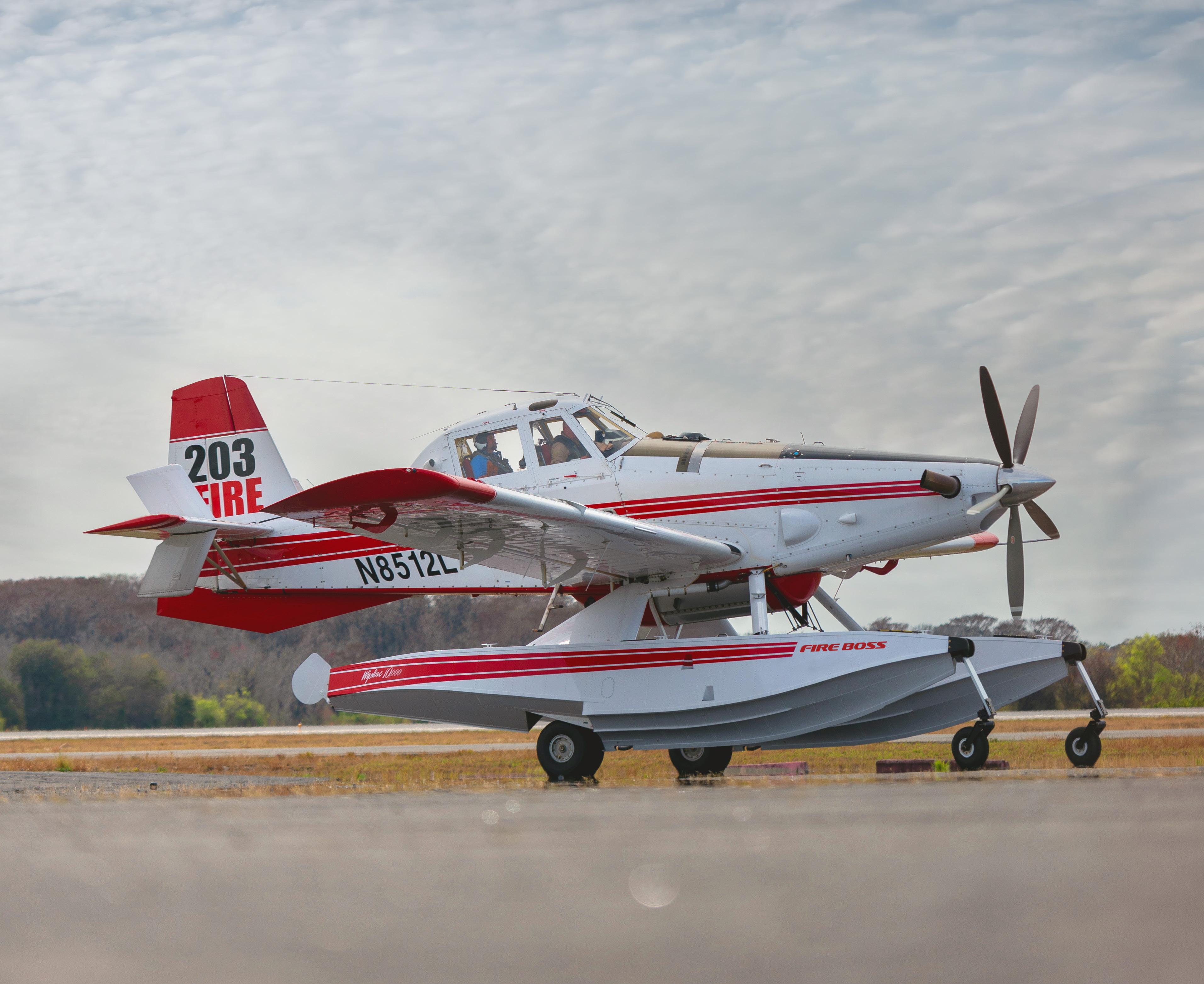

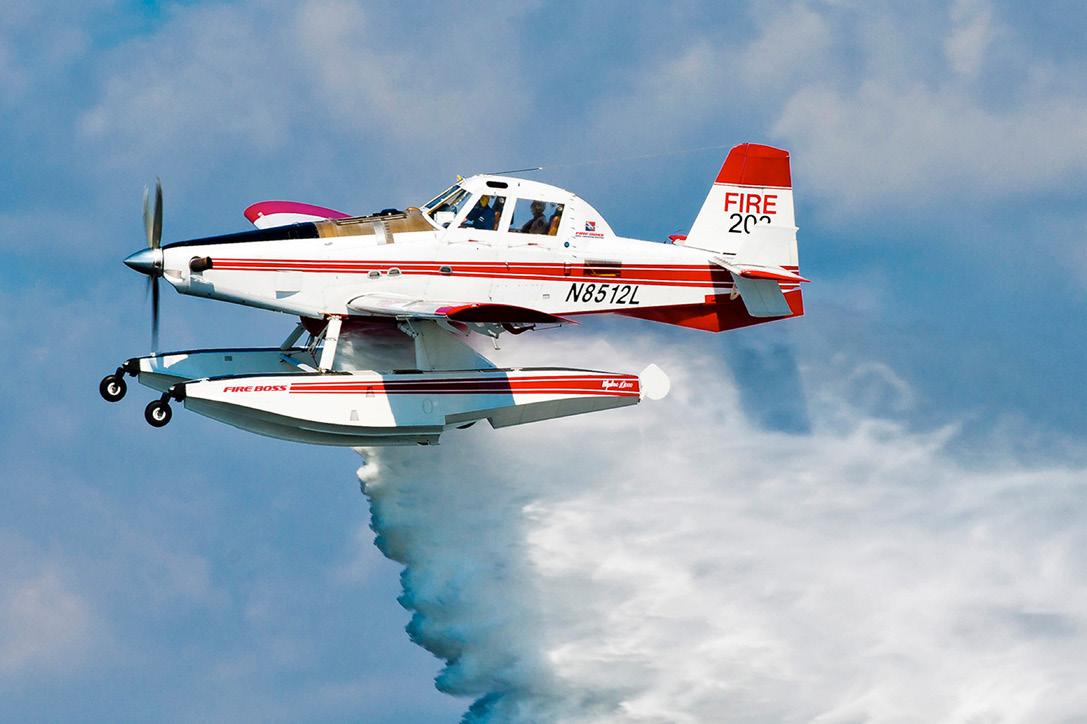
Maintenance can be a complex operation for a company that operates in multiple countries each year. Still, to accomplish this, McDermott employs fifty airframe mechanics, avionics technicians, painters, and licensed aviation mechanics to keep the wheels turning. Some of these staff are deployable with the aircraft when they are dispatched to overseas destinations throughout the year, while the majority are based at the company’s Cooroy headquarters.


“Maintenance staffing is our weakest link right now,” said John, who says the company still needs another twenty mechanics to get staffing levels where we would like to see them. This is an industry-wide problem. At McDermott, we are doing our bit with training new apprentices and even starting a training academy.”
“The problem we have is finding mechanics that are passionate about the job and about what we do and that don’t just treat it like a job. Being at a firebase can be hard and boring at times, but we need people that are committed to what we do,” said John. ➤
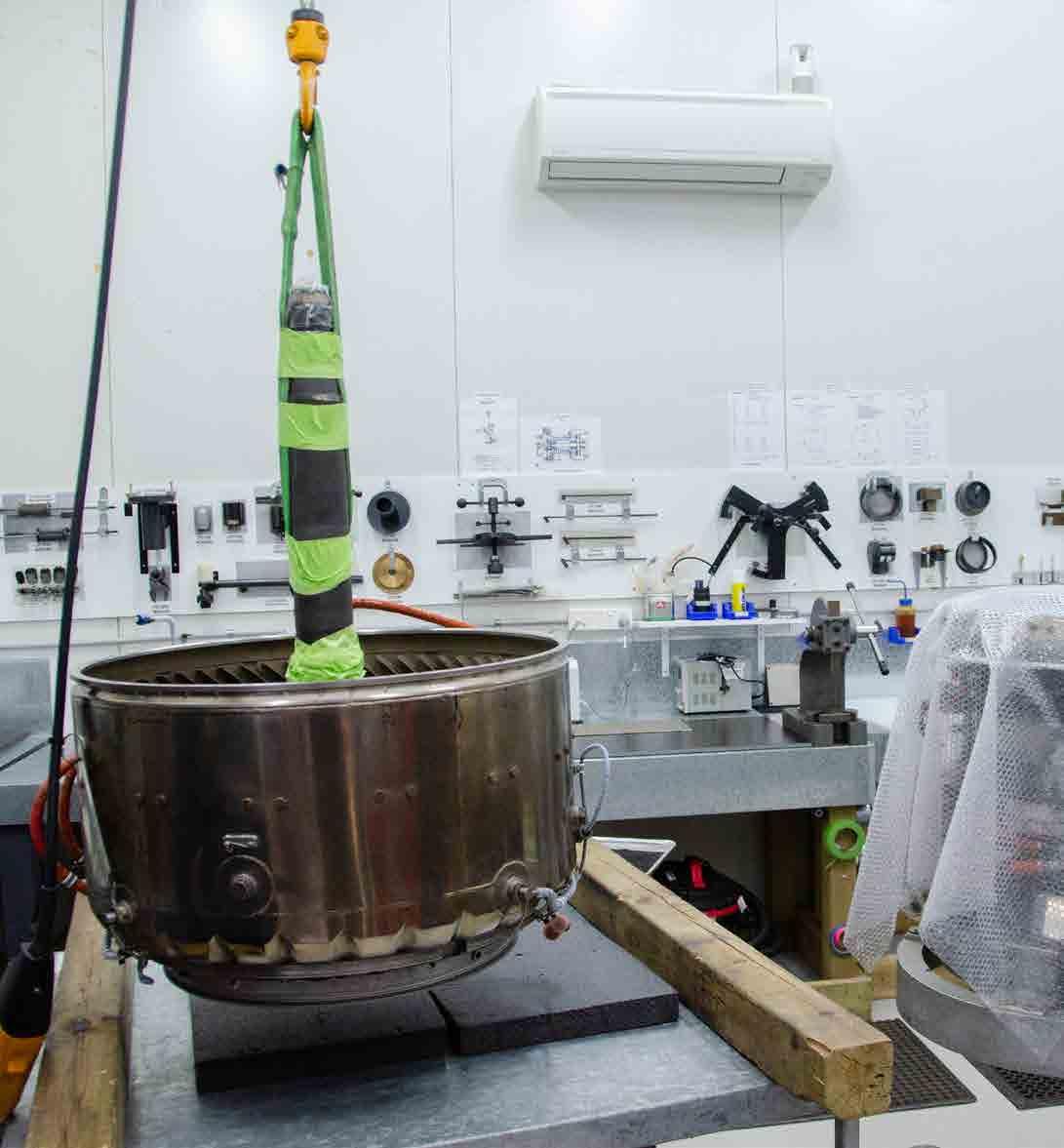
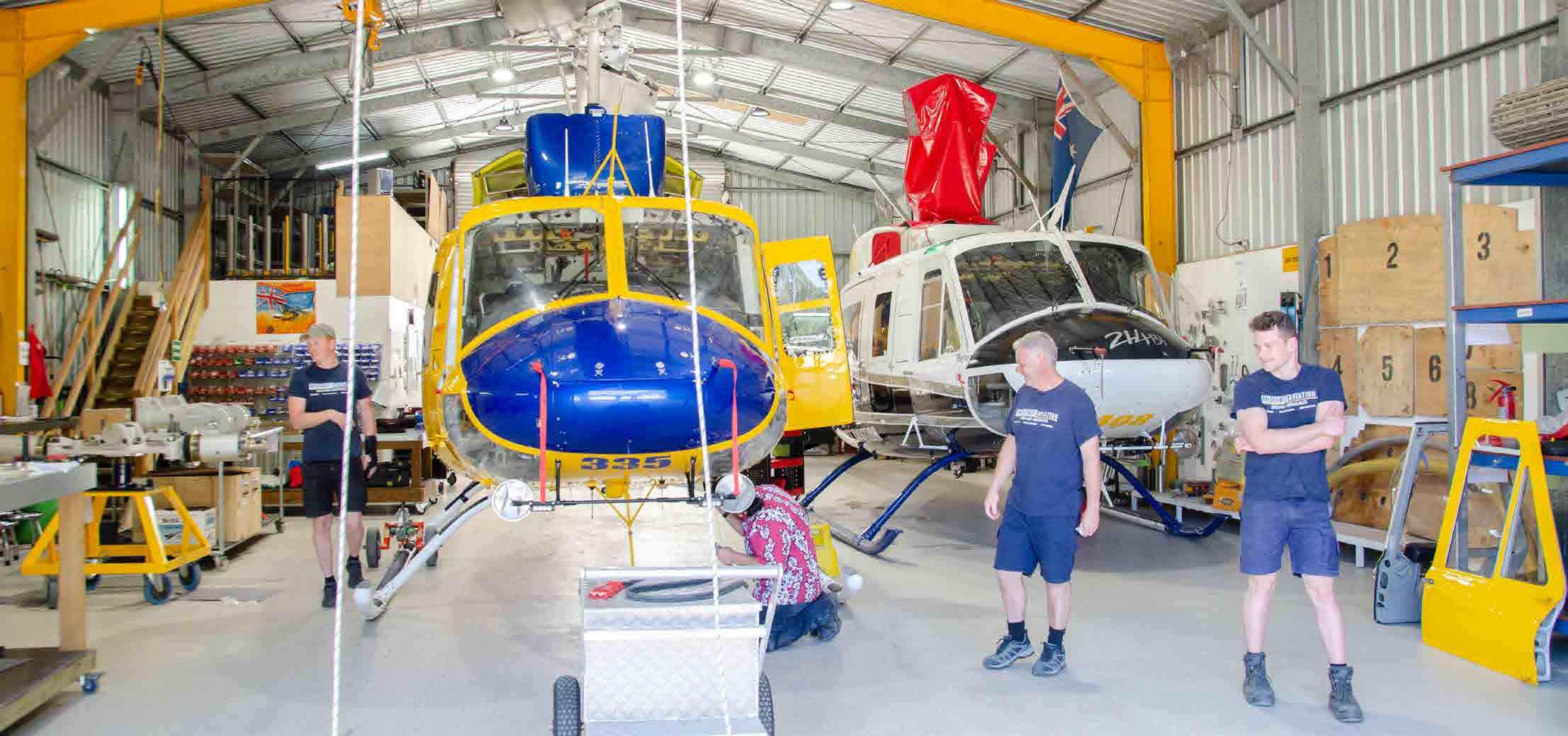
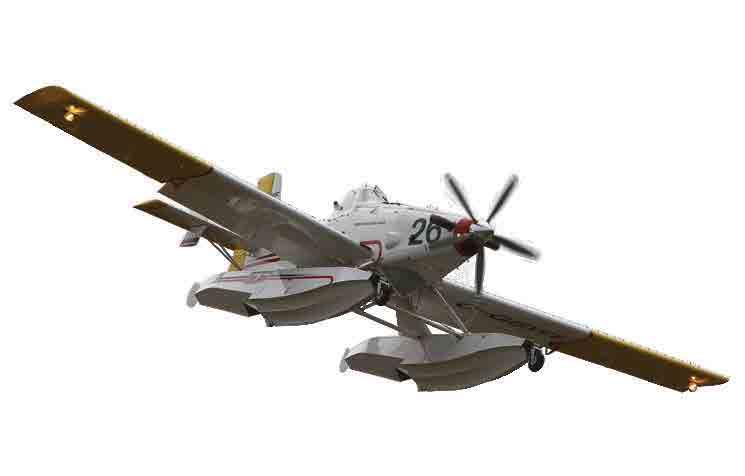

Another issue the company faces is difficulties in getting mechanics who have completed a four-year apprenticeship licensed or licensing overseas qualified applicants as Australia’s CASA regulatory board continues to make the task of becoming licensed more and more complex and expensive every year, leading to people giving up the industry for other endeavors due to the difficulty and driving new talent away from the field.
To offset some of the issues of lack of mechanics in Australia and to offset the cost of moving assets around the world, one of the things that McDermott Aviation has done to mitigate some of those costs is to open a maintenance base in Andalusia, Alabama recently. The maintenance shop in Alabama will employ American maintainers to house and maintain the McDermott fleet of 214STs. The U.S. market is easier to find mechanics qualified to work on the 214ST, according to John, who hopes the U.S. location will solve
several issues and reduce the cost of moving aircraft to overseas locations in the future.
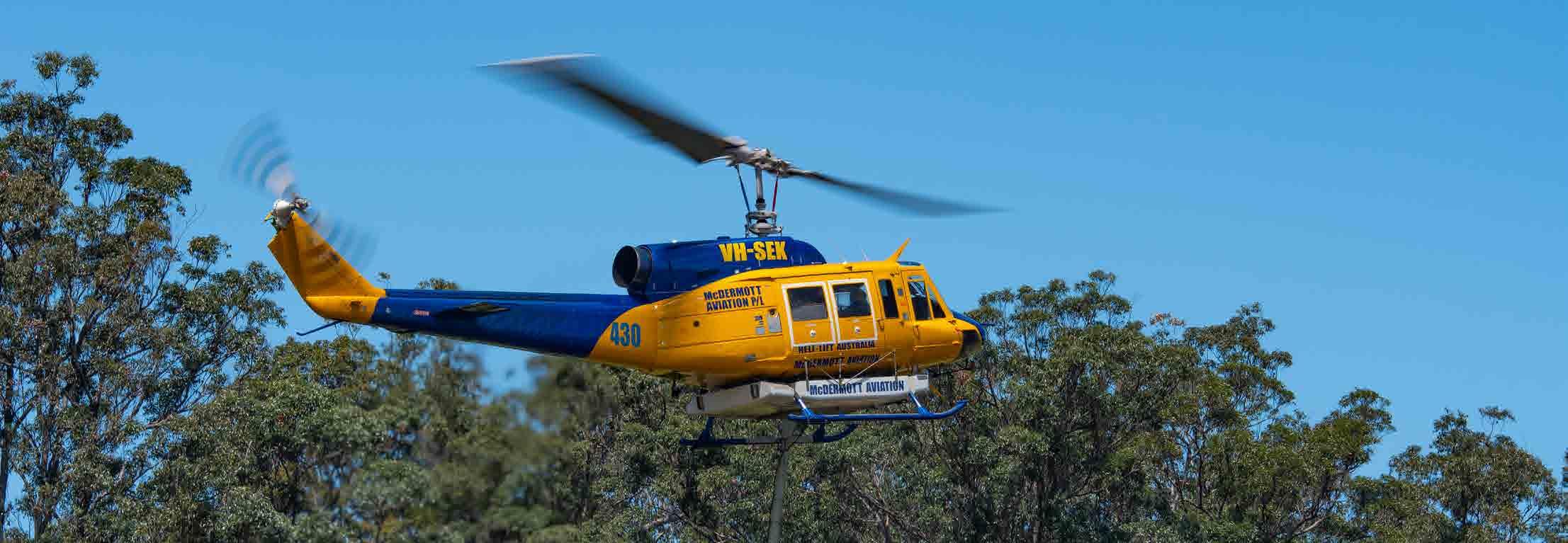
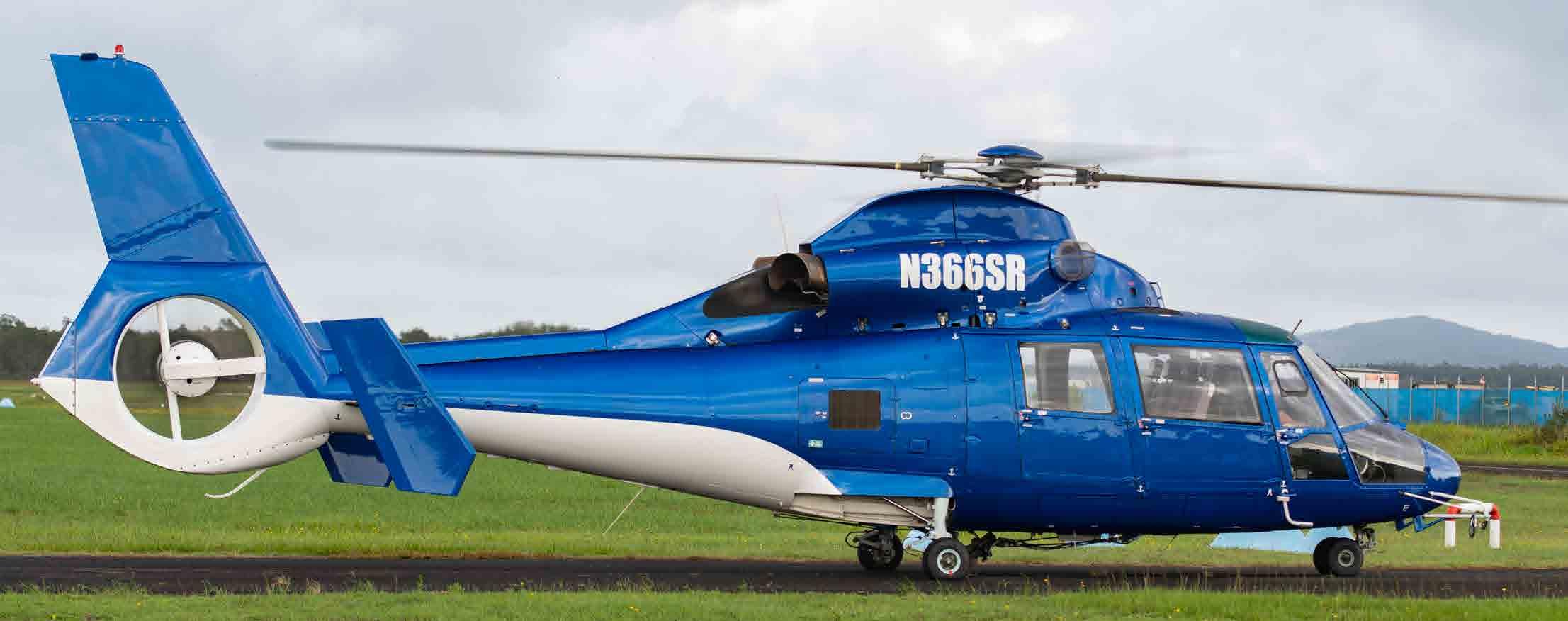
The location at the South Alabama Regional Airport is already in operation and still looking for more maintenance staff and will eventually house the company’s 214ST fleet in the near future.
For a company like McDermott Aviation, headed by John McDermott, who is self admittedly not someone who takes well to retired life, there is always something else on the horizon. John states that he still enjoys the challenges of groundbreaking technology and doing things that have never been done before in the industry, like their work with the ST fire tank and now saltwater scooping operations in addition to the new MRO facility in Alabama that will keep him and the crew at McDermott very busy into the near future.

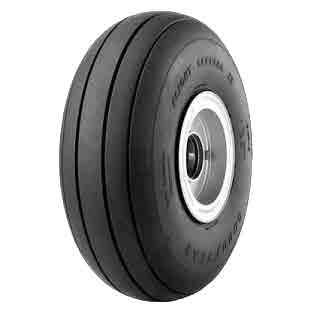


Modern firefighting via aerial attack was first attempted in the 1920s when containers of water were dropped from planes onto active wildfires. This method presented dangers for firefighters on the ground, and future efforts similar to this were quickly abandoned. However, the promise of aerial attack was clear; the fire safety industry needed to wait for technology to catch up with their imagination.
More sophisticated attempts were introduced in the 1940s. Small planes again used water as the extinguishing agent, but using water alone made accurate application from the air difficult. Long-term fire retardants were dropped from planes a few years later to help contain and extinguish wildfires. Various
active ingredients were tested, but phosphate-based PHOS-CHEK® became the first fire retardant approved by the US Forest Service (USFS) in 1963. Today phosphate-based fire retardants are used by the USFS and other fire management agencies worldwide to help contain wildfires. How did we get to this point, and why is phosphate the most common active ingredient for long-term fire retardants?
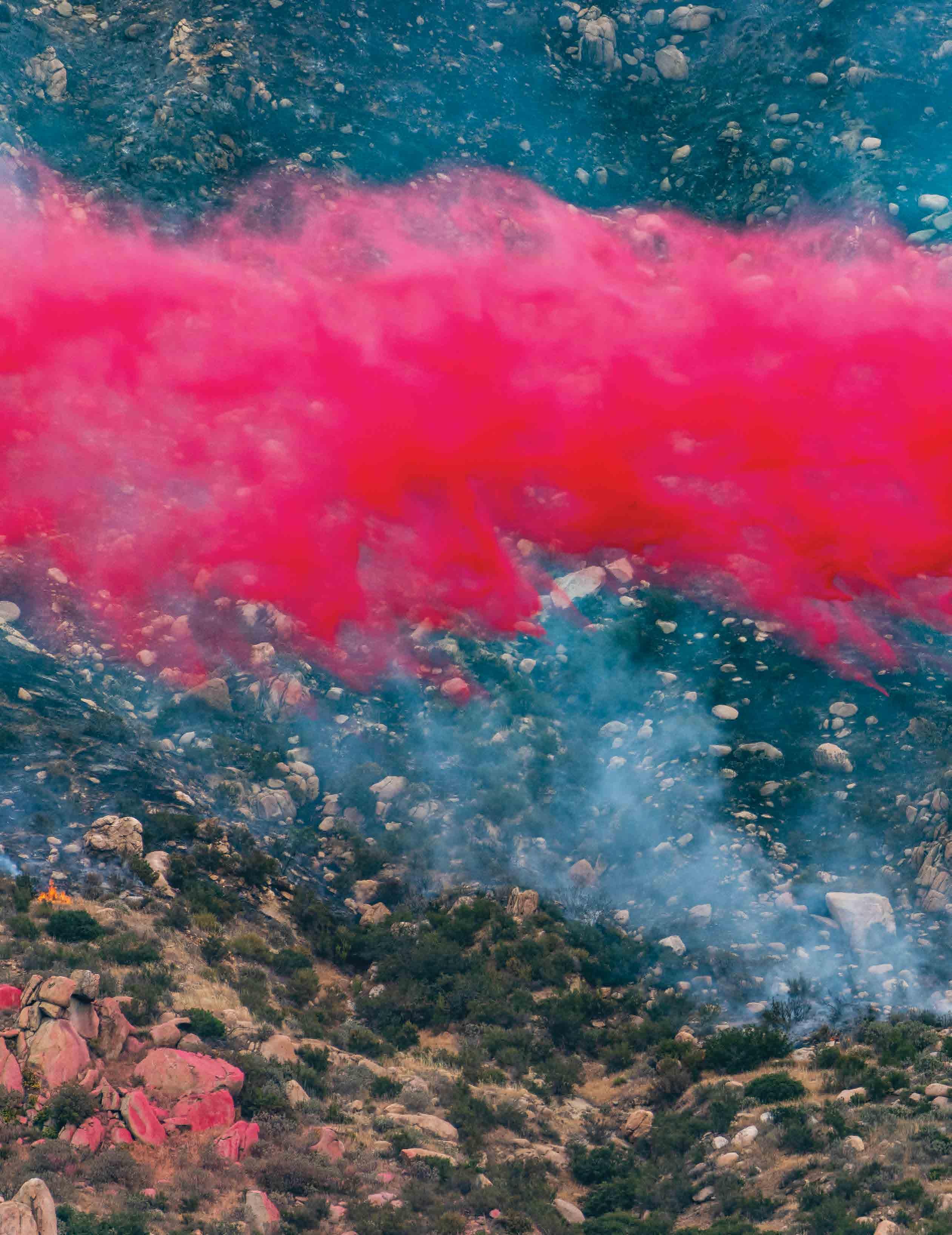
Research on the use of various chemicals as fire retardants dates back more than 80 years, with one of the earliest tests conducted at the University of Idaho in 1940. Multiple chemicals were put to the test to see which was the most effective at decreasing the combustibility of sawdust within a modified firetube apparatus. Evaluating a total of seven different
chemicals, the researchers found that the most effective chemical, based on the loss in weight of the sample during testing, was diammonium phosphate. Filling out the rest of the list in order of effectiveness were:
• Borax
• Monoammonium phosphate
• Zinc chloride
• Ammonium sulfate
• Ammonium chloride
• Magnesium chloride
Following the test, the researchers said, “The first four were effective in moderately small amounts (8-10 percent) and may be used to fire-proof sawdust. Larger amounts of ammonium sulfate and ammonium chloride are required. In contrast, magnesium chloride is not suitable as a fire retardant.” The results from this early test would be confirmed by more sophisticated testing that would be completed in the years ahead.
What is considered to be the first major test to determine the effectiveness of various fire-retardant chemistries took place in 1954 and was conducted by the USFS. The project was called Operation Firestop, conducted at Camp Pendleton Marine Corps Base Camp. The testing was performed to determine the effectiveness of new fire attack methods from science and technology that evolved during World War II. ➤
 Photos by Marty Wolin and Jeff Serpa
Photos by Marty Wolin and Jeff Serpa
One phase of Operation Firestop tested the effect of fireretardant chemicals on the ignition time of wood, the fire intensity of burning wood, and the retardant’s ability to suppress flaming wood. The study included several chemicals that had been in use over the previous years in firefighting products. The findings from Operation Firestop were clear, and they shaped the future of the retardant industry to this day. Ammonium phosphate was among the most effective chemicals in reducing fire intensity, while boric acid and magnesium chloride were among the worst. Following this groundbreaking study, phosphate-based retardants became the industry standard for decades. At the same time, boric acid, magnesium chloride, and polyvinyl acetate were discarded and not considered viable options as active ingredients for long-term retardants.
In the 1960s, firefighting communities experimented with clay and clay-like materials as a form of aerial fire retardant. These materials generally act as a watercarrying agent, which cools the fuels, raises ambient humidity, and forms a coating that inhibits the free

access of oxygen and heat to the fuel and the free egress of volatile products from the fuel. Sodium calcium borate proved to be an effective fire retardant. Still, it is undesirable due to its high cost, function as a soil sterilant, inefficient dry material per gallon used, and abrasiveness to equipment.
Sixteen years after Operation Firestop, Aylmer D. Blakely, a scientist from the University of Montana, conducted additional research on fire retardant chemicals. His findings were captured in his paper, A Laboratory Method for Evaluating Forest Fire Retardant Chemicals was released in 1970. Building on the results from Operation Firestop, Blakely included additional chemicals and identified more effective parameters.
Blakely used the “superiority factor method,” a composite of various factors combined to determine the effectiveness of different chemicals. These parameters included: the rate of weight loss, remaining residue after burning, and the amount of heat radiation emitted. ➤
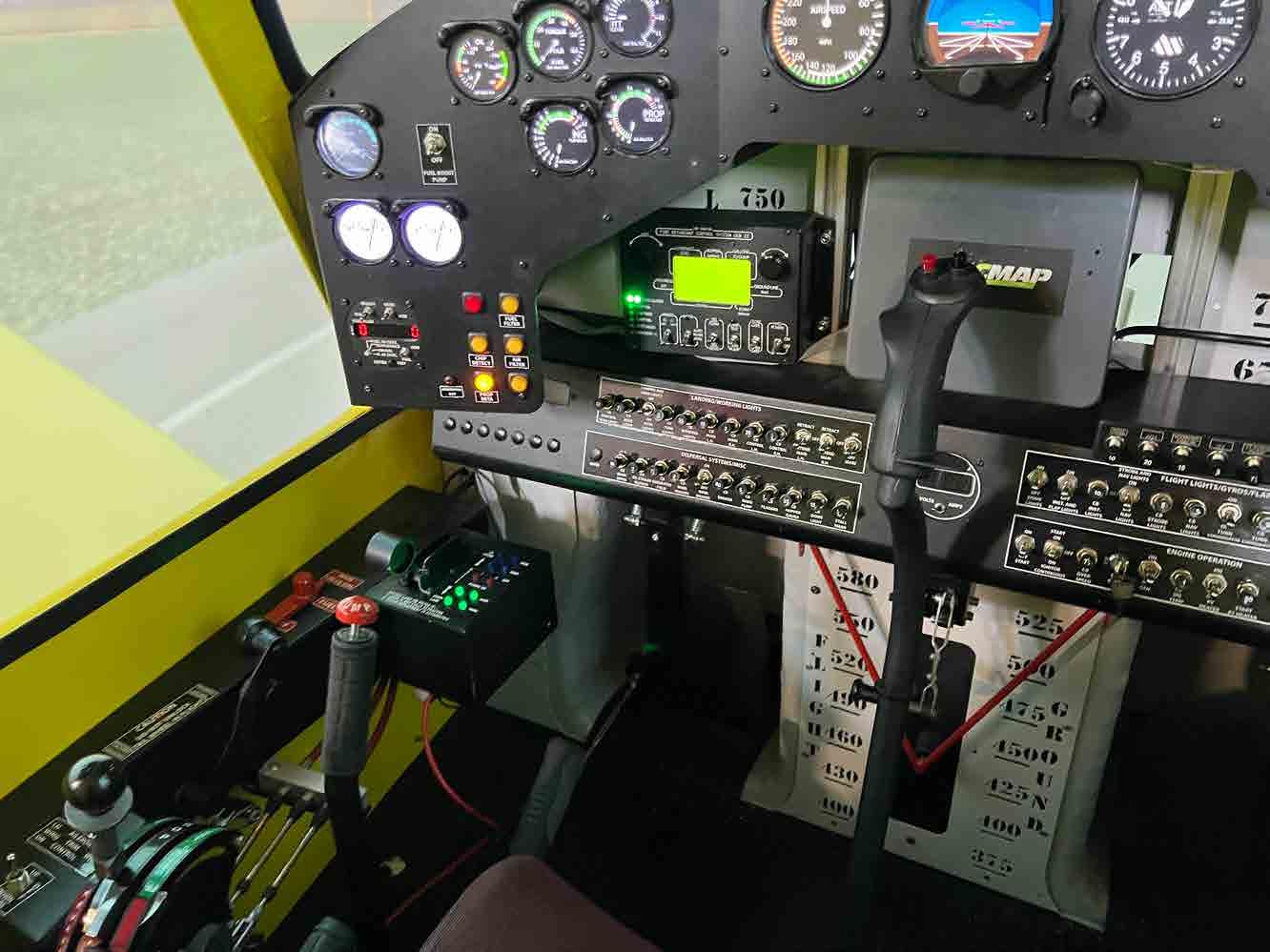
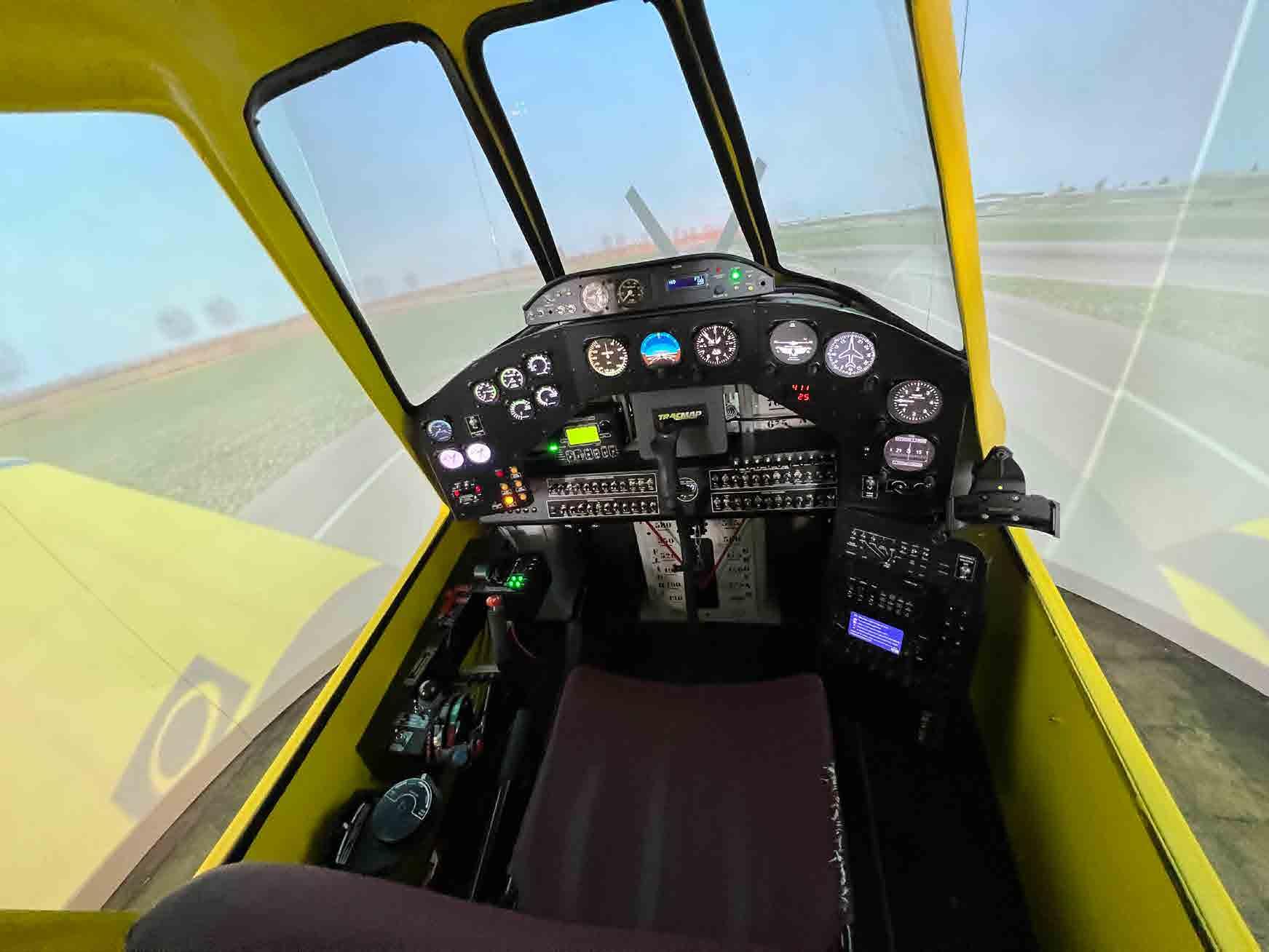

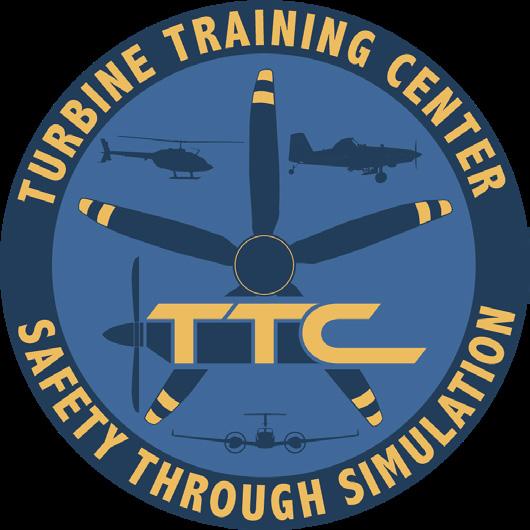

The overall ranking of chemicals showed that diammonium phosphate, mono ammonium phosphate, phosphoric acid, and potassium carbonate consistently ranked higher than any other chemicals in all three parameters. Of the four chlorides tested, only magnesium chloride showed moderate effectiveness for retarding combustion within the radiation parameter.

While the studies conducted from 1940 through 1970 identified ammonium-phosphate as the most effective chemical fire retardant available, phosphate-based fire retardants continued to evolve over the years as innovations were introduced.
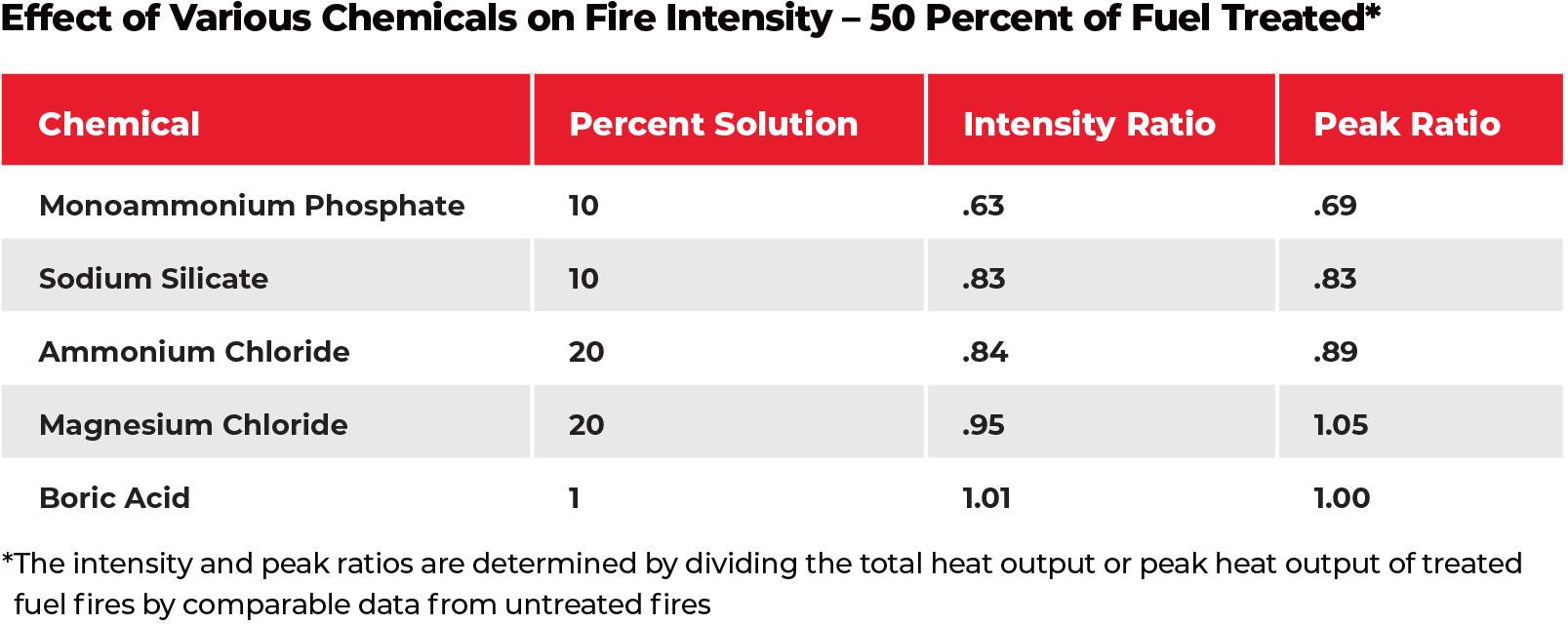
The first major innovation was in improving visibility for pilots. When fire retardant solutions are applied by dropping from aircraft, successive “drops” are often made by the aircraft to form a fire line. Under these circumstances, it is essential for the aircraft’s pilot to visually determine where the preceding loads were dropped. Then, the pilot can drop the load from the aircraft to form a continuation of this line. Since the fire retardant components may be colorless or may be of colors that do not contrast well with the ground or vegetation, it has been common practice to mix coloring agents with the fire retardant composition. This color provides contrast with the hue of the ground vegetation, thereby enhancing the ability of the pilot to determine where the last loads of fire retardants were dropped in constructing a fire line. ➤
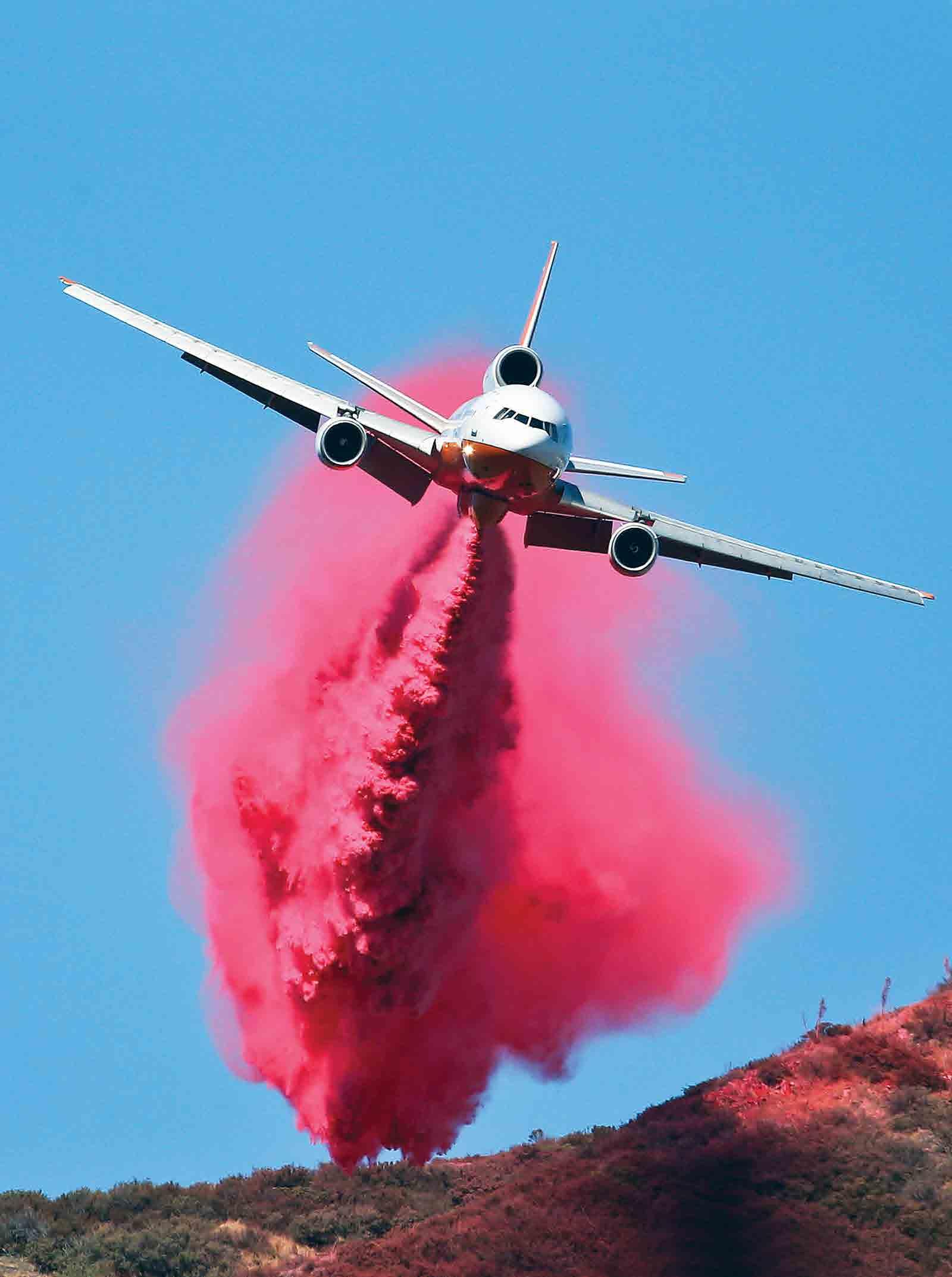

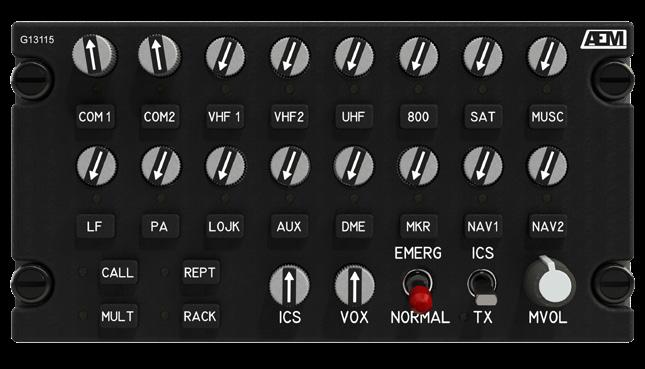

Iron oxide was one of the early coloring agents, first used in 1971 with the introduction of PHOS-CHEK 259. This fire retardant increased pilots' visibility and reduced previous technologies' corrosive properties. It is the only retardant approved for use on fixed tank helicopters containing magnesium parts highly sensitive to corrosion. The iron oxide used in this early retardant version was very colorfast. The ground and structures to which the fire retardant compositions were applied remained permanently or semi-permanently stained. Consequently, many government firefighting agencies have required that aerially applied fire retardant compositions have so-called “fugitive” coloring agents. These fugitive solutions will fade over a short time (e.g., 30 days) to a color that does not contradict the ground and vegetation. The first fugitive-colored fire retardant was introduced in 1975, providing fire management agencies the ability to effectively fight fires in aesthetically sensitive areas – such

as national parks and wildland-urban interface areas – where iron oxide-colored retardants were less desirable or unacceptable.
In 1985, retardants were first introduced based on a synergistic blend of ammonium sulfate and ammonium phosphates. The new blend provided fire retardant performance similar to ammonium phosphate retardants but at a lower cost. In 1995, this phosphate/sulfate retardant blend was later eliminated in favor of a full phosphate formulation that provided more favorable environmental effects.
Firefighters must be equipped with the best tools available. Fire management agencies have used phosphate-based retardants to battle wildfires successfully for years. In contrast, independent testing has proven more effective than any other solution, including magnesium chloride. That is why we believe phosphate is used more than any other chemical ingredient for effective long-term fire retardants.
A Coulson C-130 drops a sweeping line of PHOS-CHEK during firefighting operations.


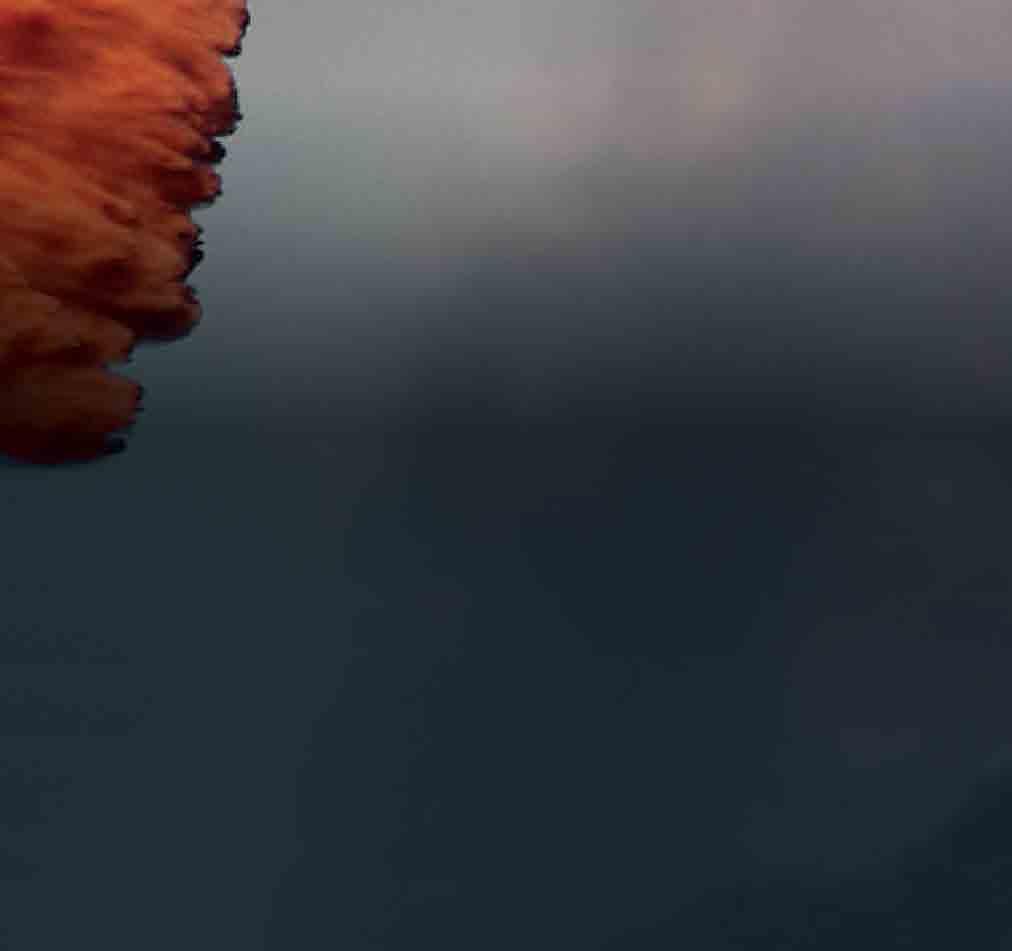


The C-27J Fire Fighter with roll-on/roll-off second generation Modular Airborne Fire Fighting System (MAFFS II) by UAC, the world leader of advanced aerial application systems, represents the market leading edge. The Fire Fighter version enhances the multi-mission capabilities of the C-27J, with significantly lower acquisition and operating cost than a dedicated platform. The flexible aircraft allows rapid reconfiguration for transport, humanitarian support, civil protection and SAR roles.

 by Ryan Mason
by Ryan Mason
As Aero-Flite enters its 60th year in aerial firefighting operations, the company has its eye on expansion, increasing an already sizeable airtanker fleet, one of the largest in the US.
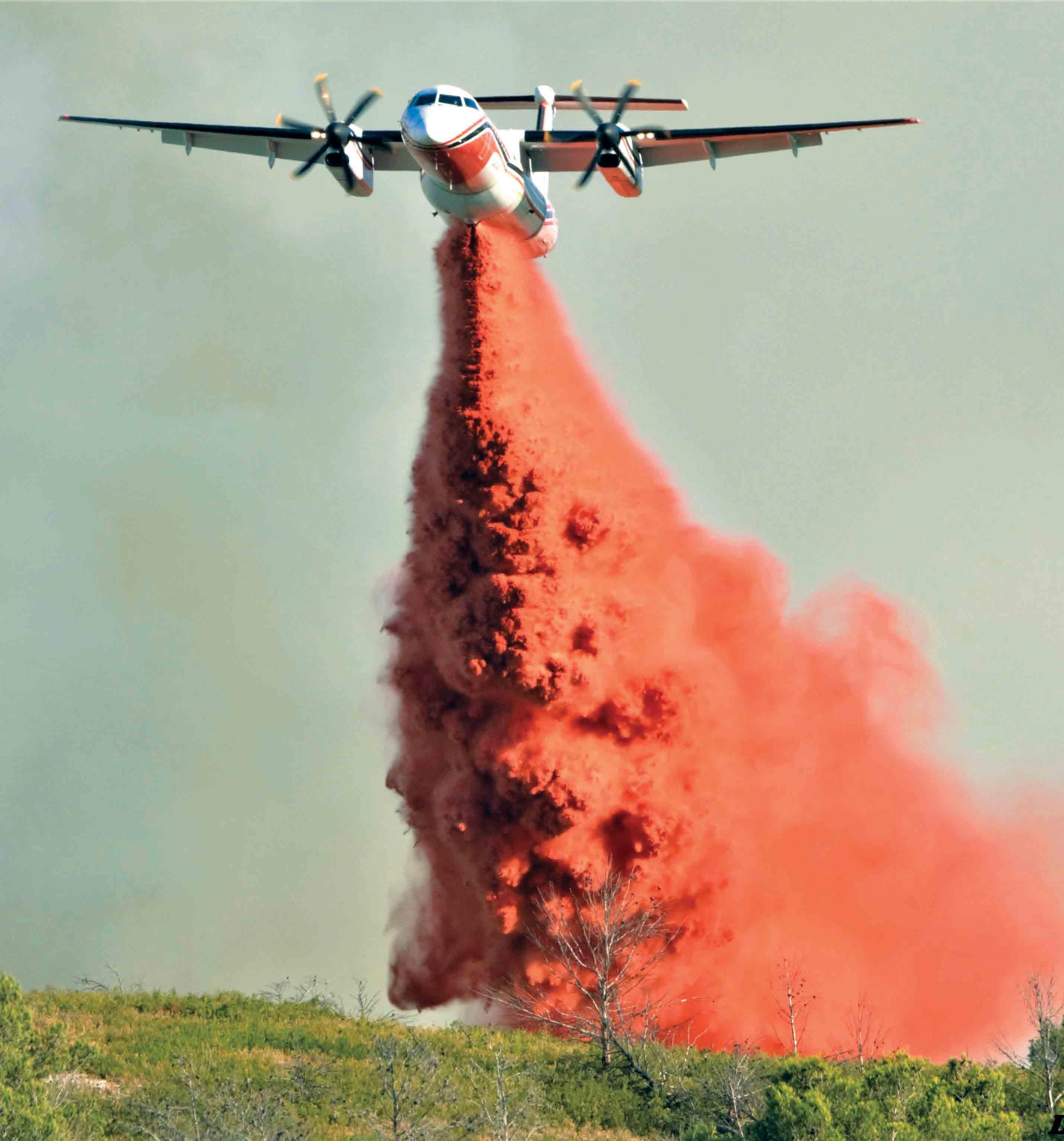
Operating seven large RJ85 airtankers, four of the newest model CL415s, and two Dash 8-400AT in 2022, the company has plans to increase its fleet of Dash 8-400
airtankers in response to the increased need throughout the country for additional airtanker support. With fire seasons becoming fire years and the damage left by extreme fires escalating, Aero-Flite looks to fill the need with an airtanker that can respond to a multitude of incidents, operating from bases that are not accessible by large Type 1 or VLAT airtankers, reaching more communities and resources in threat. ➤
Last year the Dash 8-400AT was introduced to service throughout the United States, but the tanker has been in service for 17 years, first taking flight in France as part of the Sécurité Civile fleet, later replacing their S-2 Firecat fleet. France deploys the Dash 8-400MRE, a multi-role variant of the air tanker-only version, responding to emergencies beyond wildfire, including passenger, cargo, and medevac transport. The platform was so successful, and long-term support from OEM De Havilland so strong, that Conair, the manufacturer of the Dash 8-400 airtanker, decided to use it as the replacement to their retiring fleet of Convair CV580 and Electra airtankers, purchasing 11 Dash 8-400 airliners in 2021 for conversion.
In late 2020 the first Dash 8-400AT deployed to Australia and is now serving a 4-year contract shared between two states, Victoria and Queensland. In 2021 the first Dash operated in Alaska and was shared later in the summer with Washington state through an interagency shared resources agreement based out of the new Olympia tanker base. In 2022 two Dash 8-400AT airtankers replaced retiring Conair CV580 in British Columbia and Alaska, servicing vast swaths of land with diverse geography with jet-like speed, operating from smaller tanker bases with shorter runways.
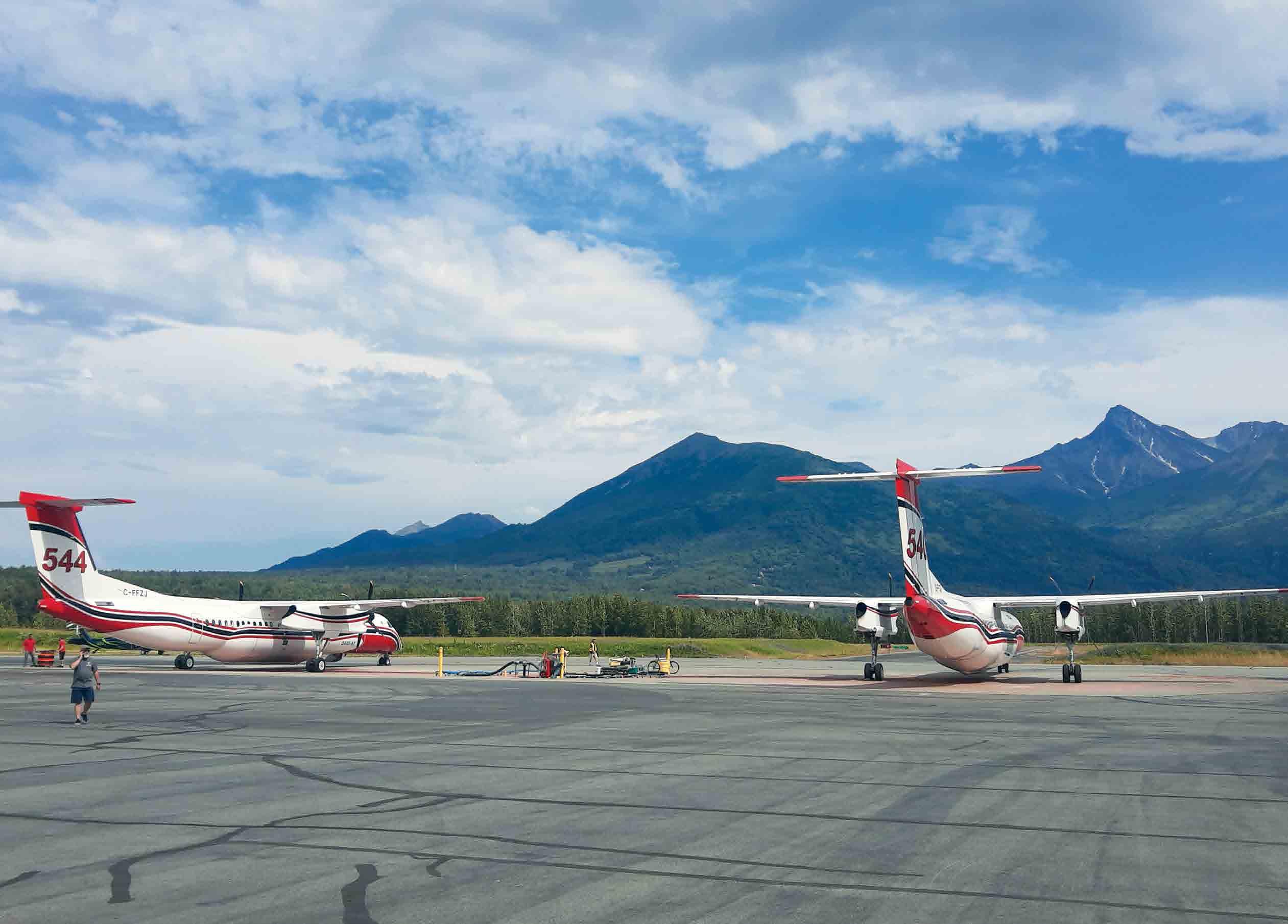
Its efficient and effective performance proved an excellent fit for the regions, and the two Dash 8-400AT airtankers were placed under a long-term 7-year contract with Alaska in 2022. British Columbia will also welcome two new Dash tankers to its fleet in 2023, replacing the remainder of the legacy fleet. Come this year's fire season, there will be more than 16 Dash 8-400 airtankers operating worldwide, with new airtankers still under conversion. And Aero-Flite plans to be one of the organizations picking up these new airtankers to offer to its agency customers across the US.
As the only Type 2 airtanker in the world, the aerial firefighter fills a much-needed gap in the US. Bigger is sometimes better when responding to wildfires. Agile, quick, versatile, and long-lasting, with drops that pack a punch, make the Dash a truly valuable air asset. Type 1 and VLAT airtankers like the DC10, C130, MD87, RJ85, or 737 can't operate out from small or high airtanker bases, as well as Type 2, limiting their effective operations compared to the Dash. The Dash can reach remote wildfires faster from smaller tanker bases, supporting ground crews working to contain fires threatening rural towns, agricultural land, Indigenous communities, critical infrastructure, and natural resources. ➤
Coastal Air Strike’s agile, forward-attack SEAT (single engine air tanker) and Fire Boss (amphibious SEAT) aircraft are your best chance to contain small wildfires, to prevent them from becoming big wildfires. Their ability to operate from virtually all airports, ranging from large tanker bases to remote airstrips – even reloading at portable retardant bases – along with the Fire Boss’s ability to scoop nearby water sources, proves them invaluable.

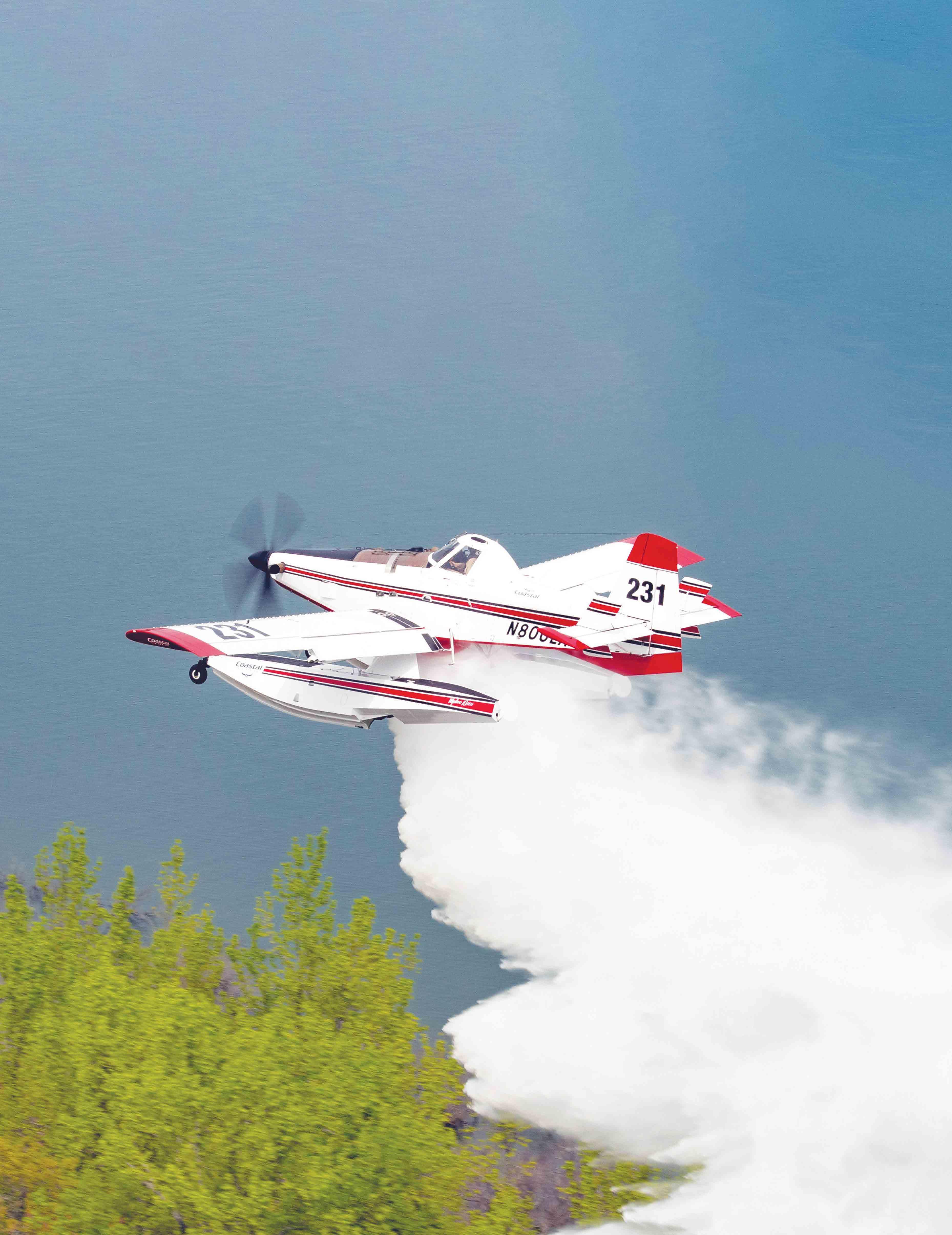

"What the Dash allows with current tanker bases is the ability to minimize downloading. It also opens up capabilities in airports like McCall, ID Reno-Stead, NV, La Grande, OR, and Ramona, CA that some of our current large airtanker fleets are limited in" shares Brock Hindman, Dash 8-400 Chief Pilot at Aero-Flite. "Being able to operate out of smaller airports, the Dash will allow more portable tanker base options across the US for our customers."
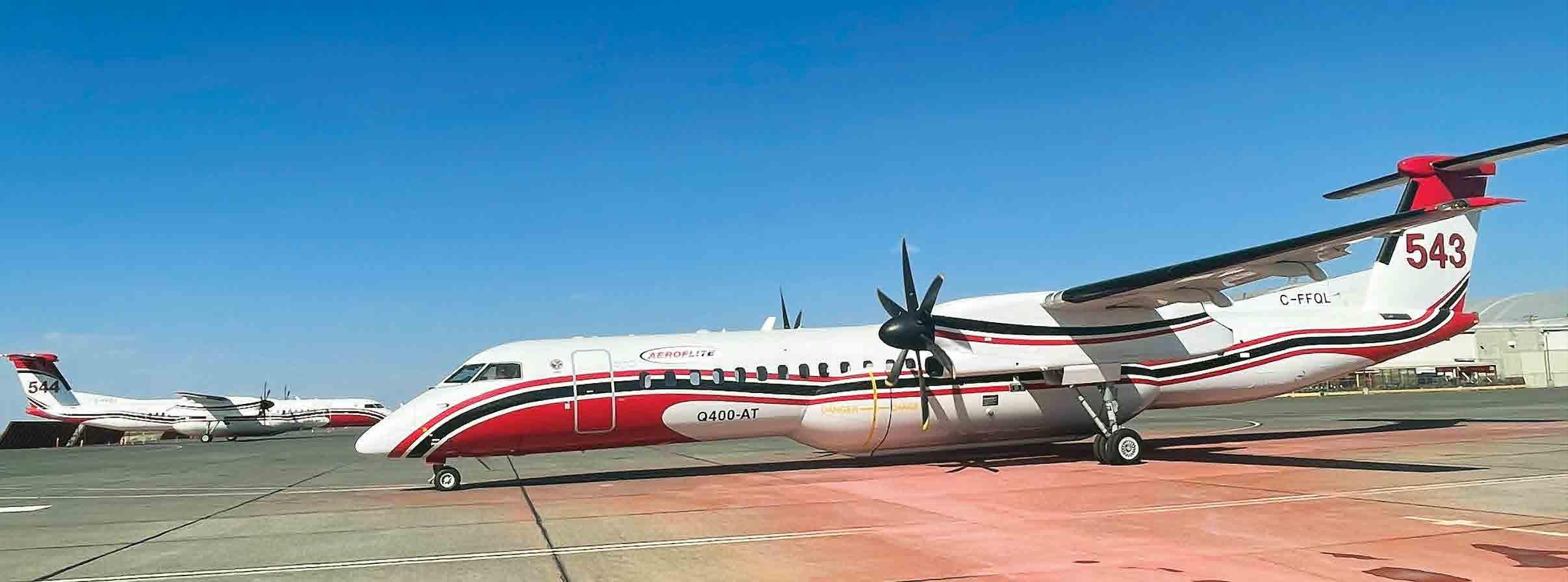

The Dash operates off 5,000' runways, much shorter airstrips than required by larger airtankers. This capability opens many airfields across the country to missions using more state and mobile tanker base facilities. "The Dash is a very powerful, straight-wing Turbo-Prop powered airframe. This gives our flight crews a tool with good takeoff performance, efficiency, and reliability while supporting firefighting operations," continues Brock. "The stability and maneuverability of the tanker make it an ideal aircraft for missions out of shorter runways."
And the Dash can operate at a higher elevation than its larger counterparts, positioning itself in a multitude of locations that currently weren't accessible to larger airtankers, giving it the ability to respond faster to wildfires in the area. McCall, Idaho, was one of these bases last summer. It was the first time in a few years that a large airtanker had landed at the base, situated 5,000' above sea level with a 6,100-foot runway. The higher elevation and shorter runway meant that most large airtankers couldn't operate out of McCall. The Dash 8-400AT took loads of retardant to the Double Creek fire nearby. "As a fire pilot operating in mountainous terrain, I have greater confidence in the Dash over the other large airtankers I have flown. The sheer power and efficiency of the PW150A engines is a wonderful thing. It takes off fast and gets to the fire as fast as our jets," shares Captain Chris Bingham. "The tanker also burns far less fuel than other large airtankers. In some instances, the tanker can drop more than double the payload for fuel burned than other larger airtankers. ➤
For over 50 years Conair has partnered with governments on wildfire missions around the globe, operating the largest, privately owned, fixed-wing fleet in the world.


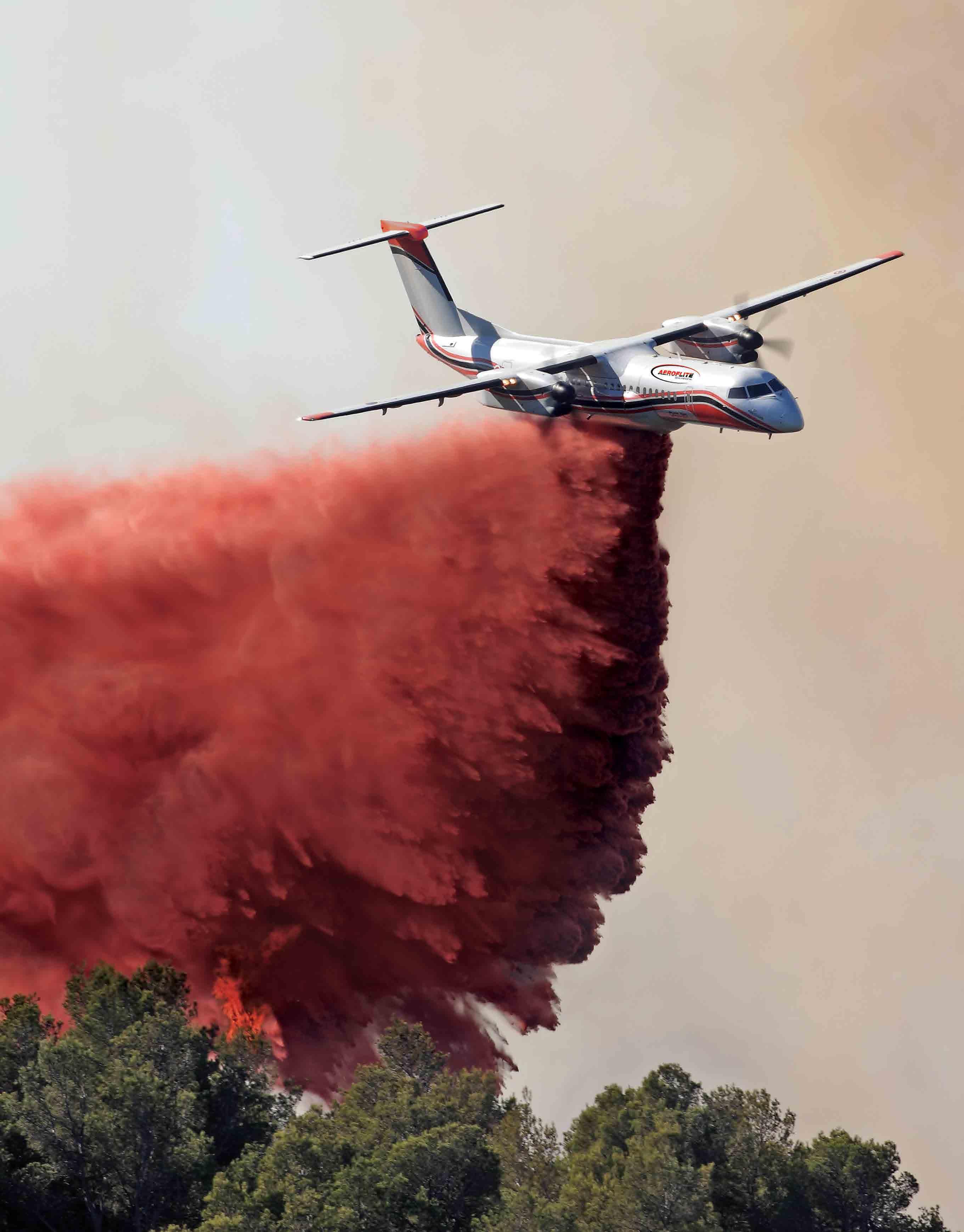
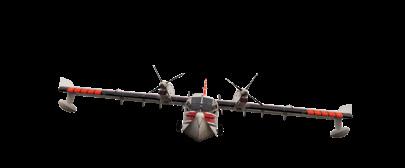
Fast, fuel efficient and tactically flexible. A modern airtanker with a 10,000 litre/2,642 gallon capacity to drop suppressant over diverse geography. Setting the standard for Next Generation aircraft with OEM support to keep the firefighter flying for decades.
 Photo: Alexandre Dubath conair.ca
CLICK TO WATCH THE DASH 8-400 AIRTANKER IN ACTION...
Photo: Alexandre Dubath conair.ca
CLICK TO WATCH THE DASH 8-400 AIRTANKER IN ACTION...
This means we can continue more reloads and return the fire before requiring a refueling stop. That's 2,642 gallons per drop – drop after drop after drop -as we refill from bases closer to the fire than ones nearer large urban centers."
This accessibility benefits other high-elevation states, including New Mexico, where positioning the Dash at a tanker base like Silver City would help reach nearby wildfires faster. "The Dash positioned at Silver City would minimize transit time to fires in the Gila National Forest. This capability will be helpful for future fires in the region," shares Brock.
In 2022, the two Dash 8-400 airtankers at Aero-Flite responded to fires in Washington, Alaska, Oregon, and Idaho, operating through a new Washington state 5-year contract. "Washington state's investment in contracting the Dash 8-400AT airtankers, along with two of our CL415s, ensures the state has resources available when needed. Plus, it offers the ability to share resources when not needed," says Chris Neimann, General Manager at AeroFlite. "The Dash 8-400AT can operate out of any state across the US." ➤
Looking into the future, it is evident climate is changing fire danger, impacting states that previously had little threat of wildfires. Aero-Flite regularly operates its fleet in California, Arizona, Montana, and the northwest states. Still, they are deploying to Texas, New Mexico, and Oklahoma more often, creeping east as fuels dry, droughts persistent, and the wind takes off. It is beneficial for states to look to Washington, California, Alaska, and even countries, including Australia
and Canada, as examples of how to contract aerial assets to secure response ability proactively. "There are many ways a large asset such as a Dash 8-400 airtanker could be contracted. There isn't a one-size-fits-all solution, especially since states are so different regarding geography, populations, seasons, aerial firefighting fleets, and budgets. There are possible solutions that can fit every agency's needs," shared Chris.
To prepare for its future growth, Aero-Flite is in the process of a hangar expansion, with plans to increase its hangar capacity to nearly 100,000 sq ft allowing the outfit to double its tanker fleet size. Although not confirmed, the likely location of the hangar will be Spokane, Washington, increasing employment in the region from 160 skilled team members to nearly 275 pilots, mechanics, and support staff. "These are high-paying jobs with great benefits and longterm career advancement for employees. The expansion will include training and internship programs that enable us to take someone with no experience and prepare them for the FAA airframe and powerplant exam, allowing them to become licensed aircraft mechanics," says Chris. "Plus, we have one of the industry's only part 142 flight training academies. We can "type certify" our pilots in companyowned FAA-certified flight simulators. We are well positioned to grow not only our fleet with new Dash airtankers but also our crews."
Some things in life are certain. Wildfires will only get worse. With that in mind, Aero-Flite plans to be ready to support all agencies in the US in their fight against wildfires, expanding the Dash's reach across the country.
 An Aero-Flite Dash 8-400AT dropping retardant during the Tonasket-Crumbacher Fire.
Photo by Tanya Palomares.
An Aero-Flite Dash 8-400AT dropping retardant during the Tonasket-Crumbacher Fire.
Photo by Tanya Palomares.


Fly confidently with dependable, mission-driven solutions tackling hazardous terrain and weather conditions. Connect flight management, displays, and enhanced vision capabilities to drive performance and mission success.

As an Air Operations Branch Director and Aviation Program Manager one of my primary focuses was to make sure I was managing risk for aviation missions. There are several ways to manage risk and different tools to help managers as they make decisions. The NWCG Standards for Aviation Risk Management, May 2021 https://www.nwcg.gov/sites/ default/files/publications/pms530.pdf is a great resource for managers as they identify and assess hazards. It also explains how to develop controls, make risk decisions, implement controls and supervise and evaluate operations.
There are three primary levels of risk management; strategic, deliberate and real-time.
If possible, it is always best to make risk management decisions when planning aviation operations when the pressure of specific missions does not affect our judgement. It is difficult to not get mission-oriented when fires are destroying property and lives are threatened. Risk management for on-going missions is considered ‘real-time’.
When incorporating the use of BLAZETAMER380™ as a tool, the risk management level is either ‘strategic’ for program managers as they adopt policy, procedures or guidelines or ‘deliberate’ when in the planning phase of a mission.
In a survey of seasoned pilots and Air Attack Group Supervisors who used BLAZETAMER380™ on over 300 wildfires throughout the United States over the past few years it was their overwhelming opinion that water enhanced with BLAZETAMER380™ was more effective than nonenhanced water.
Statement from an ATGS “I can’t quantify if it is 2, 3, or 4 times more effective but there is a noticeable difference in effectiveness compared to straight water and becomes more noticeable the longer the turnaround between loads.”
If BLAZETAMER380™ is twice as effective than nonenhanced water, a simple takeaway is that flight time could be reduced in order to accomplish the mission. Flight time could be cut in half! This would significantly reduce the amount of time pilots are exposed to low-level flights in smoky conditions, in extreme thermals and often-times congested airspace above a fire.
We experienced several accidents in 2022 and several firefighters and pilots have lost their lives in the line of duty. What deliberate actions can be taken to reduce hazards and exposure?
Quicker control of fires reduces fire size. Fewer acres burned reduces exposure of ground firefighters to hazards, such as snags and other common hazards found in the wildland urban interface.
The cost/benefit ratio must be applied when considering risk management. The cost for incorporating BLAZETAMER380™ and any infrastructure, such as dip tanks, is offset through the reduction of flight time that is typically from $4,000-$8,000 per hour for Type I Helicopters. If aircraft are configured with on-board injection equipment costs and logistical complexities can be reduced, resulting in further savings. The ability to save money while reducing exposure by simply changing from use of nonenhanced water to enhanced water is a unique opportunity.
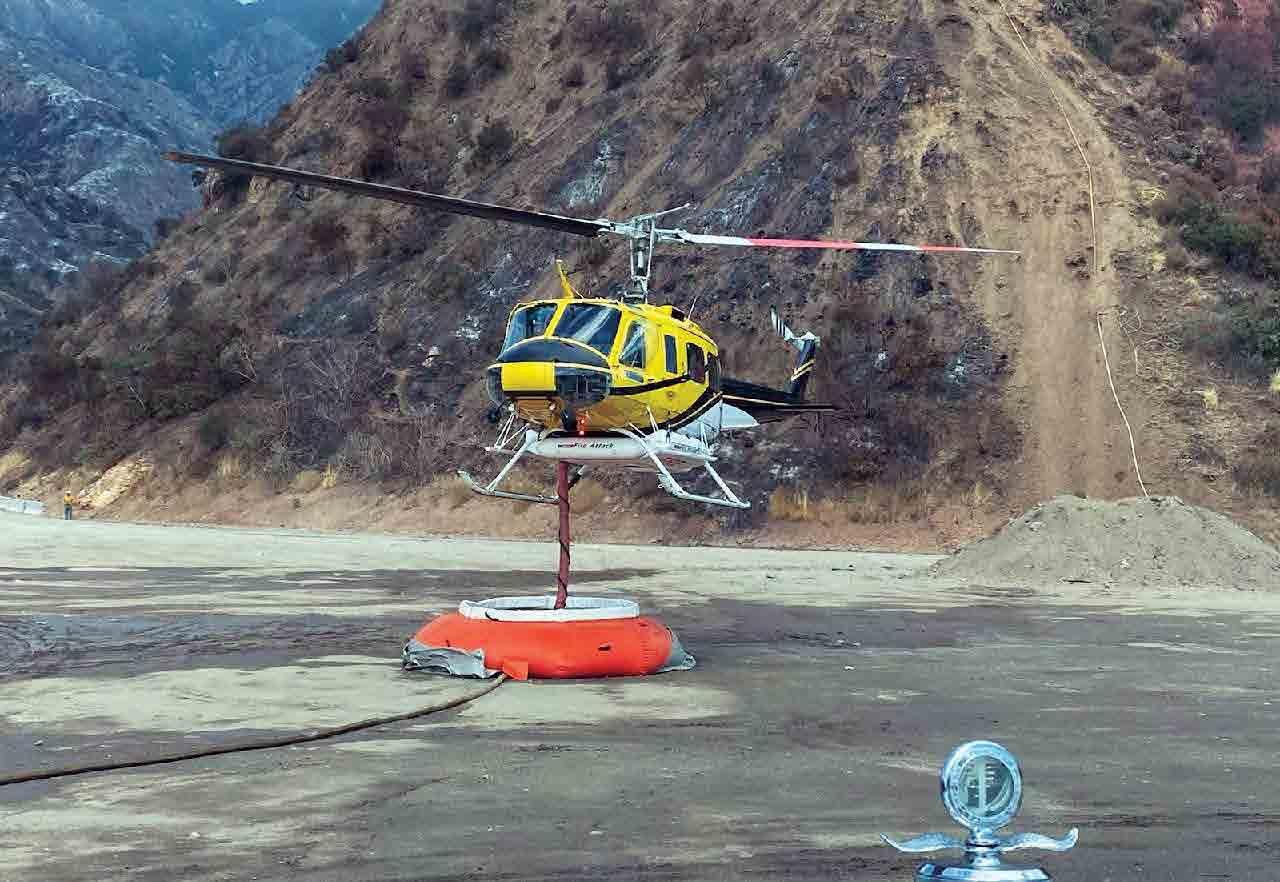
Deliberate and Strategic Risk management does not just happen. Fire / Aviation Managers must be proactive. Plan ahead to locate dip tanks, aircraft that are configured with on-board systems and begin promoting and training firefighters. Inform your team of the value of risk management and work with them to put your plan into action.
BLAZETAMER380™ is approved for use in all types of aircraft; LATs, SEATs, Water-Scooping Fixed Wing, Helicopters with buckets and helicopters configured with tank systems. BLAZETAMER380™ can be procured through current contracts with State Agencies or within the Resource Order System.

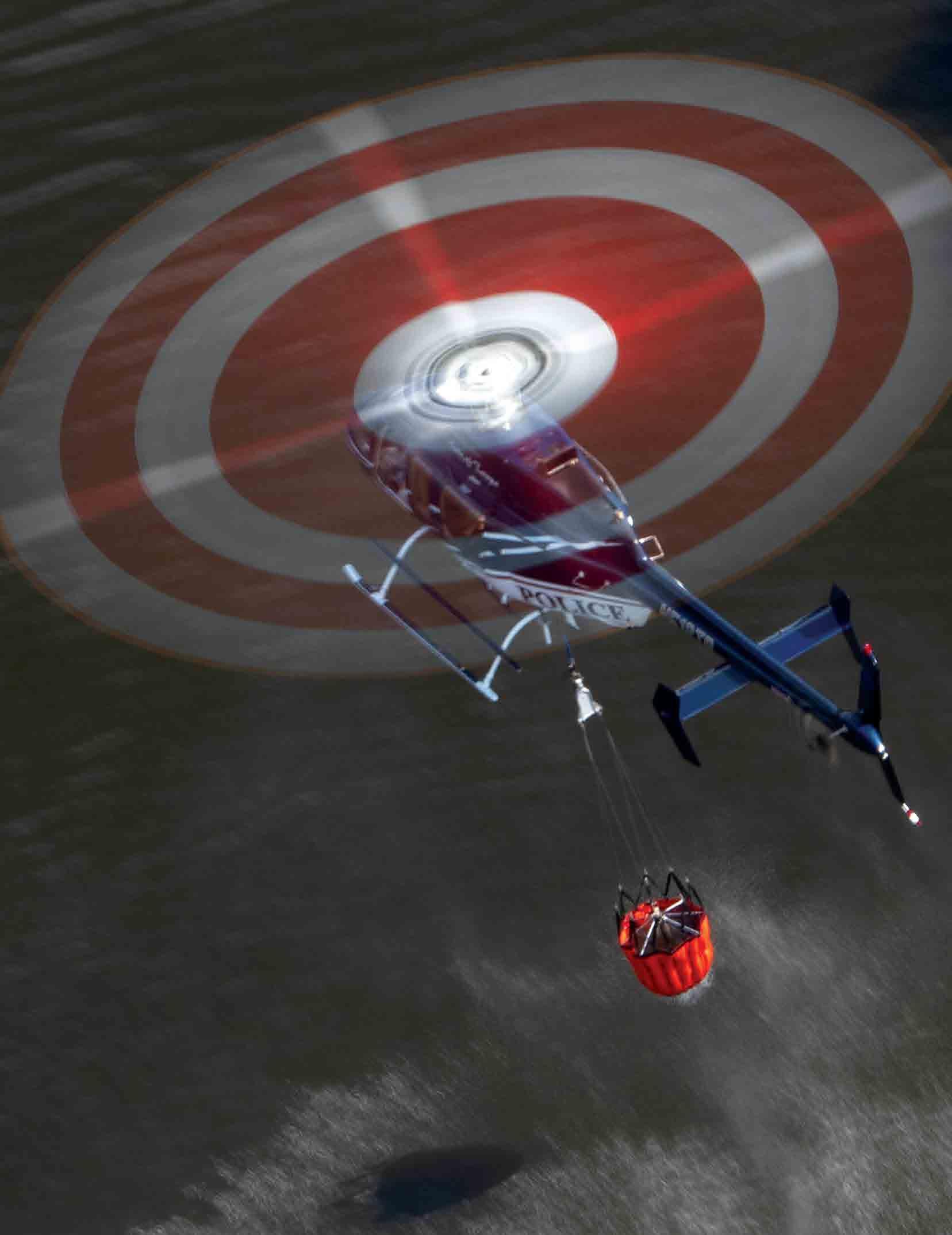 Story and Photos by Ryan Mason
Story and Photos by Ryan Mason
For the last 40 years, the Bambi Bucket has been a popular aerial firefighting tool used to drop water or fire retardant on wildfires from helicopters, developed by SEI Industries, based in British Columbia, Canada, in the early 1980s.

The idea for the Bambi Bucket came from SEI Industries founder Don Arney, who at the time was working for a company that was testing the strength of underwater salvage balloons used for boat an ship salvage. While looking at a canvas bag holding several thousand pounds of water, Arney, himself a pilot began thinking about ways to make that type of technology functional for helicopters to pick up and drop water with a bucket that he began developing in a home not far from where SEI Industries is now based in Canada. The Bambi Bucket began commercial production in 1982.
The first Bambi Bucket prototype was simple: a rubber udder attached to a canvas bucket, which worked as a
valve to release the water. It was lightweight and easy to install on a helicopter and could hold up to 200 gallons of water.
As word of the Bambi Bucket spread, demand for the product grew. SEI Industries began receiving orders from fire departments and governments around the world. In the decades that followed, the company continued to innovate and improve the design of the Bambi Bucket. Today, several different sizes and models are available, with capacities ranging from 72 gallons (270 liters) to over 2,600 gallons (9840 liters.)
One of the key features of the Bambi Bucket is its ability to be filled quickly and easily. The bucket can be filled from various sources, including lakes, rivers, and swimming pools. This allows firefighters to quickly refill the bucket and get back to fighting the fire. ➤
The idea for the Bambi Bucket came from SEI Industries founder Don Arney, who at the time was working for a company that was testing the strength of underwater salvage balloons used for boat and ship salvage.
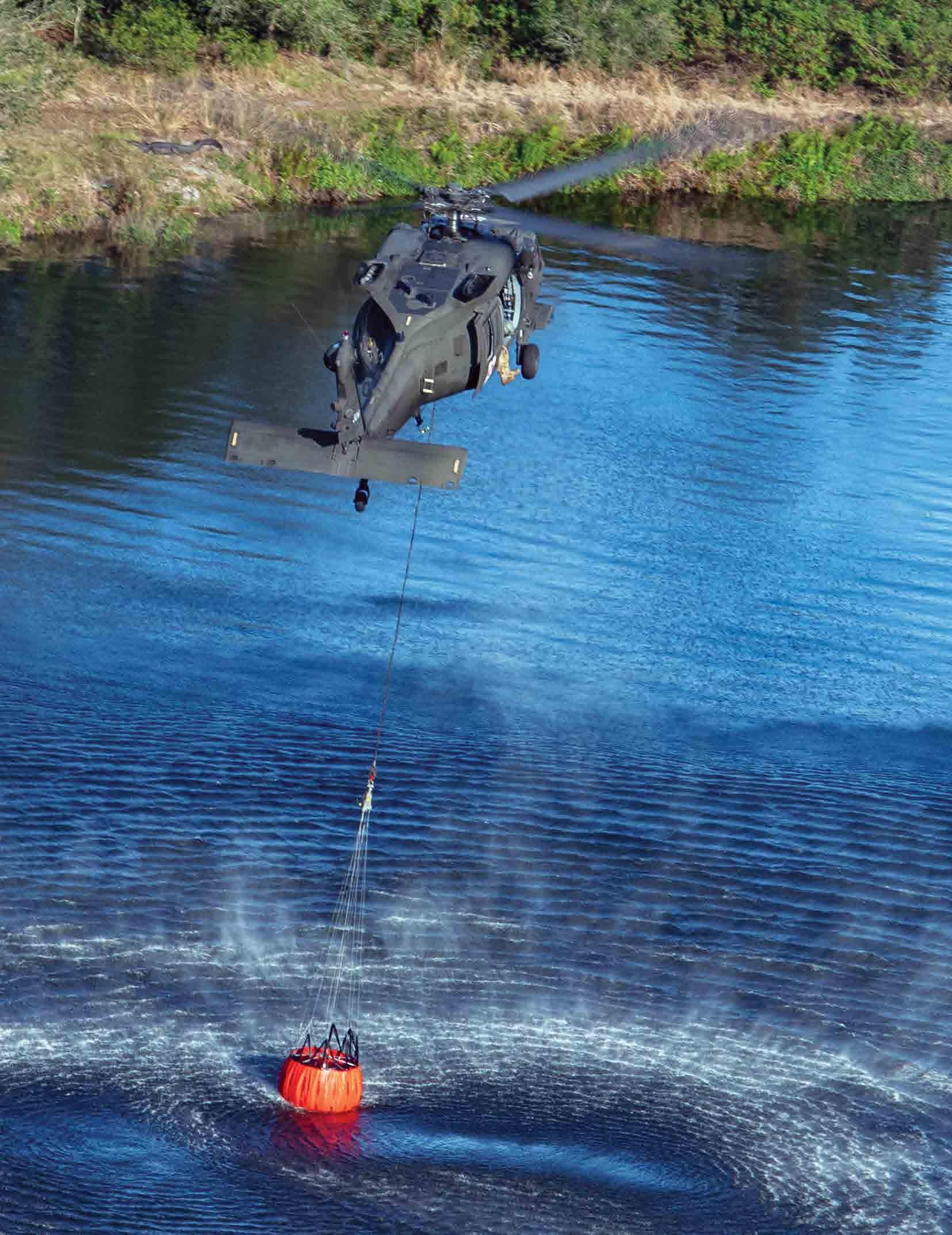 The National Guard is a major user of various types of Bambi Buckets for firefighting assistance around the country.
The National Guard is a major user of various types of Bambi Buckets for firefighting assistance around the country.
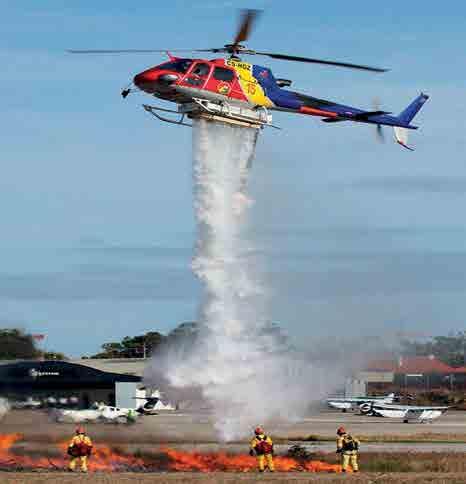






In addition to its use in fighting wildfires, the Bambi Bucket has also proven valuable in other applications. It has been used to provide drinking water to communities affected by natural disasters and to help control oil spills.

SEI Industries continued to refine and improve the Bambi Bucket over the years, developing new models and sizes to meet the changing needs of its customers. In the 1990s, SEI Industries began incorporating advanced technology into the Bambi Bucket introducing the PowerFill technology which is one of the most sought after add-on accessories for the Bambi Bucket product line. During fire season, especially today, with extended drought conditions; many existing natural water sources, such as rivers, creeks, stream beds and alpine meadows are too shallow to use.
PowerFill technology allows users to fill their aerial firefighting buckets in shallow water sources where dry summer conditions limit dip site possibilities. Only 18 inches (46 cm) of water is required to pull water from the bottom up. Conventional dipping methods may also still be used when the PowerFill is installed.
With the quick connection system or the original bolt-on system, the PowerFill Snorkel can be installed in the field, by one person in a matter of minutes. The PowerFill Snorkel is available in Bambi Bucket and Bambi MAX models ranging between 216 US gallon to 425 US gallon (820 L to 1,600 L) sizes.
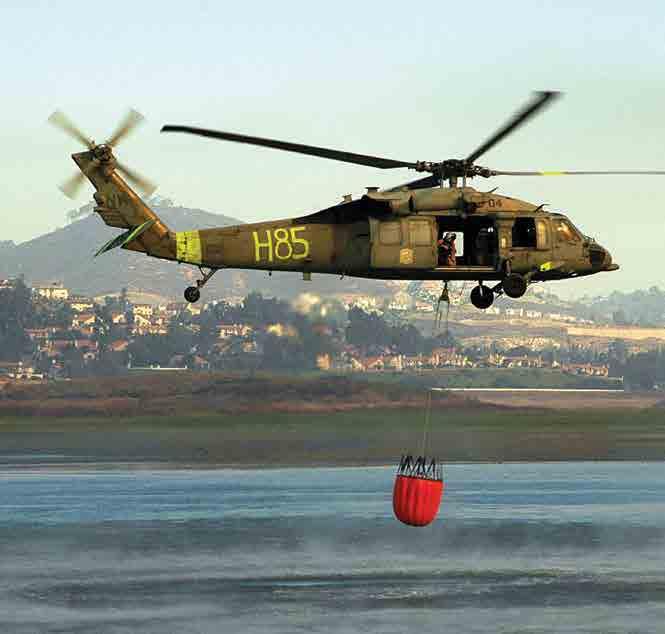
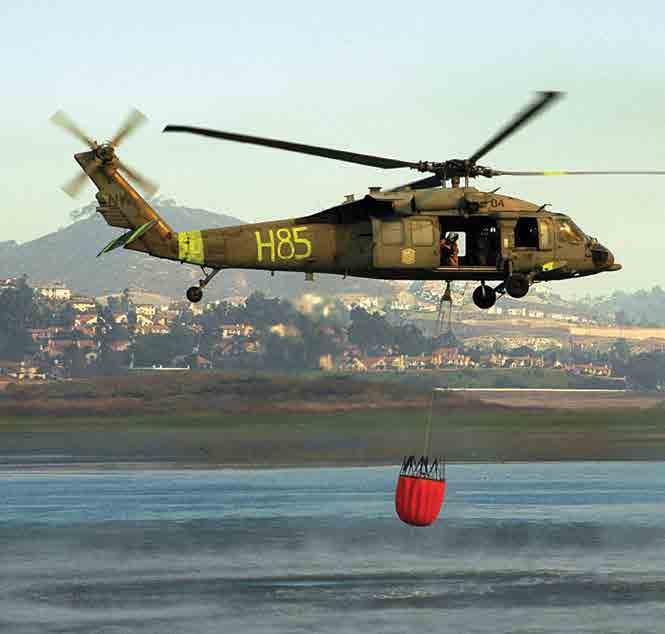
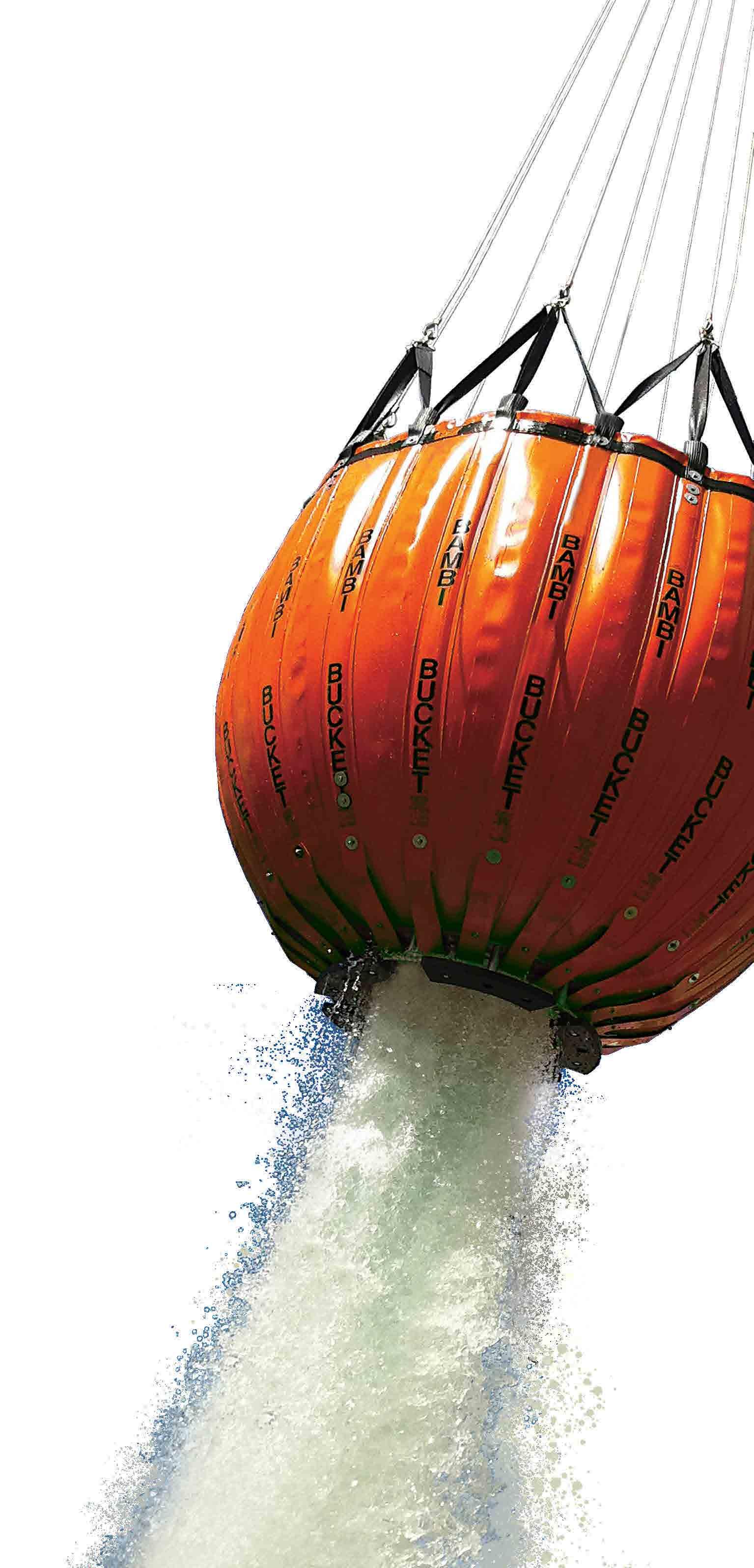
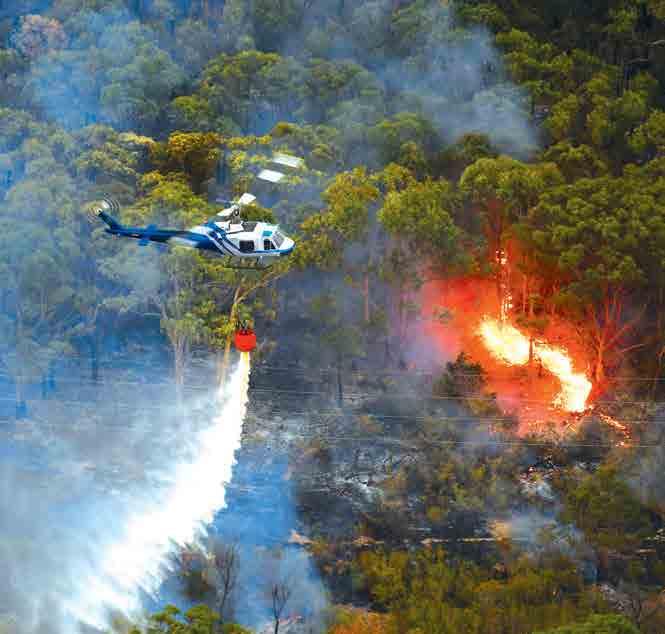




Over the next few decades, SEI Industries pioneered several new product lines, including the Torrentula and Bambi MAX Buckets with multi-drop capabilities with a broad range of sizes, ranging from a 180-gallon (680 liter) to 2590-gallon (9800 liter). The Bambi MAX Bucket is available with a 2-pump, or 4-pump PowerFill, internal configuration with bottom filling technology that provides fill rates of 850 or 1,700 US gallons per minute, respectively.
SEI Industries also added features to make the Bambi Bucket more durable and reliable, and accessories fitted with a 37-gallon (140 liter) foam injection system that aids dispersion by adding a detergent agent to assist with coverage.
These enhancements helped the Bambi Bucket withstand the rigors of aerial firefighting and made it more dependable

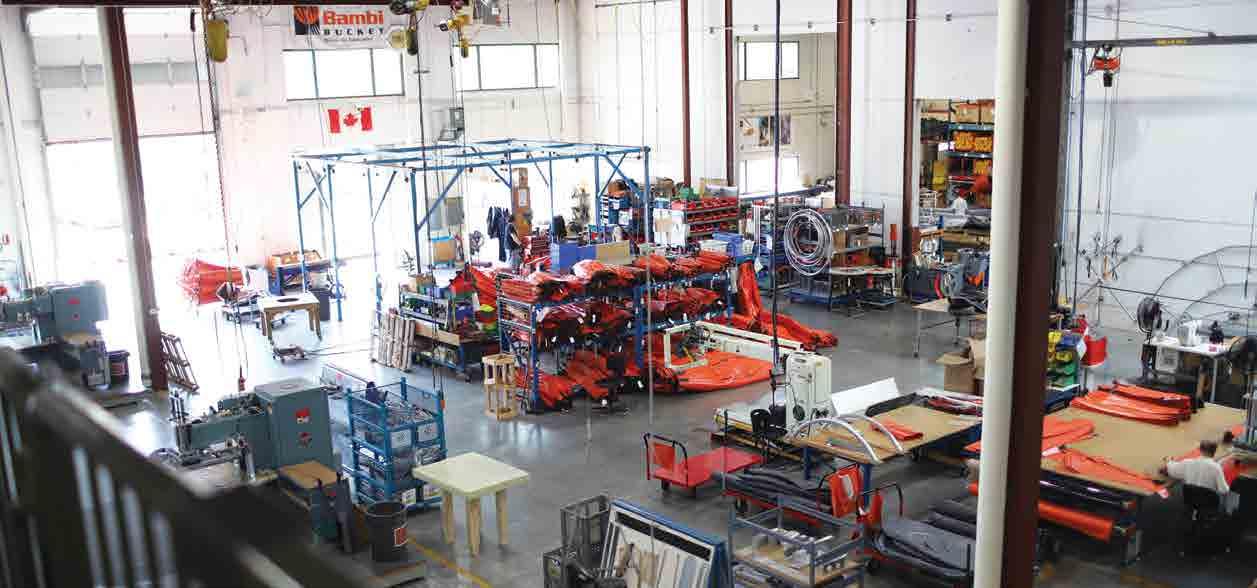
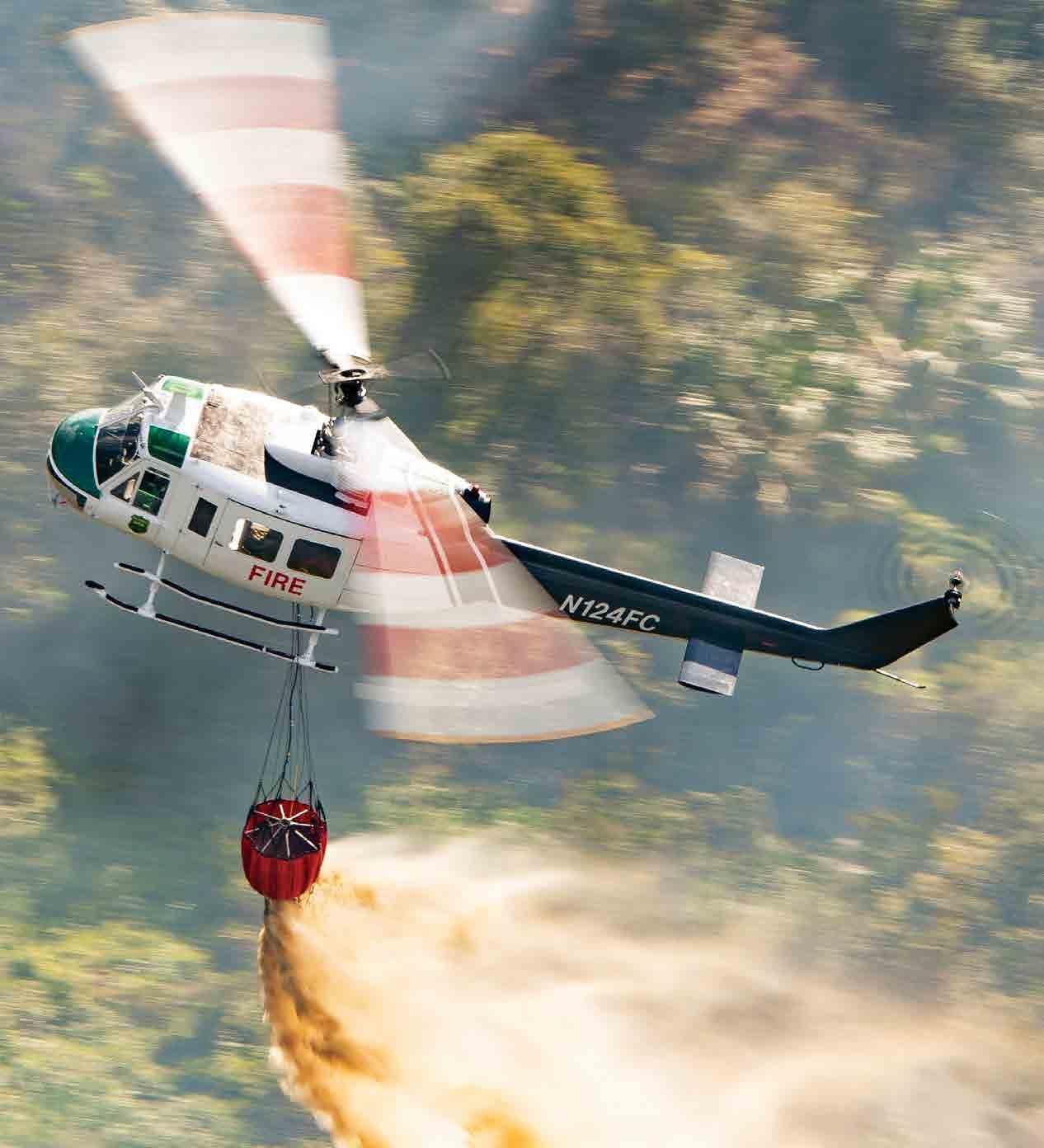
in the field. In addition to its use in fighting wildfires, the Bambi Bucket has also been used in other emergency situations such as oil spills containment by dropping a special absorbent material onto the water’s surface, relocation of fish from one location to another, and even saved a life directly with the bucket by aiding in the rescue of a woman from a rooftop who was trying to escape floodwaters who climbed into a bucket right before her house was swept away below.
As the Bambi Bucket is in its 40th year in operation, it continues to be a vital tool for firefighters worldwide. Its versatility and effectiveness have made it a go-to for aerial firefighting, and it remains an important part of SEI Industries’ product line. The Bambi Bucket is a testament to the ingenuity and determination of its creators and a valuable resource for those who rely on it to keep communities safe.
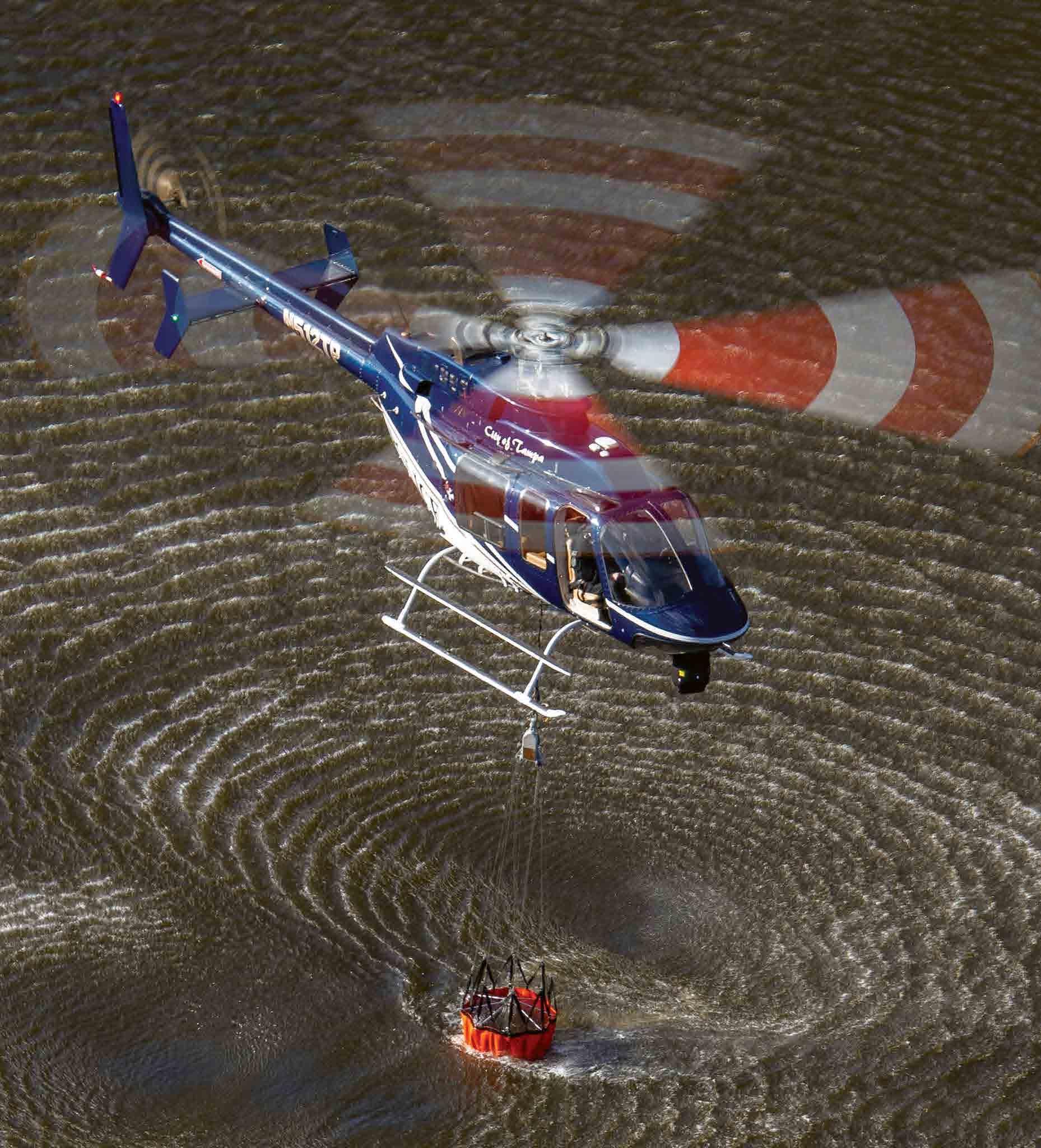
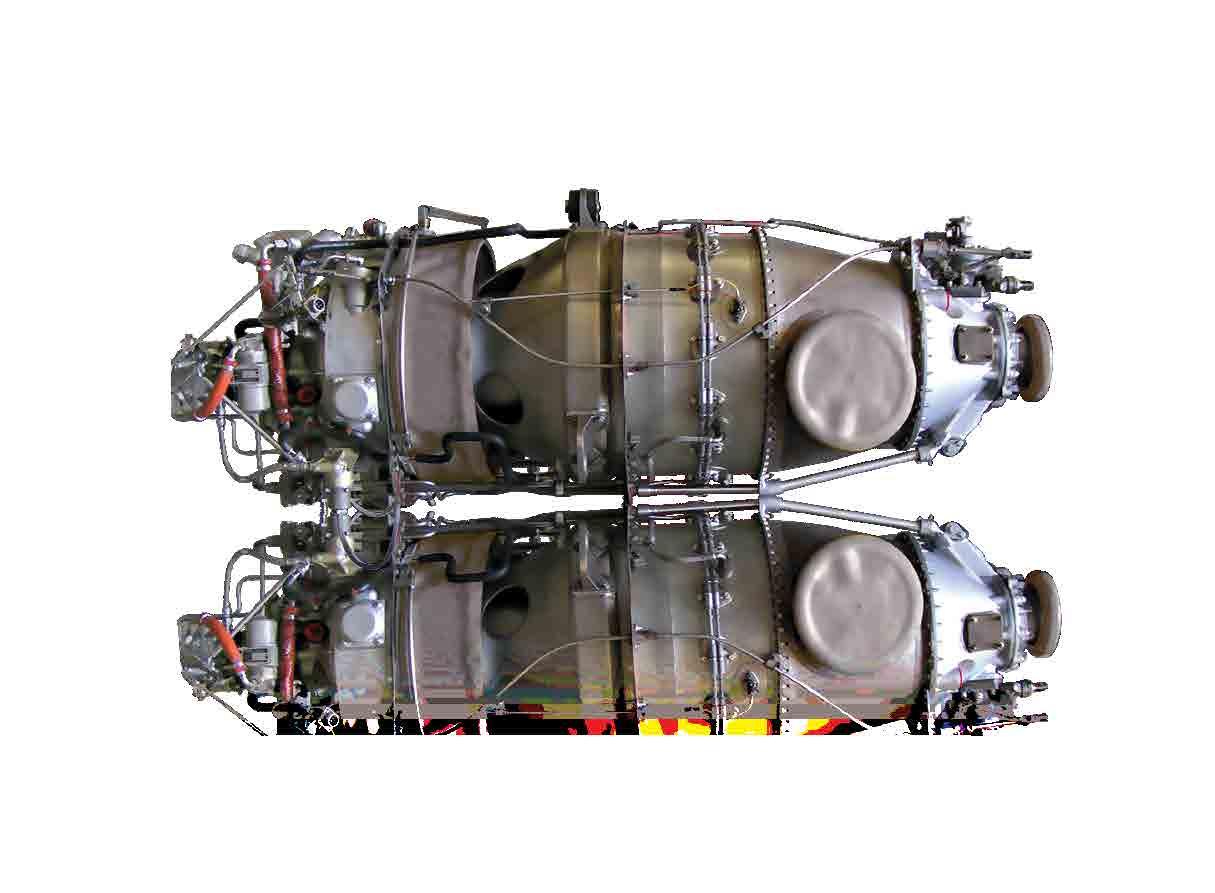
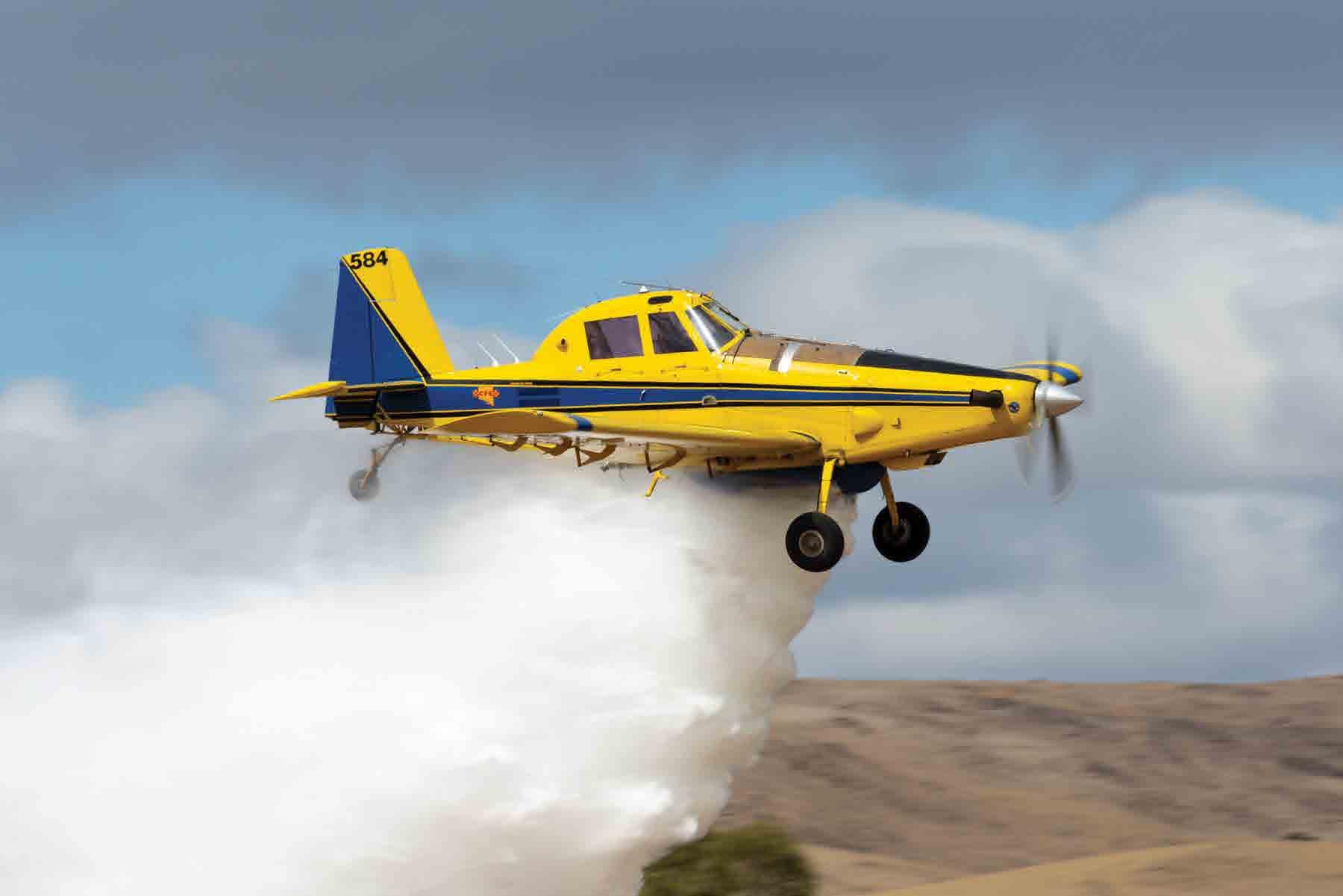
AIR TRACTOR DELIVERS THE PERFORMANCE, EFFICIENCY, AND PRECISION THIS JOB DEMANDS. IT’S TIME YOU DEMAND MORE.






